A first-time guide to Svalbard

Jul 13, 2024 • 10 min read

Visiting Svalbard is a proper Arctic adventure.
Your first visit to Svalbard may seem a bit daunting – located midway between Norway and the North Pole, this remote Norwegian island is a land of extreme climate, glaciers and polar bears. This, combined with Svalbard's unique laws, can make it feel far removed from the rest of the world.
The Svalbard archipelago consists of three islands: Spitsbergen, Edgeøya and Nordaustlandet. Most of the tourist activity takes place on Spitsbergen, centered around the settlement of Longyearbyen . Accommodation is limited to mostly traditional hotels, although a small number of hostel rooms and self-catering apartments are available near Longyearbyen.
Here's what you need to know about visiting Svalbard for the first time.

Why you should visit Svalbard
If you've ever dreamed of waking up to a view of glaciers glittering in a sun that never sets or dog-sledding under the northern lights, Svalbard is the destination for you. Accessible from mainland Norway, this archipelago retains a real sense of adventure, and its main town, Longyearbyen, is a frontier outpost poised on the edge of one of the harshest – and most awe-inspiring – wildernesses in the world.
If you're intrigued by the polar north, Svalbard should definitely be on your list – realistically, this is the farthest north most of us are ever likely to get. Wrap up and spend as much time as you can out in the wild landscape. Wildlife watching and glacier-spotting cruises or kayak trips are great in the summer, or opt for a hike with the proper safety precautions (remember, this is polar bear country). You can hop on a snowmobile or take a ride on a dog-sled at any time of year.
The wilderness and wildlife are the big draws, but there are some conventional sights to see, too. Unfortunately, you can't visit Svalbard's remarkable Global Seed Vault without special permission, so you'll have to make do with snapping a picture from afar. The fascinating Svalbard Museum is well worth a couple of hours of your time, with its displays on the life formerly led by whalers, trappers, seal and walrus hunters and miners.
For something a bit different, head to Svalbard Bryggeri , the northernmost brewery in the world. A tour with tastings costs 429 NOK, and you can book in advance. If you can't make it to the brewery, pick up some cans in a grocery store.

Do I need a visa for Svalbard?
You do not need a visa to travel to Svalbard specifically, though you'll likely pass through mainland Norway on your way, which does require a Norwegian visa .
Interestingly, you do not even need a visa to work here! If you are truly captivated by your trip and wish to move north, it's legal for anyone of any nationality to immigrate – you just need to acquire employment and housing prior to arriving.
How do I get to Svalbard?
Both Norwegian Air and SAS fly from Oslo to Longyearbyen, and between the two carriers, you'll be able to get a flight most days of the week. You can also get a flight from Tromsø – in fact, even if your flight says it is direct from Oslo, it may stop at Tromsø, and you'll have to disembark for passport control.
If you are connecting directly to Svalbard via Oslo airport, you should also check ahead to see if you need a Schengen visa for Norway, as Svalbard is not part of the Schengen area.

The best time to go to Svalbard
Most people visit Svalbard in the summer season (May to September). The snow starts to melt in May, making it easier to get around, and it's a busier time for tourism, with more flights from Oslo and more cruise ships docking at Longyearbyen.
This is also the best time of year for wildlife watching. Come in June, and you'll have a good chance of spotting walrus, polar bears and even whales on a cruise. You'll also be experiencing this under 24 hours of daylight until the end of August, when the sun begins to set again. Overall, it's an easier experience to visit during the warmer months.
That being said, Svalbard was made for adventurous travel, and some are drawn to its endless polar nights. The sun disappears entirely from the end of October to February, but that doesn't mean that Svalbard comes to a standstill – you can still enjoy activities such as snowmobiling and dog sledding, and there's a good chance of spotting the northern lights. Just be sure to pack for the conditions – winter temperatures can drop as low as −20°C (−4°F).
Is it easy to get around Svalbard?
Public transport is almost non-existent in Svalbard, with the exception of the shuttle bus to Longyearbyen from the airport. The journey takes just minutes, and the bus is timed to coincide with all arrivals and departures and will drop you straight to your accommodation. A return ticket costs 170 NOK.
If you leave Longyearbyen, you'll probably be with a tour guide. Most visitors explore the area outside town on guided excursions, which often include transfers to and from your accommodation. These tours can take you to ice caves, fjords and the active mining settlement of Barentsburg to see the industry that shaped Svalbard. There are also northern lights tours in winter.
Arctic Autorent is the biggest car rental company in Svalbard, and it has an office at the airport. You can book ahead online , and prices start from 1090 NOK a day. However, you should note that roads are limited once you leave Longyearbyen; you will not be able to get to other settlements like Barentsburg or Ny-Ålesund by car. There are also two taxi services in town; call ahead and book if you want to get a lift somewhere.
The most common form of transport you'll see in Svalbard is the snowmobile; one (or two!) of these vehicles are parked outside practically every home. Plenty of tour operators can arrange a rented snowmobile if you'd like to drive one yourself (electric models are often available).
Don't let the Arctic weather stop you from exploring Longyearbyen on foot – the locals don't! Crampons for your shoes will make this an easier endeavor.

Safety precautions when leaving Longyearbyen
As you approach the town limits of Longyearbyen, you'll notice striking road signs with a polar bear on them. Go past these signs, and you'll be required to take safety precautions in case you encounter a polar bear.
At the very minimum, you should have equipment that will scare off polar bears, such as a flare gun with multiple flares. However, a rifle – and the necessary firearms safety experience – is safer still. If you're leaving on an organized excursion, you won't need to worry about safety protocols, as your guide will have all the necessary equipment.
It's always wise to have a professional guide with you whenever you leave the town limits. If you are planning to travel independently, you'll need to familiarize yourself with the extensive safety precautions and regulations from the Governor's office far in advance. Ensure that you bring or rent all the necessary equipment, including an emergency beacon, map and compass – and that you have the skills to use them. You also need to alert the Governor's office of your trip beforehand.
Bring your good socks!
Leave your worn, tired socks at home, because in Svalbard, your shoeless feet will be on show…a lot! Svalbard was dominated by coal mining for a long time, and workers were required to leave their boots at the door to avoid bringing the black dust inside. Coal mining is dwindling on the islands but the tradition remains; you'll be required to remove your shoes in your accommodation and in restaurants and bars (though not in shops).
Most accommodation places provide you with slippers, but you might want to bring your own for comfort. At the very least, bring decent, warm socks.

How to keep well in Svalbard
If you're coming from somewhere with a more temperate climate, conditions in Svalbard can feel extreme, even in the summer. You might experience some sleep disruption – it can be difficult to wind down in 24-hour daylight and tough to wake up at the right time in the constant darkness of winter.
Unless you're visiting at the very height of summer – when temperatures can reach a balmy 10°C (50°F) – it will likely be very, very cold. A heavy-duty moisturizer and lip balm will help protect your skin from getting too dry. Carry some Vaseline and apply a thin layer just inside your nostrils to protect your sinuses from the sudden change to cold, dry air.
For the summer, a good eye mask is essential, and a medicinal supplement such as melatonin may help you drift off to sleep at the right time. Try to maintain a good sleep routine, and close those black-out curtains for a couple of hours before attempting to sleep. If shuteye eludes you, don't worry – the sun will probably give you enough energy during the day to make it through your activities, even if everything seems difficult when you first get up.
How to protect the landscape in Svalbard while you explore
Although you should be careful when traveling through any natural landscape, even stricter rules apply in Svalbard due to the fragile nature of the High Arctic environment. Don't disturb the birds or other animals, and familiarize yourself with the no-go areas for vehicles and snowmobiles if you are traveling independently. It's prohibited to actively bait or pursue polar bears, both for their safety and your own. Rabies is also a risk; the disease can be carried by reindeer and Arctic foxes.
If you visit Svalbard in the summer, don't pick the flowers. And, of course, don't leave any evidence of your trip behind in the form of litter or other waste.

What to pack for the Svalbard weather
Here's a packing list to make sure you're prepared for all the Svalbard adventures you can handle.
- Long wool underwear
- Wool socks and gloves
- Fleece layer
- Outer wind-proof layer
- Waterproof boots
- Comfortable indoor clothes for your hotel
- A camera with a long lens
There are some extra seasonal items you'll need, too. For winter, bring a down jacket, crampons for your shoes, a headlamp and a reflective vest. For summer, bring high-factor sunscreen, good-quality sunglasses and an eye mask.

How much money do I need in Svalbard?
As most visitors pack their days with costly excursions, Svalbard isn't a cheap destination to visit. However, unless you're planning on taking a hardcore, multi-day trek across the archipelago, you can experience the highlights in a short trip of two to three days.
For day-to-day living, Svalbard has the same high prices as other Scandinavian destinations. All food has to be imported, which increases the cost of meals and provisions, but this is offset slightly by the fact there is no VAT in Svalbard. In fact, if you need to stock up on outdoor gear or clothing, it will probably be cheaper to get it here than in mainland Norway.
Average daily costs in Svalbard:
- Hostel room – 1000–1900 NOK
- Basic room for two – 1900–3100 NOK
- Self-catering apartment (including Airbnb) - 1500–3000 NOK
- Coffee – 40 NOK
- Dinner for two – from 300 NOK for pizza to 900 NOK for steaks
- A pint of beer at the bar – 80 NOK
Keep planning your trip to Norway:
Plan the vacation of a lifetime with the best things to do in Norway Navigate Norways fjords and islands with this handy guide What you need to know about chasing the northern lights
AnneMarie traveled to Svalbard at the invitation of Volvo Penta. Lonely Planet staff members do not accept freebies in exchange for positive coverage.
This article was first published Sep 15, 2022 and updated Jul 13, 2024.
Explore related stories

Mar 14, 2024 • 16 min read
Experience some of Europe's best wildlife, nature and landscapes this summer at these national parks.

Jun 14, 2023 • 4 min read

Jun 30, 2020 • 7 min read

Dec 16, 2019 • 5 min read

Aug 27, 2024 • 6 min read

Aug 6, 2024 • 7 min read

Jun 27, 2024 • 10 min read

Jun 17, 2024 • 12 min read

Mar 21, 2024 • 6 min read

Mar 20, 2024 • 8 min read

Visiting Svalbard: the ultimate guide
Halfway between the Norwegian mainland and the North Pole, Svalbard is like another world. And it’s not just the wild landscapes that make this frozen archipelago so special; it’s very remote and very expensive to visit.
But despite the significant costs involved and the time it takes to get there, Svalbard is 100% worth a visit. The scenery is spellbinding, and the islands offer you the chance to enjoy experiences that few other destinations can offer. Now how about watching the northern lights at noon, or trying to photograph wild polar bears? Get started with our guide.
When to visit Getting there Where to stay What to see and do Recommended tours Budgeting for a trip to Svalbard
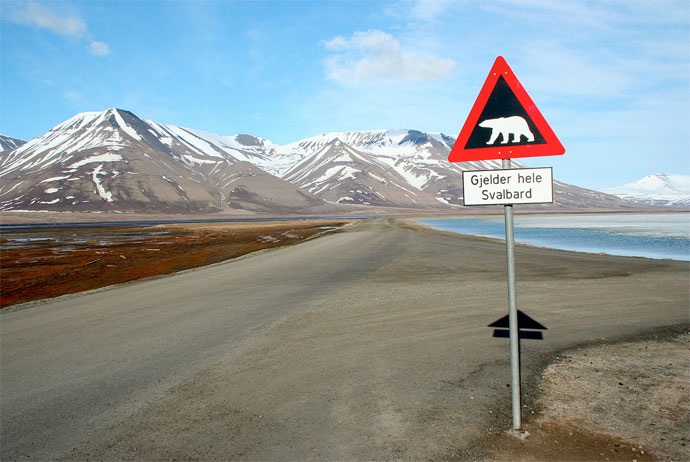
When to visit
If you want to see as much of Svalbard as possible, you should visit between May and August. Thanks to the midnight sun you’ll have 24 hours of daylight, making it the ideal time to visit if you’ve only got two or three days. Obviously, you’ll need to pick a hotel with good blackout blinds.
If you’re brave enough to face frigid temperatures that regularly sink below -20C, and it’s your dream to see the northern lights, you consider visiting between October and March, when darkness rules and the islands take on an even wilder and more mysterious aura.
Getting there
Svalbard looks isolated on the map, but it’s actually served by direct flights from Oslo and Tromsø (try airlines SAS or Norwegian). Svalbard Airport – the world’s northernmost to be served by commercial flights – is located on the main island of Spitsbergen.
Airport buses (around 75 NOK) wait for planes to land and shuttle people into Longyearbyen once they’ve had a chance to grab their bags. Just tell the driver where you’re staying and they’ll usually be able to stop there for you.
Note that there are no direct international flights to Svalbard. Depending on where you’re coming from, you might need a Schengen transit visa for the stopover; even though Svalbard itself is a visa-free zone, Oslo and Tromsø aren’t.
If you don’t like the idea of flying, another (expensive) option is to join one of the Hurtigruten cruises that visit Svalbard ( details here ).
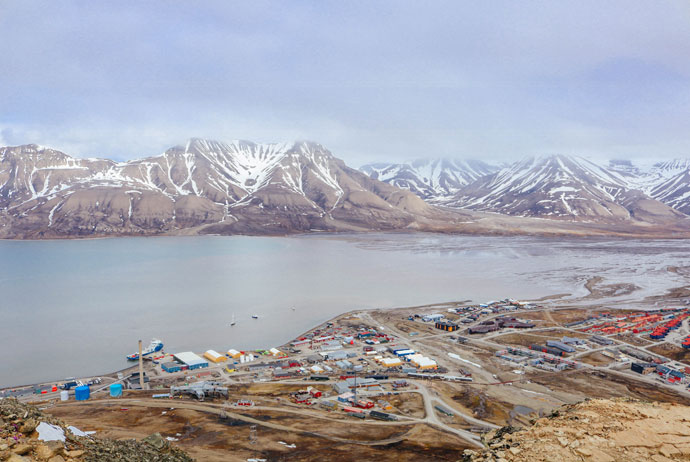
Where to stay
While there are other small villages in the archipelago like Barentsburg and Ny-Ålesund, Longyearbyen is really the main hub on Svalbard the best place to bed down – it’s home to the archipelago’s airport and most of its hotels.
Among the cheapest places to stay in Longyearbyen are Gjestehuset 102 and the Coal Miner’s Cabins – both of these hostels are situated towards the south town in so-called Nybyen. From here it’s a 30-minute walk north to the centre of town, however transfers for any excursions you’re going on can usually be arranged. What’s more, the bus from the airport also stops here so the location isn’t too much of an inconvenience.
More central hotels include Mary Ann’s Polarrigg . This rustic place is the quirkiest option in town, occupying a converted barracks that used to house miners. Nearby is the more exclusive (read: pricey) Radisson Blu , while slightly further south is Basecamp Hotel , a traditional trapper’s hotel.
What to see and do
The town of Longyearbyen has a few museums and pubs to offer, but the real joy of visiting Svalbard is to experience some nice outdoorsy adventures, away from built-up areas. There are plenty of organised excursions to choose from – keep in mind that you should not venture outside of Longyearbyen on your own (polar bears roam the area).
Guided tours and activities will almost certainly use up a significant portion of your budget for Svalbard. Unfortunately these are the only way to safely experience the wilderness of Svalbard – shop around for the best deals, or ask at your accommodation. Here are some of the highlights:
Visit Pyramiden and Barentsburg
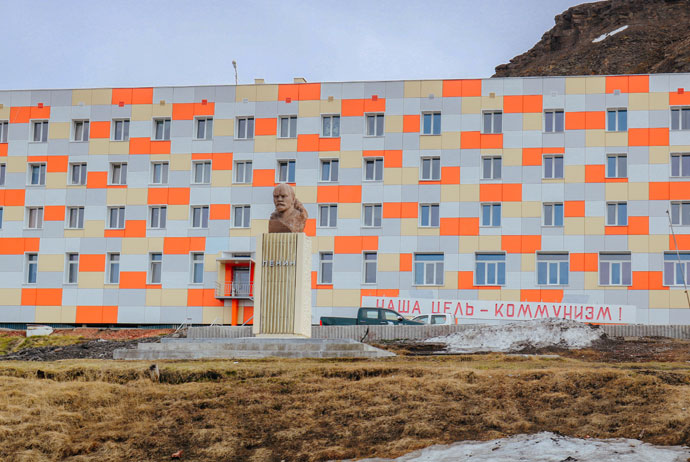
North of Longyearbyen, the old Soviet-era mining settlement known as Pyramiden is long-since abandoned, but you’re still allowed to visit and even have a look inside the old buildings – or take a selfie with the world’s northernmost Lenin statue, if you fancy it.
Barentsburg, another Russian mining town, is still inhabited by ca. 500 people, and you can wander around town to admire its pretty street art. During the summer, both places can be visited by boat from Longyearbyen in summer.
Explore the mountains (and glaciers) around Longyearbyen
If you’re fit enough and the weather is warm enough (summer only), you can go on a guided hike in the mountains close to Longyearbyen. Even if it’s mild, the chances are that there will still be plenty of snow around and you might even get to visit an ice cave. There are several operators and tours to choose from, and each hike guarantees you stunning views back over Longyearbyen.
Be a musher for a day
In Svalbard, unlike most other places in mainland Norway, you can try dog sledding in winter and summer. Whether you’d like to cruise around on snow or gravel, dog sledding is a real must-do when visiting Svalbard.
Go on a snowmobile adventure
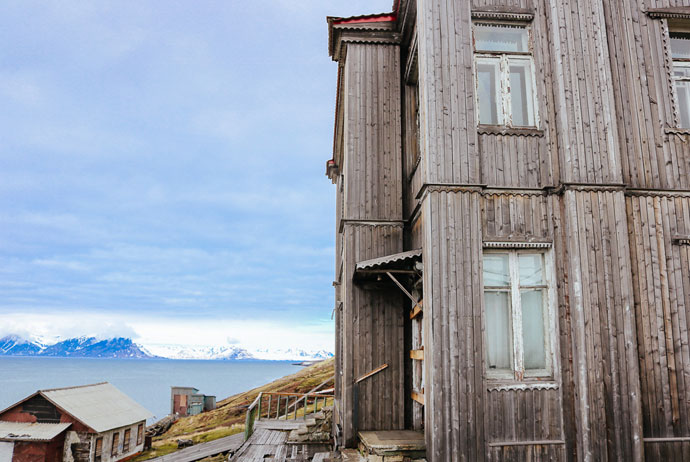
If you do visit during the long and cold winter, you’ll quickly notice that the locals have one preferred way of getting around: the snowmobile. There are dozens of tours for visitors to choose from, and some of them even lead you to Barentsburg. Ask at your hotel or hostel.
Recommended tours in Svalbard
If you’re visiting Svalbard you’ll want to take at least one guided tour. Travelling with an experienced local opens up parts of the archipelago that are too dangerous to explore alone, or otherwise off limits.
This two-day tour gives you a great introduction to the islands. It begins with a beautiful boat ride and takes you to some of Svalbard’s main tourist sights (including Pyramiden) and gives you the chance to brush up on your landscape photography skills.
If you’re visiting Svalbard for the nature, this one-day hiking and birdwatching tour is another good option. It departs from Longyearbyen, stopping at areas known for their Arctic foxes, nesting birds and wild reindeer.
Keen snappers might prefer this one-day photography trip , which takes you to some spectacular lookouts with views over Longyearbyen and the glaciers.
Budgeting for a trip to Svalbard
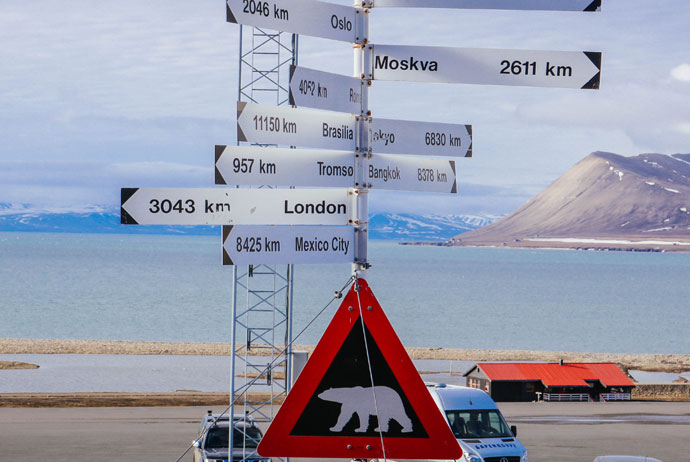
As you can imagine, visiting Svalbard is not a cheap undertaking. It’s tricky for us to suggest a daily budget, as so much depends on what you want to see when you arrive.
A simple but clean hostel will cost you around 1200 NOK a night – that’s as much as a fairly decent hotel on the mainland. Hotels on Svalbard are significantly more expensive.
Due to the danger of polar bear encounters and the lack of public transport (or car rentals), the only way to really experience Svalbard is by booking a guided tour – which can cost anything between 500 to 3000 NOK or more per day, depending on what kind of adventure you’re looking for.
One sure-fire way to save a few kroner is by preparing meals yourself. Booze is tax-free in Svalbard, which makes for relatively cheap drinking (compared with the rest of Norway, anyway). All hostels have a communal kitchen for you to cook in, and there are also some decent listings on Airbnb providing kitchen access (you can get money off your first stay with this link ). Don’t expect Airbnb to be a bargain, though – rentals are limited and prices seem to change with demand.
One final tip: if you’ve accrued a few SAS bonus points on your travels around Scandinavia, you can use them to get to Svalbard quite cheaply – a return flight from Oslo is still considered a domestic journey and comes in at 10,000 points. Otherwise, look out for sales over at Norwegian.
What to see, do and eat in Tromsø
You may also like.
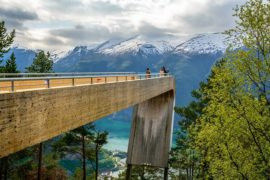
Norway’s scenic routes
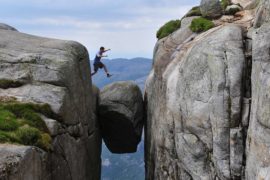
The 15 best places to visit in Norway
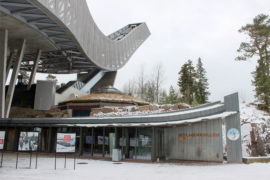
Where to go skiing in Oslo (and nearby)
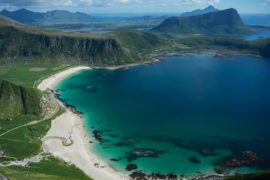
12 of the best things to do in Norway’s Lofoten Islands
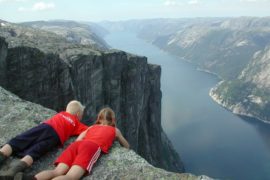
Where you should stay in Norway to visit the fjords
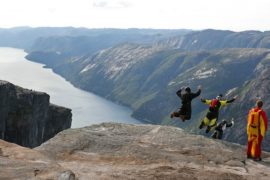
Extreme sports in Norway: everything you need to know
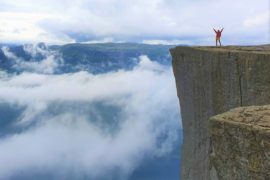
Hiking to Pulpit Rock
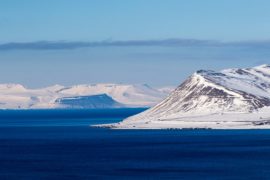
The 30 best things to do in Norway
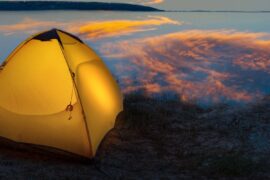
Camping in Norway: the ultimate guide
whats the point in the 11000 km signs
So people know how far away their home is from Longyearbyen. The 11000 km sign is for Brazil 🙂

15 Best Things to do in Svalbard
By: Author Swedish Nomad
Posted on Last updated: September 25, 2020
Categories Norway
Home / Europe / Norway / 15 Best Things to do in Svalbard

Here’s a list of the 15 best things to do in Svalbard ( Norway ), along with famous landmarks, museums, and other points of interest.
Svalbard is an arctic archipelago, located between the North Pole and Norway. The largest three islands are Spitsbergen, Nordaustlandet, and Edgeøya. Svalbard is part of the Kingdom of Norway, where it forms an unincorporated area.
Longyearbyen is the main city, which is also where international tourists arrive in Svalbard. It’s a breeding ground for many arctic animals, including polar bears, arctic foxes, and reindeers. Some of the marine animals include whales, seals, and walruses.
In this article, I’m sharing some of the best places to visit in Svalbard as well as attractions and activities that shouldn’t be missed while visiting.
See the polar bears
Roughly 3,000 polar bears are living in Svalbard, which also means that they outnumber humans. With that said, seeing wild polar bears is not something that occurs on a daily basis.
The best chance of seeing a wild polar bear is by joining one of the polar bear tours that are available from May to September, which is when the ice has melted, allowing ships to navigate the waters.
There are no land-based polar bear excursions, and I recommend booking a tour with Oceanwide Expeditions, which has several cruise options that are sustainable and affordable.

Explore an Ice Cave
There are several ice caves in proximity to Longyearbyen, and exploring them is quite an experience. When entering these glaciers, it’s like you’re walking inside a different world, made of ice.
The ice caves have been shaped by the melting ice and snow which are later re-frozen as winter comes. Although it’s interesting to discover the kingdom of ice and glacier, it’s also important to note that you need at least moderate fitness to explore the ice caves of Svalbard.

Go kayaking
Kayaking is a great way to have a close-up experience with the Arctic nature. Few activities in the world are as peaceful and exciting as kayaking on a fjord in Svalbard.
There are several tours that offer kayaking combined with guided walks to interesting places, such as Hiorthhamn, which is an old settlement that has been abandoned.

Svalbard museum
Svalbard Museum is located in Longyearbyen and can be found in the basement of the University Center, which is the northernmost university in the world!
The museum is quite interesting if you’re curious to learn more about Svalbard. The exhibitions on display will teach you more about the archipelago’s flora and fauna as well as how the first arctic explorers used to live.
Magdalenefjord
Magdalenefjord is a scenic fjord that was first discovered by Willem Barents. In the 17th century, English whalers came here and established a whaling station.
In modern times, it has become one of the most famous places to visit in Svalbard, known for its spectacular glaciers and iconic mountain peaks. Since 2015 and onwards, ships that carry heavy fuel are no longer allowed, which is great so that the area can be preserved and explored sustainably.
Gravneset is perhaps the most famous site among tourists, known for its arctic beach with panoramic views. There are several smaller tours that include a stop at Gravneset and the Magdalenefjord, which is also a popular place to go kayaking.

Barentsburg
Barentsburg was one of the main coal-mining settlements in Svalbard. It was originally built as a mining town by the Dutch, although it was sold a few years later to the Soviet Union, which continued with coal mining.
At most, some 1500 people were living and working here permanently. Nowadays, Barentsburg is home to around 450 people and remains as one of the main attractions in Svalbard. There are guided tours that will take you here, but it’s also possible to travel here on your own.

Pyramiden is another fascinating place to visit, at least if you find it interesting to visit a ghost town. This is a former coal-mining town that was built by Russia, where some 1000 people used to live.
It’s quite a peculiar place as it was left abruptly back in 1998 when the mine was shut down. It has been left more or less like it were more than 20 years ago, and you can still find old skis, cups, and even old newspapers when walking around.
It has also been named as one of the best ghost towns in the world, by National Geographic, making it one of the best places to visit in Svalbard for a unique experience.

Hike to Sarkofagen
One of the unique and most impressive sights you’ll see when you first arrive in Longyearbyen are the mountain ranges which cover large parts of Svalbard.
Surrounded by magnificent views and the unique Arctic landscape in all directions, a hike to Sarkofagen is definitely something not to be missed.
The moraine landscape here is more like a moonscape than the mountains you might have seen elsewhere in Norway. If you are lucky enough, you can also stumble over 60-million-year-old fossils on your way!

Svalbard Kirke
In Svalbard, you can visit the northernmost church in the world, namely Svalbard Kirke, which is also the archipelago’s only church, except the Russian chapel that can be found in Barentsburg.
Compared to other churches in Europe, I wouldn’t claim it to be something extraordinary, but it’s still quite impressive that they have built a church this far north. During wintertime, visitors can enjoy hot beverages and waffles at the cafe.

Global Seed Vault
If a global disaster strikes and all crops around the world are wiped out, the Global Seed Vault is built to be our savior. It also goes by the name of “The Doomsday Vault” and it holds seeds from over 930,000 crop varieties.
They are permanently stored here, deep below the permafrost. It’s located about 4 kilometers from the center of Longyearbyen. Outside visitors are not allowed without permission, but it’s still cool to see the entrance in person, and knowing what’s beneath the ground.

Svalbard Brewery
Svalbard has a total of two breweries, one located in Longyearbyen and the other brewery in Barentsburg. What makes them special is the fact that they are brewing beer with glacier water.
As the two northernmost breweries in the world, every beer-lover should come here. Visitors can follow along on a guided tour, and of course, also taste the locally brewed beers.
See the Northern Light/Midnight Sun
From May to September, the sun doesn’t set in Svalbard, known as Midnight sun, where you can enjoy the sunshine at night. And from November to January the opposite takes place, known as polar night.
To see the Northern lights in Svalbard, the best time of the year to come is during the polar night season. During this period, the sky is dark more or less day and night as the sun never rises, offering ideal conditions to view the phenomenon known as Aurora Borealis.

Snowmobile tour
Wintertime is prime time for a snowmobile tour in Svalbard as everything is frozen and covered by ice and snow. It’s also the best way of transportation, and more or less the only way to travel long distances on land during winter.
Their prevalence is further displayed by the road signs in Longyearbyen, which warns other drivers that the roads are frequently crossed by snowmobiles. Joining a snowmobile tour is one of the best things to do in Svalbard if you want a unique experience.
There are various excursions by snowmobile to choose from, especially if you’re visiting during wintertime. But even if you arrive in summertime, there are options to drive a snowmobile as well, on the Longyear Glacier.

Isfjord radio station
Back in the days, before satellite phones and fiber optic cables provided a connection with the mainland, the only form of communication was made from the Isfjord Radio Station. Nowadays, there’s a nice boutique hotel on the site where you can stay overnight.
Despite being remotely located, it’s quite a stylish hotel with great comfort. Spending a night or two at the old radio station is definitely recommended if you’re staying for several days on the arctic island. It’s definitely a unique hotel experience.
Explore Longyearbyen
Longyearbyen, the most northerly town, with the most northerly church, most northerly pub, and pretty much everything else, is located in the picturesque valley. Here, you can go for a stroll along with the postcard-perfect colorful houses with mountain views in the background.
It was named after John Munro Longyear, from the U.S, who initiated coal mining operations back in 1906. The permanent population is 2,368 according to the latest numbers, and there are around 350 students that are studying at the University Center.
A rather peculiar fact about Svalbard and Longyearbyen is the fact that it’s illegal to die here. Due to the frozen ground, human bodies aren’t being decomposed. With that said, there is actually a cemetery in Longyearbyen, that was constructed after 7 miners died from the Spanish flu in 1918.

Museums in Svalbard
Despite its remoteness and small population, there are actually three museums in Svalbard, including an art gallery. The North Pole Expedition is very interesting and with a focus on the importance of 3 airships. It was formerly named Spitsbergen Airship Museum.
Additionally, you can visit WildPhoto Gallery, which is run by two photographers named Ole Jørgen Liodden and Roy Mangersnes. They display their best images ever taken in Svalbard.
- Svalbard Art Gallery
- Svalbard Museum
- North Pole Expedition Museum
Festivals in Svalbard
If you want to visit some of the northernmost festivals in the world, there are several annual festivals in Svalbard.
- Polarjazz Festival
- Sun Festival
- Longyearbyen Literature Festival
- The beer Festival
- Taste Svalbard
- Dark Season Blues Festival
- Arctic Chamber Music Festival
Want more recommendations on things to do in Svalbard? Leave a comment below!
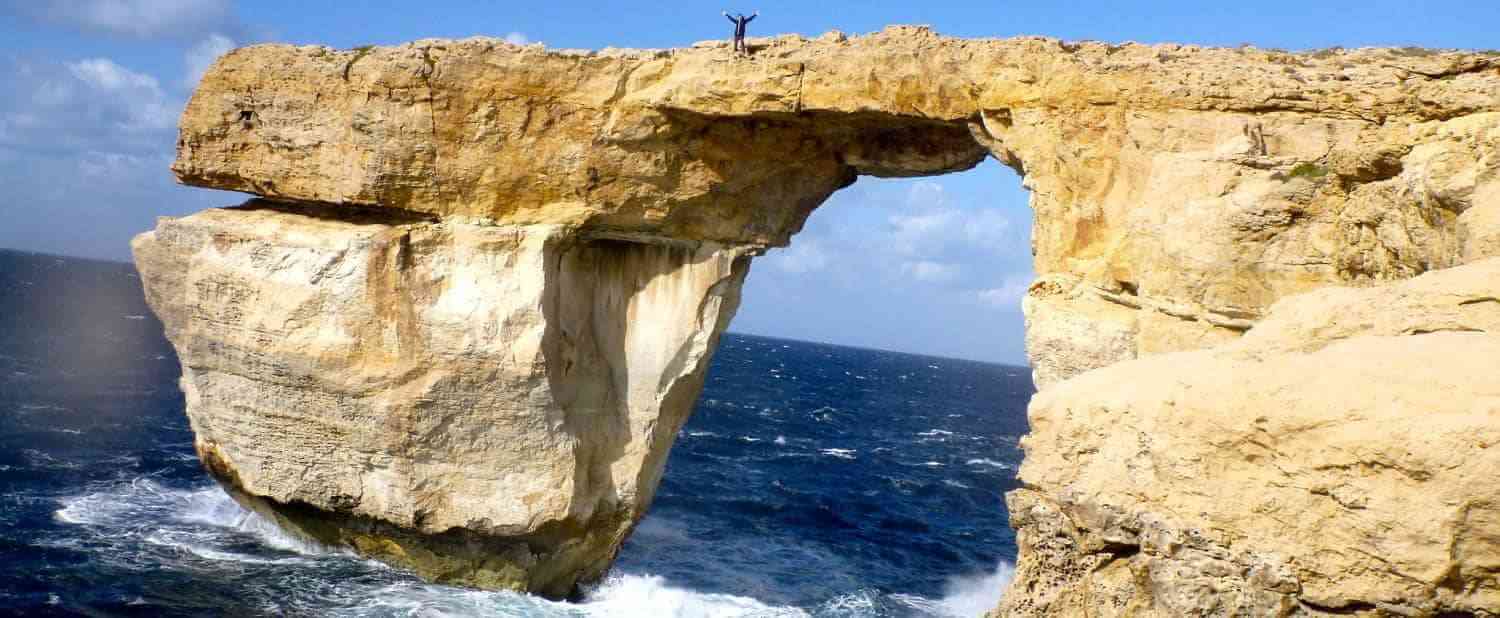
Out of Your Comfort Zone
The art of backpacking & adventures to get out of your comfort zone – tips and advice, ultimate guide to visiting svalbard, the arctic (even on a budget).
Last Updated on July 17, 2024 by Lohanna Reis
How to visit Svalbard, the northernmost place in the world that can actually be visited by tourists. Although a fairly expensive place, we give tips to save on accommodation, flights, transportation, excursions, and food. If you want to visit the Arctic the cheapest way possible, then this is as close as you can get!
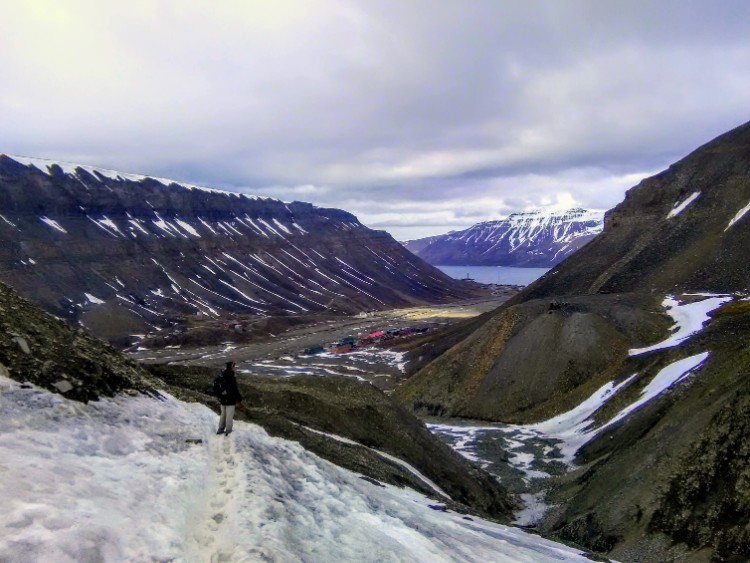
Picture a place that’s quite literally as far north as you can go (unless you somehow make it the North Pole) ….
To a place that’s home to….
….more polar bears (& snowmobiles) than people.
….bizarre, semi-abandoned Russian mining towns (featuring the world’s northernmost Lenin Statue).
….glaciers, ice caves, fjords, and pristine Arctic landscapes.
….the famed “ Doomsday Seed Vault .”
If this list hasn’t given you a hint, Svalbard is an incredible (though strange) place to visit.
After our trip there, we can easily say it’s one of the most unique, stunning places we’ve ever visited.
And, though you might not expect it, it’s surprisingly easy to get to! (All it takes is a 3-hour flight from Oslo, the capital of Norway)
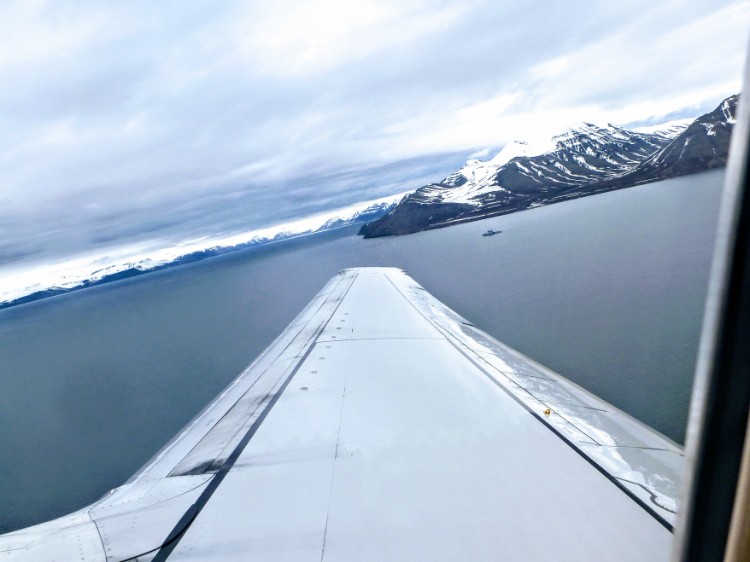
Table of Contents
- 1 Svalbard Fast Facts
- 2 How to Plan a Trip to Svalbard / Svalbard Trip Planning
- 3 Svalbard Accommodation
- 4 Svalbard Transportation
- 5 Svalbard food & drink
- 6 What to do in Svalbard/Svalbard Itineraries
- 7 How to work or study in Svalbard
- 8 Final tips for visiting Svalbard
- 9 Svalbard Attractions, Tours and Activities
- 10 Planning your next trip?
Svalbard Fast Facts
Where is Svalbard?
In quick terms, Svalbard is waaaaay the heck up there. It’s farther north than Iceland than the Arctic Circle, and than most of Russia and Greenland.
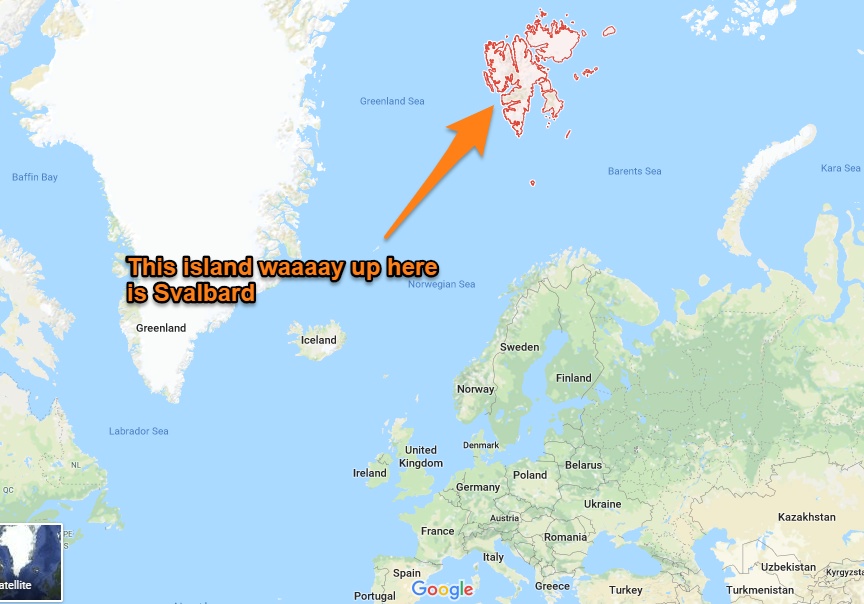
In other words, short of visiting the North Pole, you really can’t visit a place farther north. Especially if you want to visit a place where real humans (not just scientists and researchers) live.
In fact, Svalbard is the northernmost human settlement on our planet!
What is Svalbard?
Svalbard is a group of islands technically owned by Norway. Yet, they don’t operate as a traditional territory since people from any nation of the world can come here to live and work visa-free.
The islands are fairly large (23,561 square meters ) but are mostly uninhabited. The biggest city, the capital Longyearbyen, has just over 2,000 people.
Spitsbergen is the biggest island on Svalbard and is likely where you’ll be spending your visit (since the rest of the islands are so hard to get to).
What is Svalbard’s currency?
Since Svalbard is a part of Norway, they use the same Norwegian Krone as the mainland.
Who lives in Svalbard?
Since anyone can live and work in Svalbard visa-free, this isolated island is surprisingly diverse and is a place people from 50+ countries call home. Naturally, there are many Norwegians but there are also large groups of Russian, Ukrainian, Thai, Swedish, and German people.
What language do people in speak in Svalbard?
Officially, Norwegian. But as with the Norwegian mainland, everyone speaks English.
How to Plan a Trip to Svalbard / Svalbard Trip Planning
2.1) Do I need a visa to visit Svalbard?
Technically, anyone can visit, live, and work in Svalbard visa-free. The problem is that you’ll have to fly through mainland Norway to get there. And since the flight from mainland Norway to Svalbard isn’t considered an international flight , you’ll need to pass through Norwegian immigration control.
This means that, if you need a visa to get to Norway (or the Schengen zone), then you’ll also need one to cross into Svalbard.
Here is a list of countries that need a visa to enter Norway and thus Svalbard.
2.2) When to visit Svalbard?
This depends 100% on what you want to do while in Svalbard and how well you tolerate cold & the darkness.
We personally went at the beginning of June and found it to be a perfect time of year. It was warmish by Svalbard standards (around 30 degrees Fahrenheit or 0 degrees Celsius), yet we were lucky and still had some snow.
There was also 24 hours of daylight when we were there, and there weren’t too many tourists since it was still a few weeks before the high season began (meaning it was fairly easy for us to get into the tours we wanted too….and they also weren’t too full).
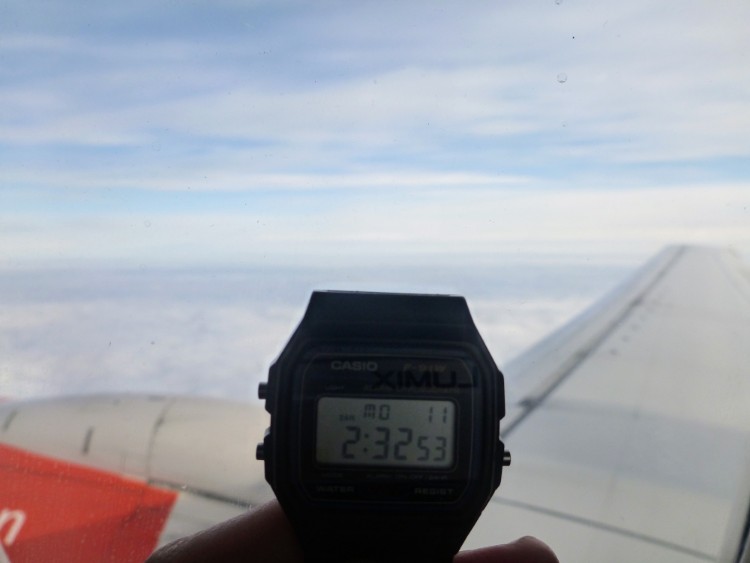
There’s still light even at 2:32 AM during Svalbard’s summer!
Note about going during summer high season: from about mid-June to August, there are now going to be a fair number of cruise ships docking in Svalbard. It might be worth confirming with the Svalbard tourist office what dates cruise ships are docking and then do your best to avoid them
There are pros and cons to visiting each part of the year.
If you’re really hardcore and can handle the cold and 24 hours of darkness, then going in the winter would give you a true Arctic experience. For example, we weren’t able to go snowmobiling because we visited Svalbard too late in the season.
However, we were able to take boat rides and see places where the water is too frozen to get to in the winter.
My recommendation is to check the Svalbard Activity Planner on the Svalbard Tourism website to get an idea of what activities you can do during each season and then decide based on that.

2.3) How long to stay in Svalbard?
We had 4 full days + the entire afternoon of the day our flight arrived. This was just about the right amount of time for us to visit/see/do what we wanted.
If we had stayed longer, we probably would have done an overnight trip that took us farther from Longyearbyen.
2.4) Is Svalbard expensive? Is it possible to visit Svalbard on a budget?
Yes and no.
Unfortunately, no matter what you do, Svalbard will never be a budget destination. Even if you choose the cheapest options for accommodation , transportation , and food (all of which we’ll talk about below), the costs of the excursions are what’s going to get you.
Basically, you’ll have to do an excursion almost every day you’re in Svalbard. This is because you can’t leave the town limits without a rifle due to the polar bear threat.
If you’re comfortable renting using a rifle in case of emergency, then you may be able to venture off a bit on your own (which we did for one day and talk about in day #3 of our 5-day itinerary below).
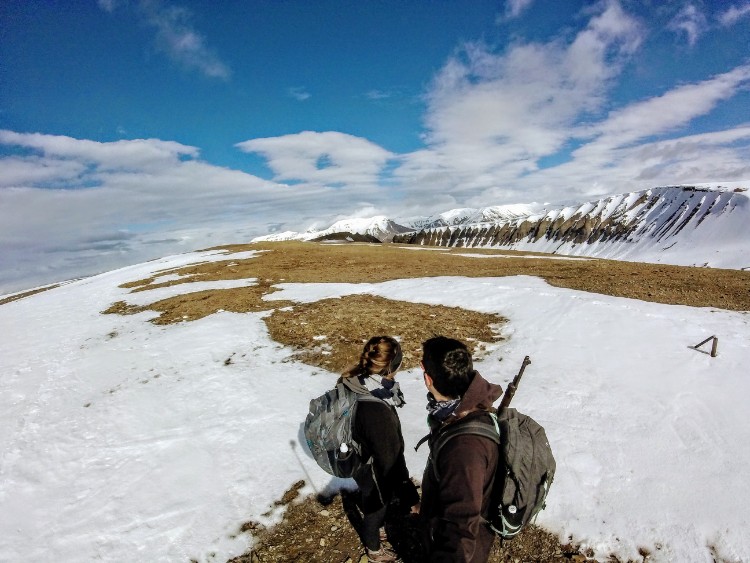
But even if you rent a rifle, you won’t be able to get very far on your own since Svalbard is so big.
In other words, it would be a bit silly for you to come all the way to Svalbard and skip the excursions (and thus miss out on the most incredible parts of the island) because of the cost.
2.5) What about the polar bears?
If there’s one thing people know about Svalbard, it’s the polar bears. And truly, this is something to take seriously.
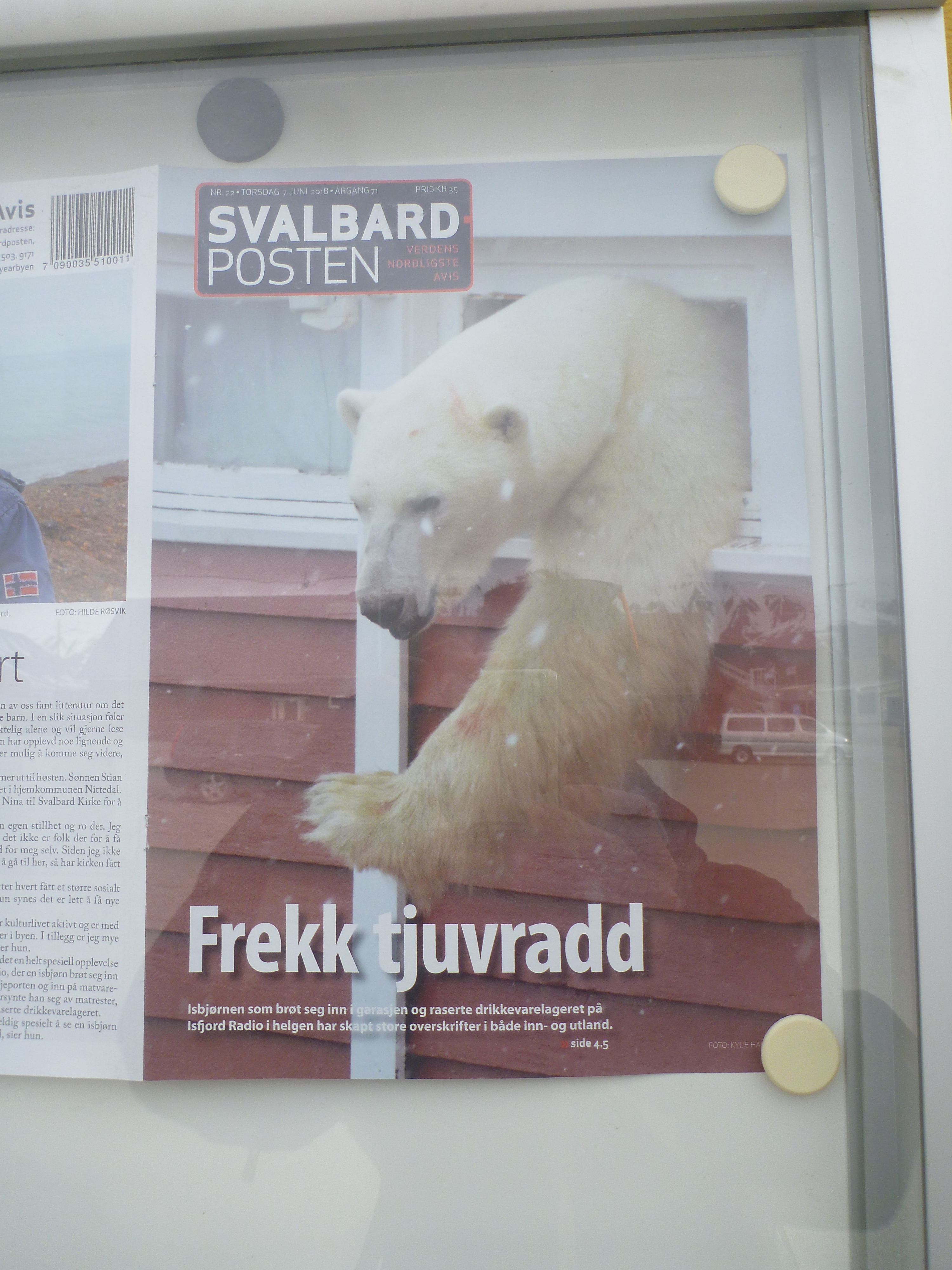
In town and on an excursion, you’re fine (there are maps that show which areas are safe and if you’re on an excursion, at least one of your guides will have a rifle).
But you don’t have to go very far out of town to be in a polar bear risk zone. In the past, there’s been attacks and deaths of people who left the town and went to these zones without a rifle. So please, do be careful .
I talk more about how to rent a rifle in Svalbard below.
Svalbard Accommodation
3.1) Where to stay in Svalbard
Likely, you’ll be staying somewhere in the capital city Longyearbyen. That’s where we stayed, so we’ll talk about options for staying there.
On the off chance you want to spend a night somewhere else, both Barentsburg and Pyramiden have a single hotel. Here is the link to the hotel in Barentsburg , and here is the link to the hotel in Pyramiden .
3.2) The best place to stay in Longyearbyen: our top recommendation
We had the privilege of being invited (by Mary Ann herself!) to stay at Mary Ann’s Polarrigg. And we’d highly recommend it to anyone else coming to Svalbard!
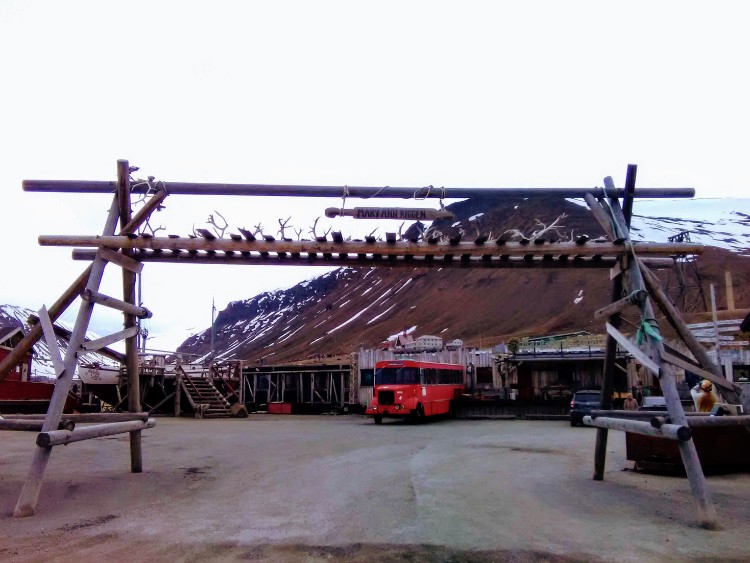
The Polarrigg, which was originally barracks for coal miners, is a place brimming with personality— from its cozy wooden interiors to its quirky arctic decor.
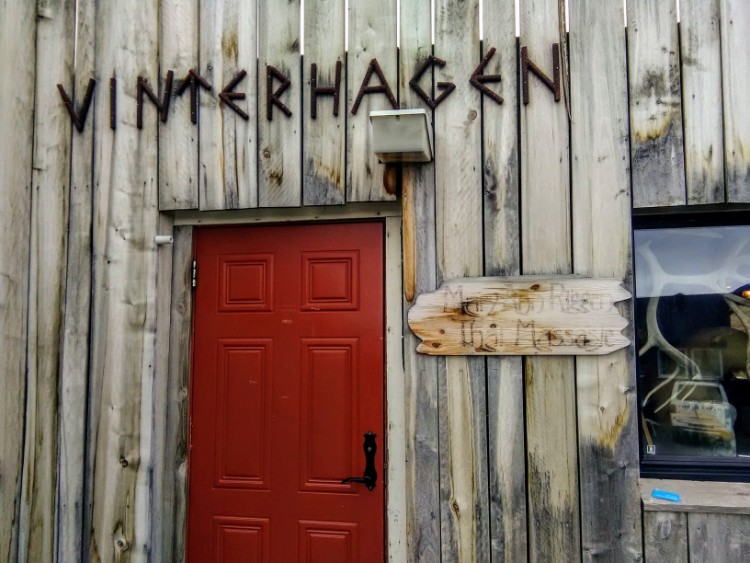
They have a variety of rooms (or even complete, furnished apartments) for you to choose from.
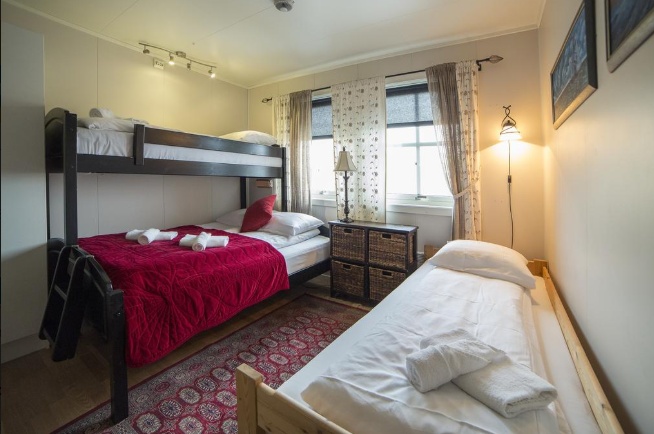
Basic private rooms with shared bathroom
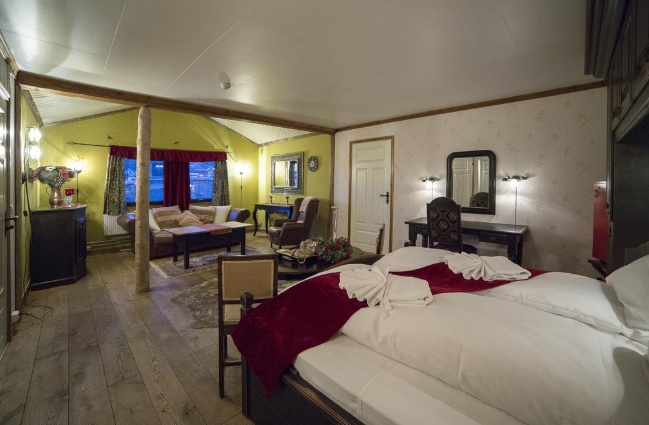
Luxury rooms with private bathroom
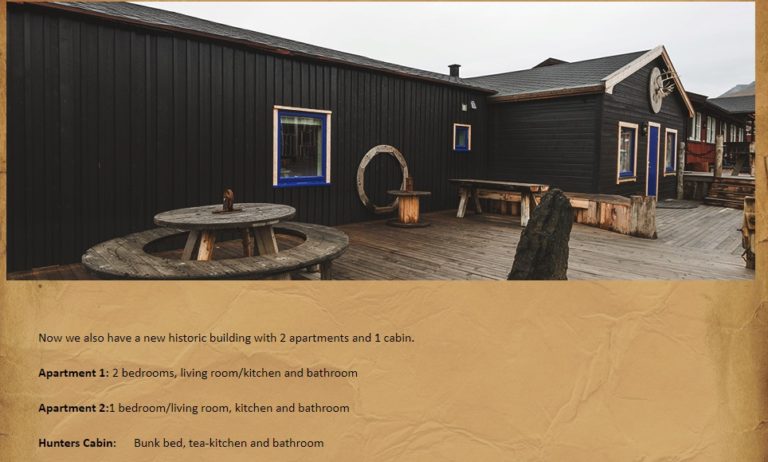
Complete, private apartment (where we stayed)
There’s an inviting common area with WiFi (although the WiFi was sometimes a bit too slow to use) in the main rig, and a shared kitchen you can use for a fee. Since we stayed in the apartment and had our own kitchen, we didn’t use this shared one.
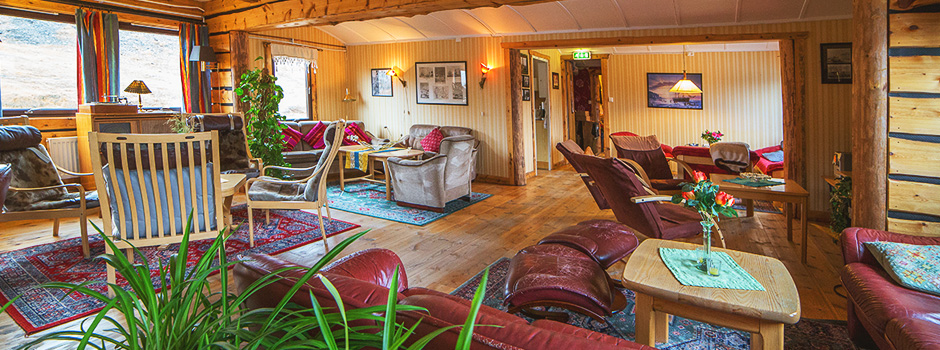
They also have a restaurant on-site which serves meals all day (including a buffet-style breakfast). There’s a spa, as well. We didn’t try either of these things personally since we were trying spending most of our budget on excursions….but they both look nice and are highly-reviewed!

The Polarrigg is about a 5 minutes walk to the town center.
We do have to admit that staying here isn’t the cheapest option. But between the comfy, cabin-y atmosphere of the Polarrigg and the charm and energy of Mary Ann, we know you’ll have a great time if you do!
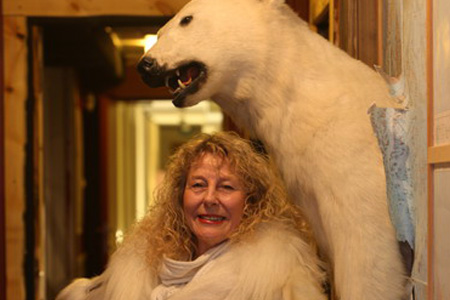
3.3) The cheapest place to stay in Longyearbyen, Svalbard
If you’re really on a budget , then it looks like the cheapest place to stay in Svalbard is the campground.

They have tents and arctic-grade sleeping bags for you to rent (for an extra fee), hot showers, and a shared indoor kitchen.
The biggest downfall is that it’s actually right next to the airport and thus quite far away from Longyearbyen center (it’s maybe an hour walk or so from the town center).
Luckily, if you take tours or excursions they can pick you up at the campsite. But if you need to buy groceries to use the kitchen or want to explore Longyearbyen, you’ll either have to walk or take the airport shuttle bus (approximately 120 NOK round trip with a schedule that revolves around flight times).
3.4) Other budget options for Svalbard accommodation
Svalbard Transportation
4.1) How to get to Svalbard
Any flight you take to Svalbard will have a connection on mainland Norway (usually Oslo, but sometimes Tromsø).
If flights from your departure city to Svalbard seem expensive, here’s something you can try: see if it’s cheaper for you first to buy a flight from your departure city to Oslo, and then a separate flight from Oslo to Svalbard.
See our article with 16 tips to find cheap flights before you start searching for your flight to Svalbard.
4.2) How to get from the Svalbard Airport to Longyearbyen Town Center
You have two options.
#1) Walk from the airport into town (about an hour — it’s just one straight road there so it’s impossible to get lost)
#2) Take the Svalbard airport bus. The bus costs 75 NOK (or 120 NOK roundtrip). The bus runs around the flight schedule, so no need to book in advance. The bus should be there when your flight arrives. You can buy your bus ticket directly on the bus with cash or credit card.
Here’s Svalbard airport bus timetable (this can change, so always check an updated schedule before your trip):

The bus stops at most accommodation options in Longyearbyen, so just tell the driver where you need to go. You can see a map of bus stops and read more info here.
4.3) How to get around Svalbard
The city of Longyearbyen is small (2,000 ish people). And since you won’t be walking beyond the city because of the polar bear risk, you can easily walk anywhere you need within the city.
Any excursions you schedule will pick you up from your accommodation directly so there’s no need to arrange transportation to a pickup point.
Renting a car isn’t really worth it because weather conditions aren’t great for much of the year, and there are very few roads (snowmobiles in the winter and boats in the summer are much better ways to get around).
In other words, between walking and transportation provided by excursions, you won’t really have to organize anything else.
Svalbard food & drink
As expected, eating out in Svalbard is expensive (a little more expensive than eating out in mainland Norway).
So, we can’t actually recommend any good restaurants since we didn’t eat out personally.
If you’re looking to visit Svalbard on a budget, then you’ll likely be buying most of your food at the local grocery store (there’s only one and it’s downtown – you can’t miss it).
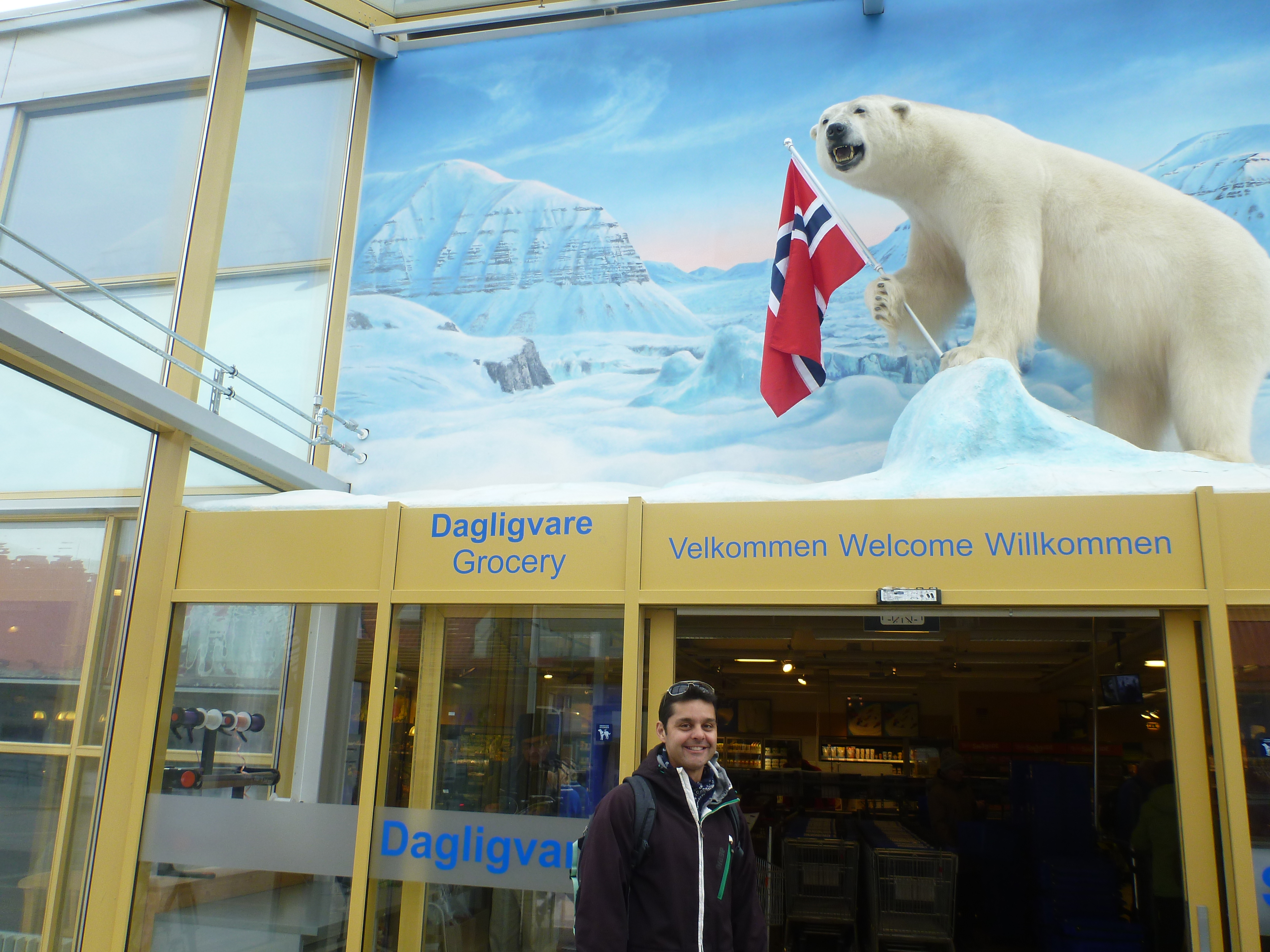
We had a kitchen in our apartment at Mary Ann’s Polarrigg, so we likely saved a lot of money by cooking our own food. Many of the accommodation options in Svalbard have kitchens as well, but you’ll want to ask to be sure.
During full-day excursions , your lunch is covered (although you may want to bring snacks).
What to do in Svalbard/Svalbard Itineraries
What you do in Svalbard will depend on the time of the year you’re going since certain activities are only available during certain parts of the year (ex. snowmobiling in the winter, fjord boat rides in the summer, etc.).
So while we maybe can’t help you with an itinerary that works year-round, we can tell you what we did during our visit in June and the tour companies we went with (all of which we’d highly recommend based on our experience).
On that note…
6.1) Our Svalbard 5-day itinerary (for summer/June)
Day 1: Arrival in Longyearbyen and city/area tour with SvalbardBuss
Our flight landed in Svalbard around noon and, since we had 24 hours of daylight, we wanted to get the most from our first day.
So, we booked a city & area tour with SvalbardBuss.
As you’ll probably know if you’ve read other articles on our website, we usually prefer to do things by ourselves and opt out of tours. But since it’s so hard to get around in Svalbard (between the polar bears and unwalkable distances between things), we decided our best option was this tour.
Here’s just a few of the things we visited on the tour around Longyearbyen :
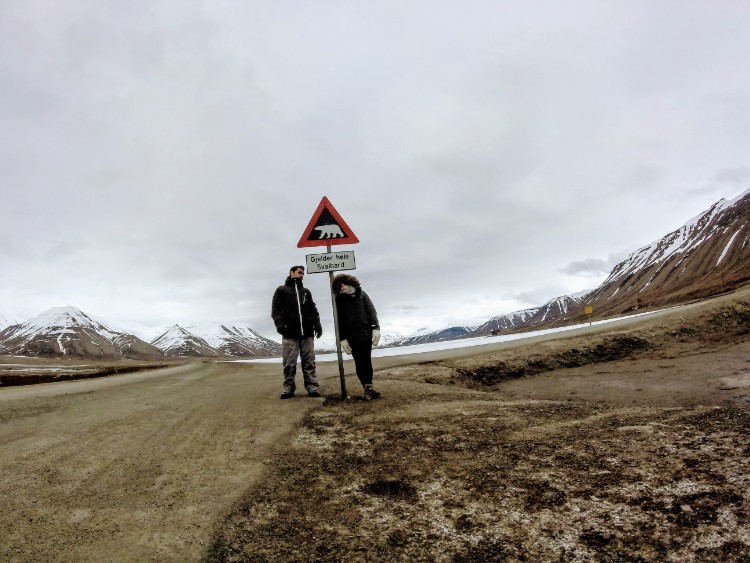
The famous “don’t go beyond this sign unless you have a rifle because that’s where the polar bears are” sign
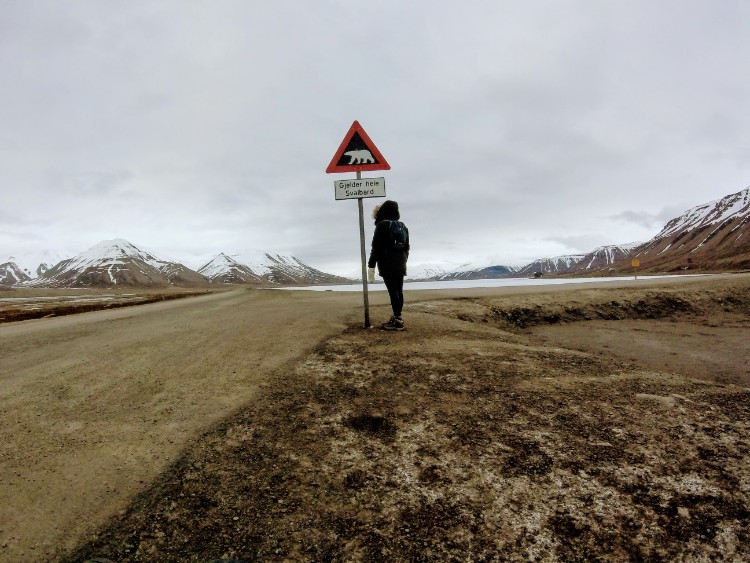
EISCAT Radar Station (featuring some adorable polar dogs!)
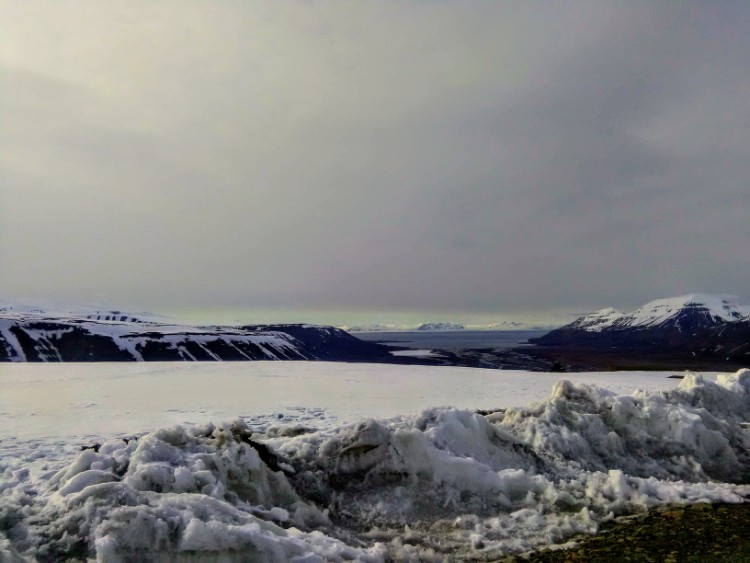
Views of the fjords
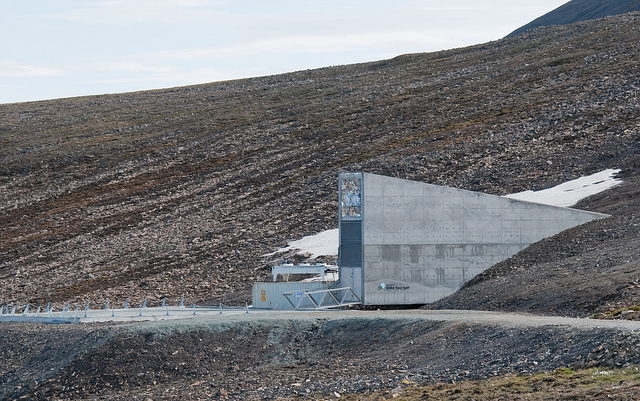
Global Seed Vault (aka the “Doomsday Seed Vault”) — Photo by Ethan Ableman
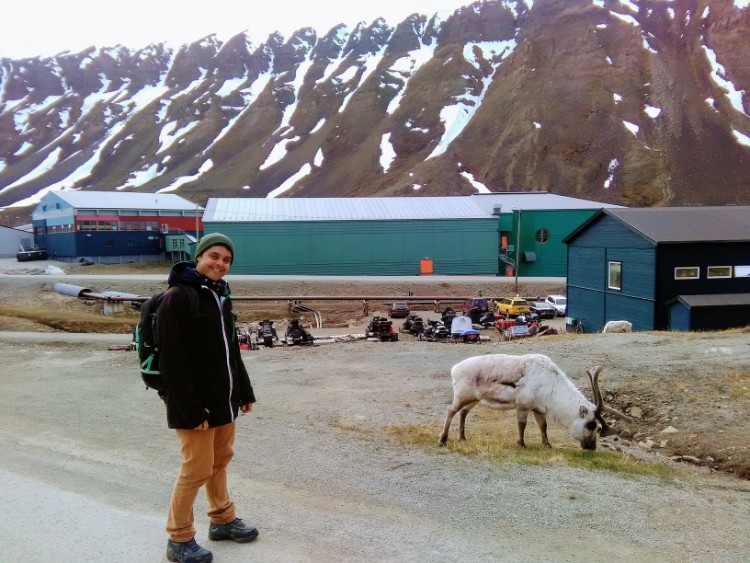
The reindeer of Longyearbyen
Most of these places (like the satellite station and the Global Seed Vault) were things that we would never have been able to get to ourselves. So, even if the tour might seem a bit expensive (they’re 345 NOK or a little over $40 USD), it really is a great option.
The tours are 2 hours long, will pick you up directly from your hotel or accommodation, and run twice a day at 10 AM and 4 PM. You can book online here.
Once you finish your tour, don’t forget to spend a bit of time wandering around the strange, though surprisingly charming town of Longyear!
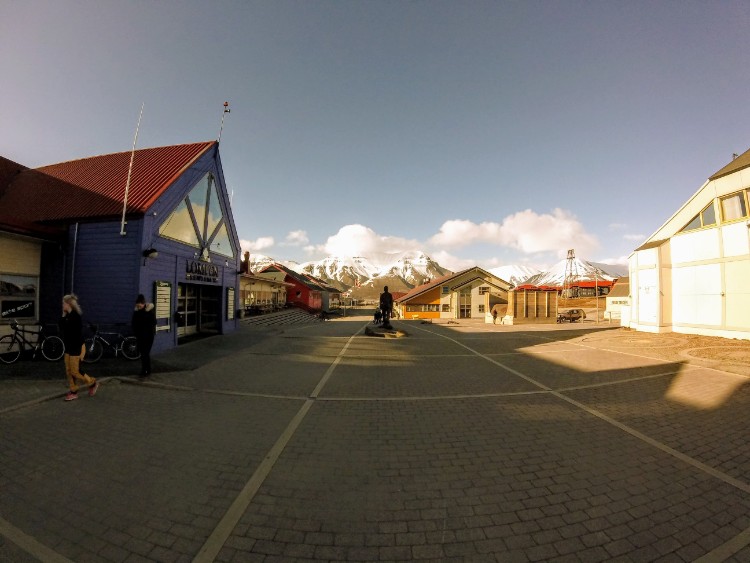
If you like, you can pick up a map from your accommodation or the tourist office of Longyearbyen (although Longyearbyen is so small you likely won’t need one).
And although we didn’t have time to visit, the Svalbard Museum is also supposed to be quite nice.
Day #2: Fjord Cruise to Esmark Glacier & Barentsburg with Henningsen
Clocking in at just under 600 residents, Barentsburg is Svalbard’s 2nd biggest ‘city’ and its last remaining Russian settlement.
Between the brightly colored canteen and dorms where Barentsburg residents (primarily miners and their families) eat and live….
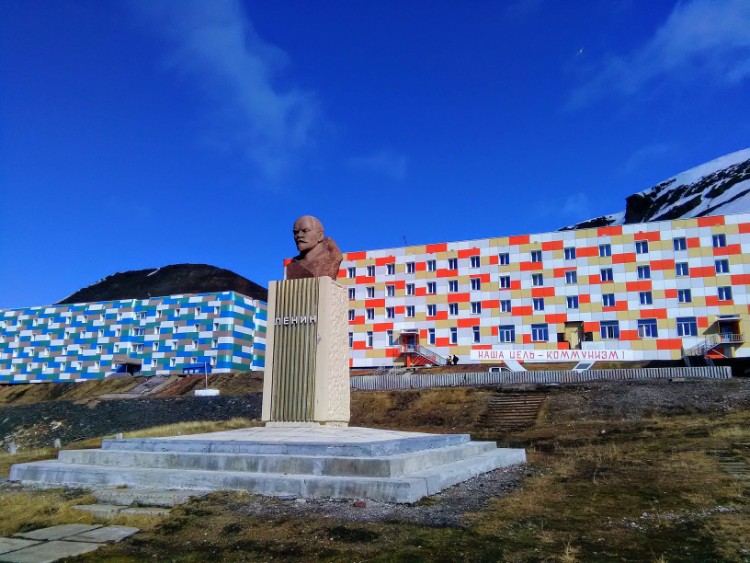
The leftover communist propaganda (which the residents do seem to enjoy making fun of)….
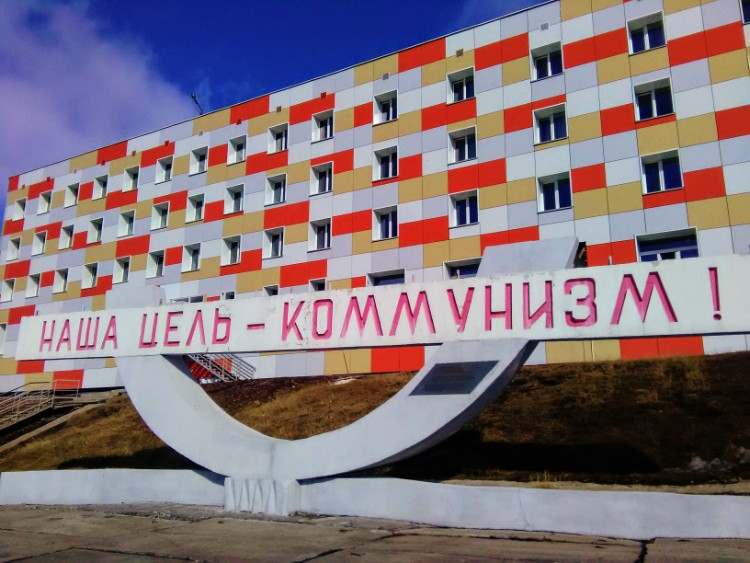
This one says “communism is the goal”
And the Lenin Statue ….
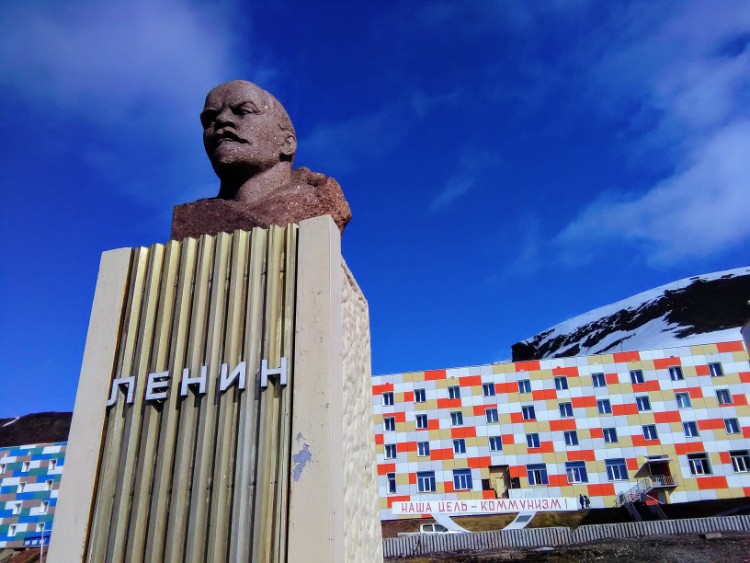
….stepping into Barentsburg will make you feel like you’ve been transported straight back to Soviet times.
Although there’s a few companies that do tours to Barentsburg, we went with Henningsen and we go with them again in a heartbeat.
Beyond your tour in Barentsburg, you’ll also have a lovely cruise through the fjords ….
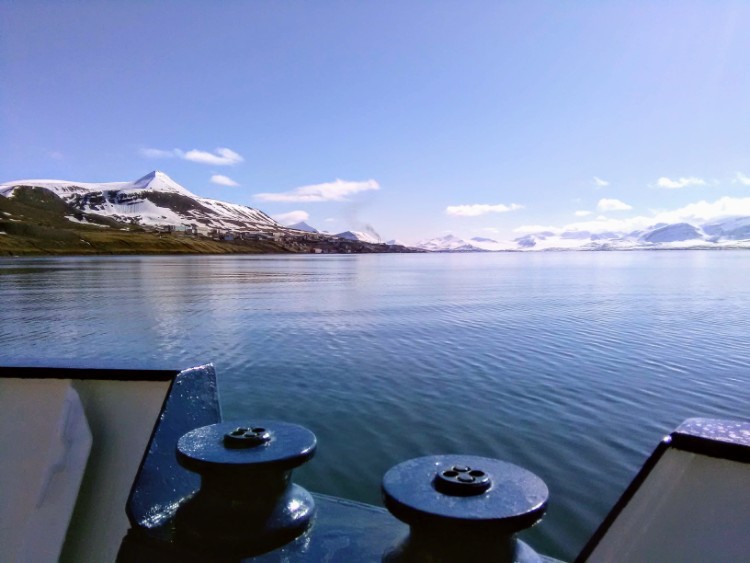
…. and pass by a glacier (where we saw 3 polar bears!).
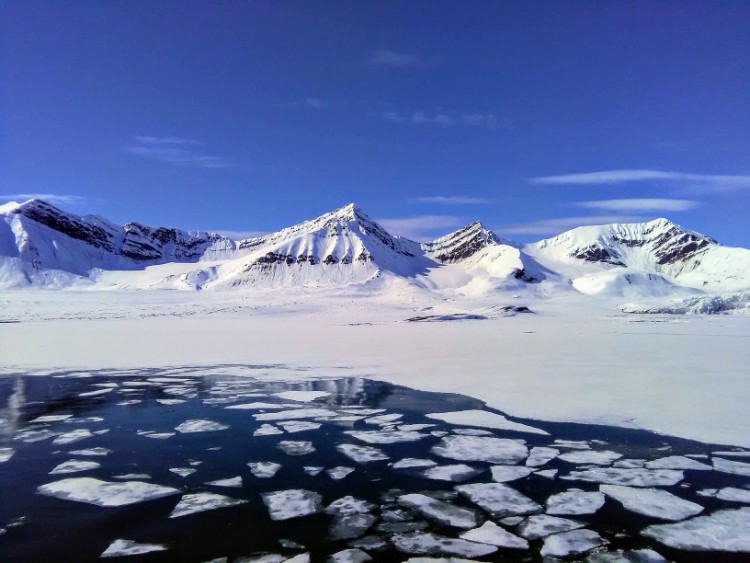
Photo courtesy of Clare Storry
Plus get a tasty BBQ lunch!
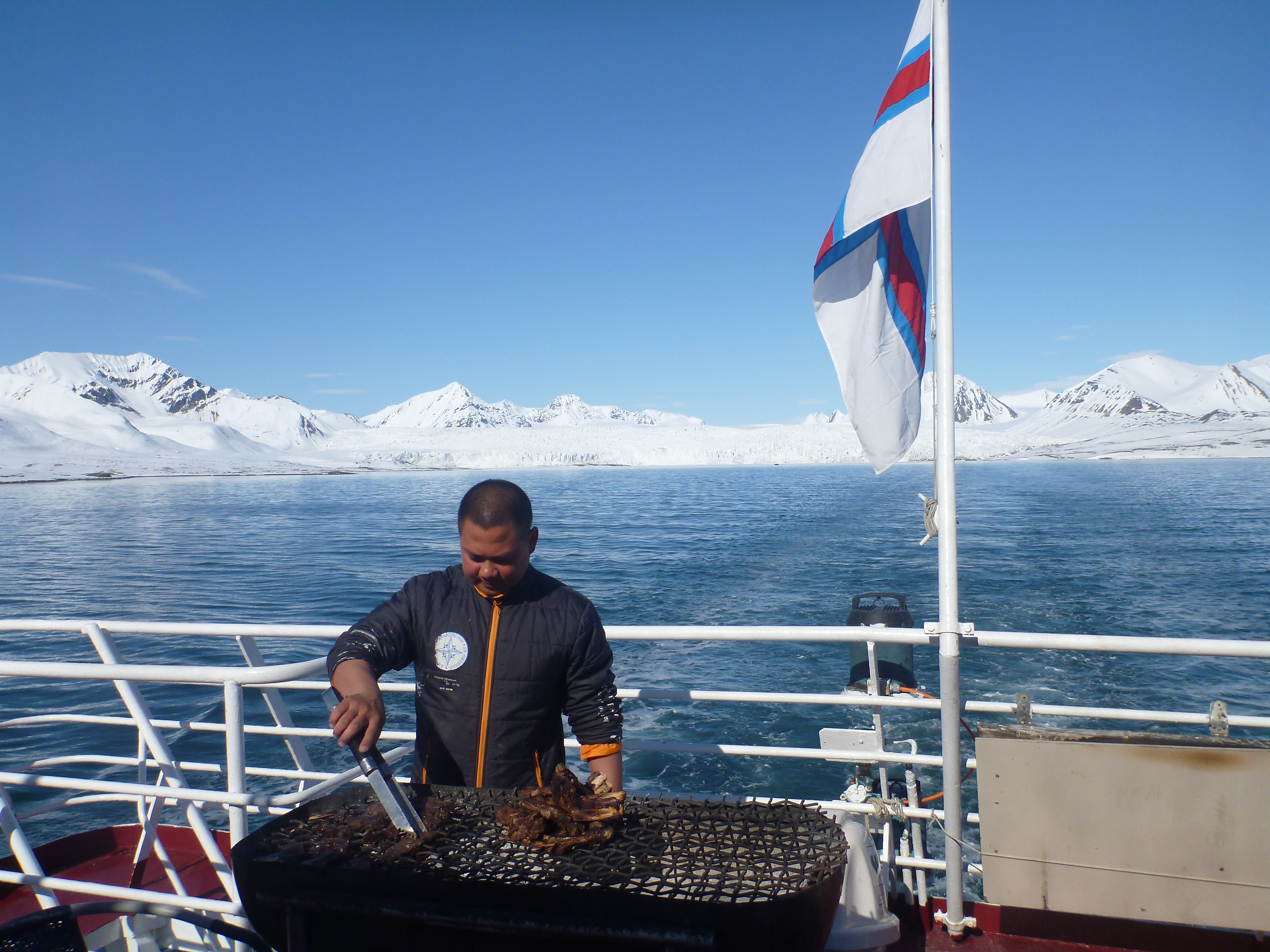
Henningsen runs tours to Barentsburg every day March 1st to October 24th.
Make sure you dress warmly so you can sit either inside or outside the boat and enjoy the view.
And if your extra lucky, you’ll even have our favorite guide, Marcus! (Honestly, he was the best. I’d even ask Henningsen beforehand what days he’s working to see if you can join his tour).
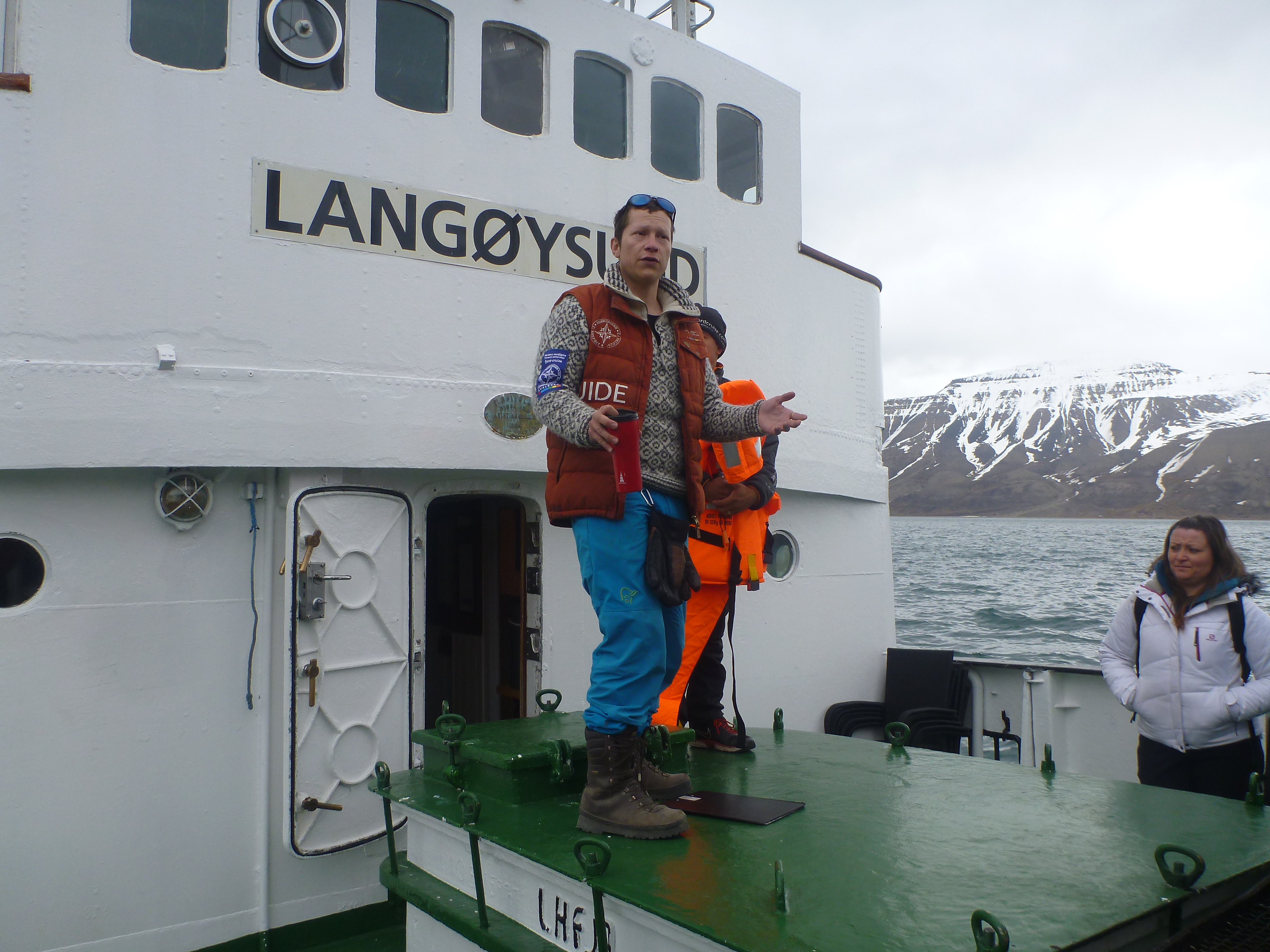
Thanks, Marcus!
You can read more and book your boat tour to Barentsburg with Henningsen here.
In the winter, tours to Barentsburg are done by snowmobile.
Day #3: Independent hike up Sarkofagan Mountain (without a tour/excursion)
If you are not 110% comfortable renting a rifle and using it in the case of a polar bear attack, then you should absolutely not even consider this as an option (instead, you should schedule an excursion/tour with a guide for each day of your trip).
But if you feel comfortable with a rifle, then there are quite a few mountains surrounding Longyearbyen that you can easily hike in a day.
In our case, since Rodrigo has a few years of military experience (including weapon training) and we are both strong hikers, he decided to rent a rifle one day so we could head out hiking on our own.
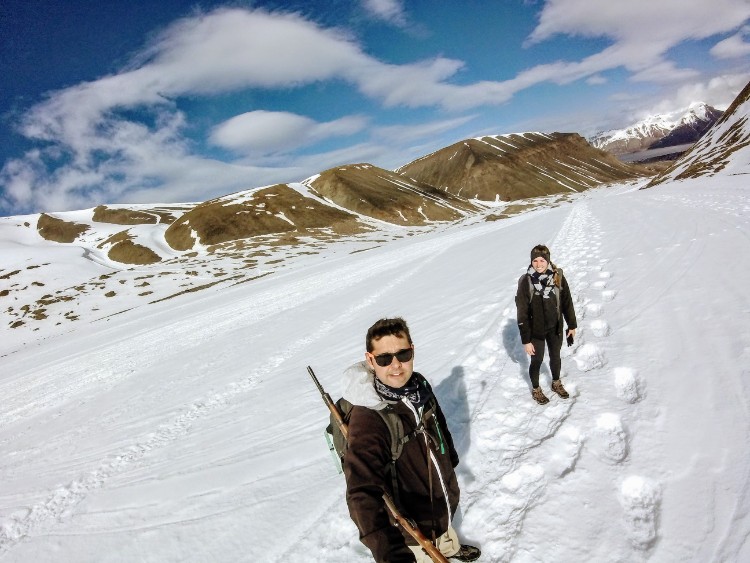
We asked locals, tour guides, and the tourist office for recommendations (which you should do as well), and settled on Sarkofagen mountain because 1) it wasn’t too far away, 2) it was almost impossible to get lost, and 3) conditions seemed to be good (as in, the river wasn’t too high to cross and the glaciers were safe to walk on).
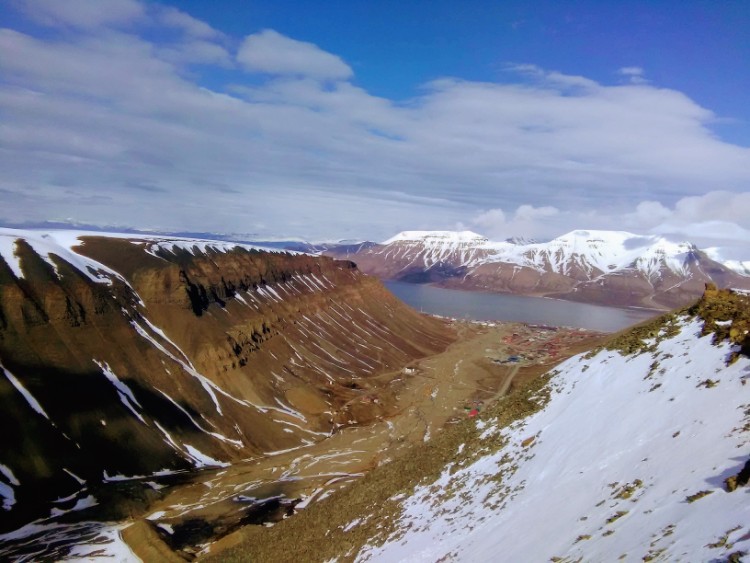
If you think you feel comfortable doing an independent day yourself, scroll down to our “exploring Svalbard without a tour” section below for more info.
On last warning: do NOT attempt an independent hike like this without renting a rifle because you don’t think it’s necessary. There have been polar bear attacks very close to Longyearbyen and taking the chance isn’t worth it.
Day #4: Arctic Challenge (Hiking & Kayaking) with Svalbard Wildlife
This particular tour, considered to be the most physically challenging day tour you can do around Longyearbyen, is great for adventurous travelers!
The tour begins by kayaking from Longyearbyen to the other side of the fjord, hiking to the top of the mountain there (called Hiorthfjellet) for a view of the city, then hiking down and kayaking back to Longyearbyen.
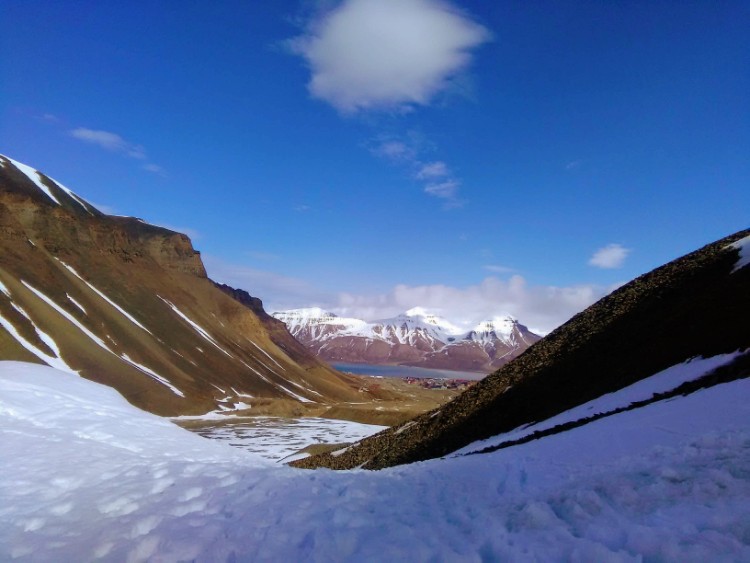
Hiorthfjellet is that mountain on the other side of the fjord
One reason we chose this tour was for the physical challenge. But also because we knew that even if Rodrigo rented a rifle again, we wouldn’t have been able to get all the way to this particular mountain on our own.
Unfortunately, we weren’t able to hike Hiorthfjellet because there was a polar bear sighting on that side of the fjord, and authorities weren’t able to scare it away with the helicopter nor track where it went.
So instead, we did the originally planned kayak route, then returned to our side of the fjord to hike Trollsteinen (a mountain behind Sarkofagen, the mountain we’d climbed the day before).
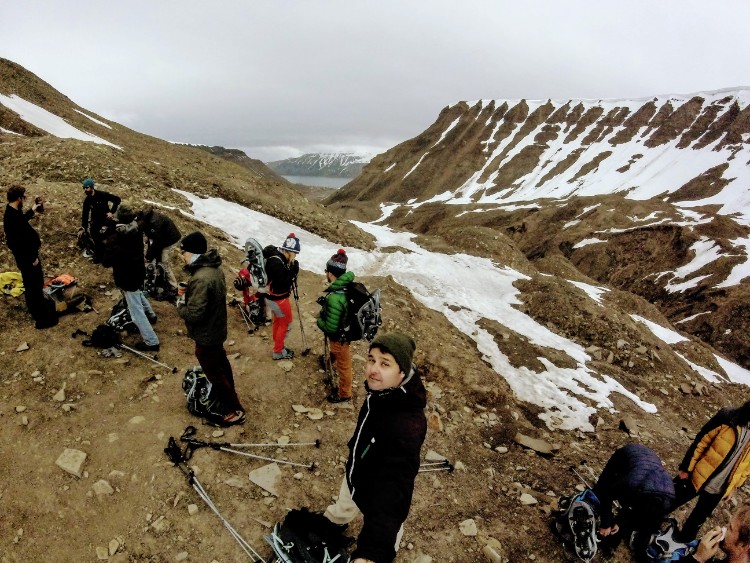
Honestly, this trip was maybe a bit expensive for what it offered (or maybe we just felt that way because we ended up hiking a similar route to what we did the day before on our own). But it was still a great physical challenge, and being able to go with a group was a lot less stressful than just the two of us and a rifle.
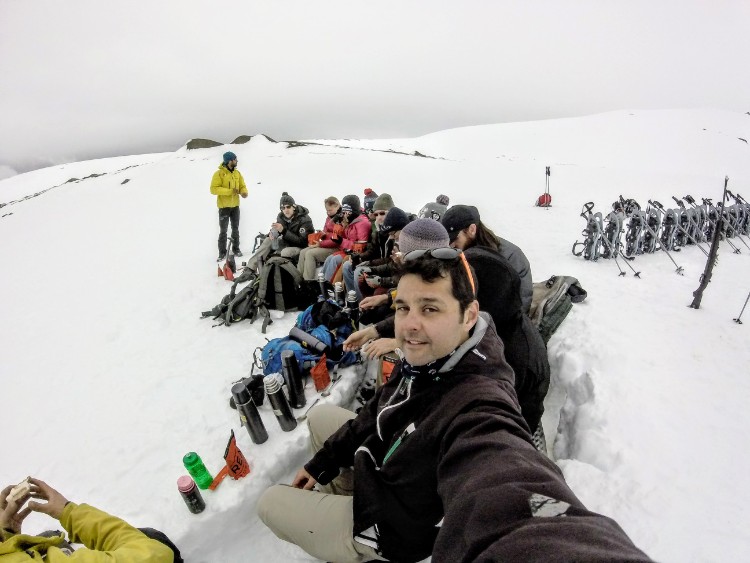
And, of course, kayaking with all the cold weather gear was quite the experience!
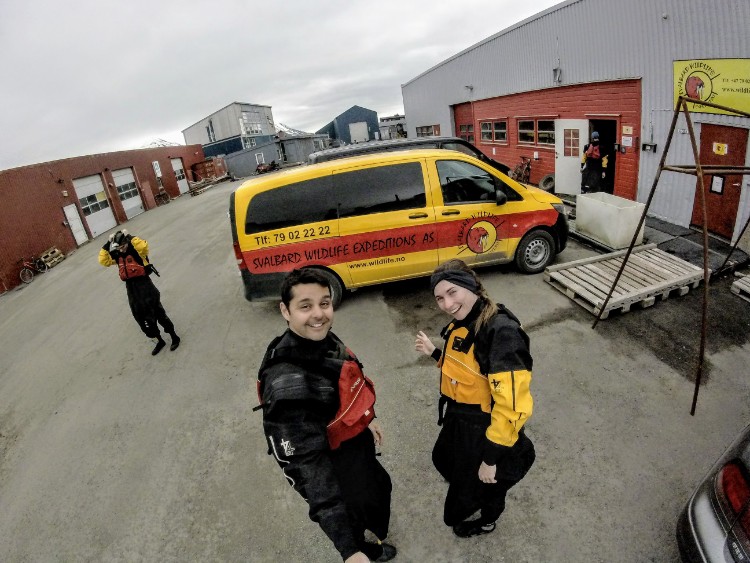
Svalbard Wildlife runs this tour Mondays, Thursdays, and Saturdays from June to September. You can read more info and book here .
Day #5: Fjord cruise to Nordenskiöld Glacier & the (almost) abandoned city Pyramiden with Henningsen
If you thought Barentsburg was bizarre, just wait until you visit Pyramiden!
This once booming Russian mining town, which was home to 1,000 people, is now home to just 9 isolated residents. Yet, the town has remained almost entirely as it was during its Soviet “glory days .”
(Read more about Pyramiden and its bizarre history here )
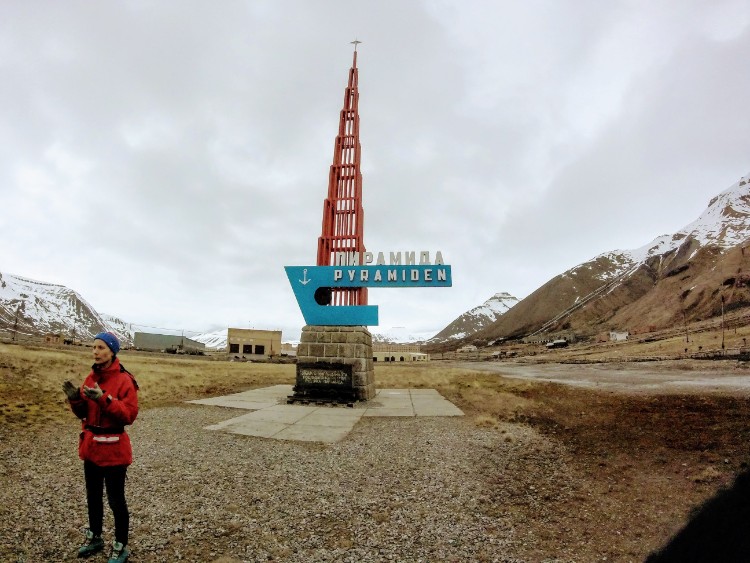
Though many of the buildings are now locked up if you’re lucky your guide will open up a few for you to explore…
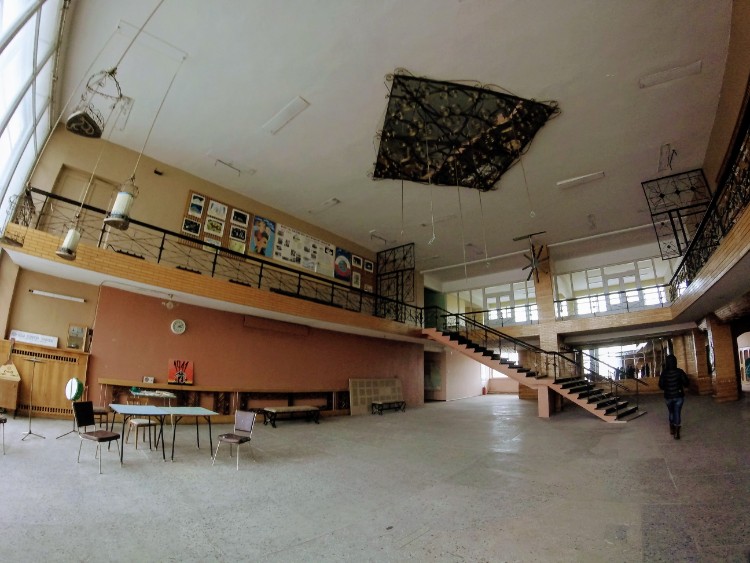
Abandoned recreation center
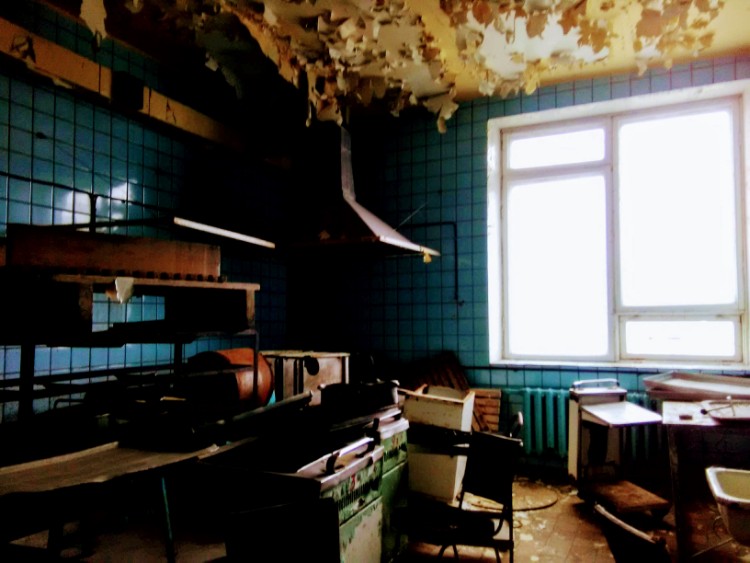
As with the cruise to Barentsburg, the trip to Pyramiden is equally stunning and hopefully filled with wildlife (we saw 2 blue whales, a pod of beluga whales, and a polar bear from a distance). Admittedly, the boat ride is kind of long….but chatting with fellow passengers , admiring the view, and taking a bit of a cat nap will certainly keep you entertained.
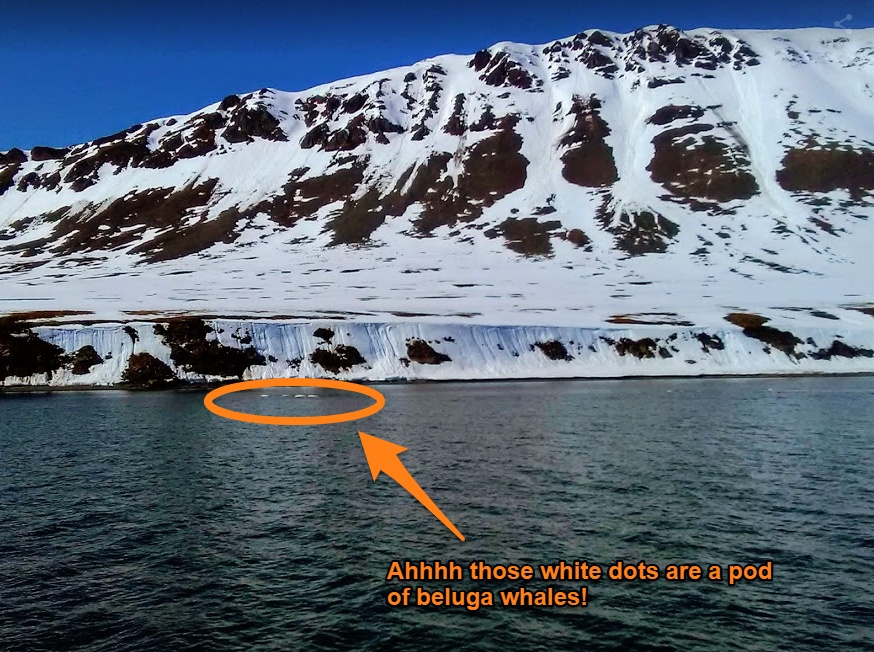
Like with our trip to Barentsburg, we also went with Henningsen and our favorite guide Marcus.
Henningsen runs boat tours to Pyramiden every day March 1st to October 24th. You can read more about the tour and book here.
One more thing: check with the tour company before your trip to make sure the ice isn’t too thick for you to dock at Pyramiden. This sometimes happens and you won’t be refunded if it does.
6.2) Svalbard Winter Itinerary & Activities
The first thing to decide is if you want to go during the “Northern Light Winter” with 24 hours of darkness (1st October – 28th February) or the “Sunny Winter” (1st March – 16th May).
Again, we weren’t there in the winter so we can’t help too much with this. But like I mentioned above, you can check out the Svalbard Activity Planner on the Svalbard Tourism website to see all your options for winter tours and activities.

Some popular winter activities in Svalbard include:
- Snowmobile trips to Barentsburg and Pyramiden
- Snowshoeing/cross country skiing
- Dog sledding
- Northern light cruises
- Ice cave tours
One last tip: before you book an excursion, check the reviews for the tour company on Tripadvisor to see if other people have had good experiences.
6.3) How to visit the Svalbard Global Seed Vault (the “doomsday vault”)
Unfortunately, it’s not possible to visit the interior of the vault. But you can see it from the outside!
The vault isn’t too far away from Longyearbyen, so it might be possible to hike there. However, it is outside the “safe from the polar bear zone,” so you’d need to rent a rifle to make the hike.
Otherwise, as we mention in day #1 of our itinerary above, we highly recommend doing the Longyearbyen and surrounding area tour with SvalbardBuss (which includes a stop outside the Global Seed Vault).
6.4) How to visit Barentsburg
In the summer, there are a few companies that have boat tours to Barentsburg (which also include a tour of Barentsburg once you arrive).
Most of the companies use expedition, icebreaker-type boats (which are awesome because they let you get closer to the glaciers) that have indoor/outdoor seating, and go more slowly.
Like we said in our itinerary above, we went with Henningsen (in one of the slow/expedition/icebreaker-type boats) and had a great time. Scroll up to day #2 of our itinerary for more info about our trip to Barentsburg.
If you wanted to spend the night in Barentsburg, you can try talking to some of the tour companies and see if you can negotiate a 1-way trip (or a round trip that has you coming back on a different day).
In the winter, Barentsburg is only accessible by an overland snowmobile tour.
6.5) How to visit Pyramiden
Visiting Pyramiden is fairly similar to how you’d visit Barentsburg. You either have the option of a slow/expedition/icebreaker-type boat or a fast boat.
As with Barentsburg, we also went in the slow/expedition/icebreaker-type boat with Henningsen and had a wonderful trip. Scroll up to day #5 of our itinerary for more info about our trip to Pyramiden.
In winter, Pyramiden is also only accessible by snowmobiling across the frozen fjords.
6.6) Exploring Svalbard without a tour/by yourself
If you want to venture out beyond Longyearbyen on your own to hike one day like we did (day 3 in the itinerary above), then there’s two important steps you need to take: #1) rent a rifle and #2) ask about the weather and environmental conditions.
Keep on readin’ for some more details about these two steps.
6.7) Exploring Svalbard without a tour: how to rent a rifle in Svalbard
IF you are comfortable operating a rifle when confronted with a polar bear, then you can rent a rifle to do some individual exploring.
If I was by myself, I would never have dreamed about renting a rifle alone. However, since Rodrigo has military experience and is comfortable operating a weapon if necessary, he rented the rifle (you just need a single rifle per group).
One VERY important thing to know: rifles should primarily be used to scare a polar bear away. Shooting them is an absolute last resort.
https://www.sysselmesteren.no/en/
Here are the steps you need to take to rent a rifle in Svalbard:
Step 1: Fill out this application form here and provide a “Certificate of Good Conduct” from your home country. Rodrigo used a background check from his home country, Brazil, as his “Certificate of Good Conduct.”
The “Certificate of Good Conduct” must be in either English or Norwegian, so I then translated the document for him into English from Portuguese.
Step 2: Print out both forms, sign the application, then email it to the governor’s office on this website here.
Step 3: If you’re approved, you’ll receive an email letting you know with an attached “approved form.” Print this out and bring it to Svalbard with you.
Step 4: When you arrive in Svalbard, bring this form (along with your passport) to Longyear 78 Outdoor & Expedition sports store to rent your rifle. The store is right downtown near the supermarket.
Step 5: They walk you through using the rifle, you pay the rental and bullet fee and demonstrate you know how to use the rifle, and off you go!
6.8) Exploring Svalbard without a tour: check the conditions
Conditions change fast in Svalbard and there’s some unexpected natural hazards you need to watch for (meltwater in glaciers, avalanche zones, polar bear sightings, etc.). So, we’d highly recommend talking with the people at your accommodation, the tourist office, tour guides, or locals to see if your hiking route is safe to do currently.
Safety note: If you are heading out by yourself, tell someone (receptionist at your hotel, the person you rent the gun from at the sports store, etc.) where you are going and what time you expect to be back. Tack on a few extra hours to your estimate and ask them to let the authorities know if you aren’t back by then.
How to work or study in Svalbard
Unlike the rest of Norway (and most other places in the world), Svalbard is a 100% visa-free zone. In other words, anyone from anywhere in the world can come to live and work without a work visa in Svalbard.
If you do plan to stay long-term and arrive without a job offer, however, you do have to show proof of funds to support yourself.
This article here does a great job breaking down what it’s like to move to and work in Svalbard.
If you want to study, The University Centre in Svalbard (UNIS) has courses in biology, geology, geophysics, and technology. It’s also the world’s northernmost higher education institution in the world!
To see their courses and learn how to apply, check their website here .
Final tips for visiting Svalbard
- Bring good binoculars. This wasn’t even something we thought about before our trip, and we wish we had. Luckily, we had really nice guides who let us use their binoculars. But without them, we wouldn’t have been able to spot those 3 polar bears on the glacier or look at the blue & beluga whales more closely. (Which would have been pretty heartbreaking after going all the way to Svalbard!) You can check some binoculars models and prices here.
- Bring lots of layers and warm clothes. Since you’re in the arctic….this should be pretty obvious. Even though we were there in the “summer,” most days I still wore my winter parka (it was around 0 Celsius even in the summer) . Many tour companies will also send you an email after you book an excursion with clothing recommendations.
- Get crushed ginger or seasickness pills . As you saw in our itinerary, we took lots of boat rides while in Svalbard. If you’ll be there during this same season and are prone to seasickness, make sure you bring something for it (seriously, crushed ginger is amazing for this). You can also find some to buy here.
Svalbard Attractions, Tours and Activities
If you are looking for activities to do in Svalbard, I recommend looking at Viator and GetYourGuide . These sites have some very fun options for activities, and the best, several promotions.
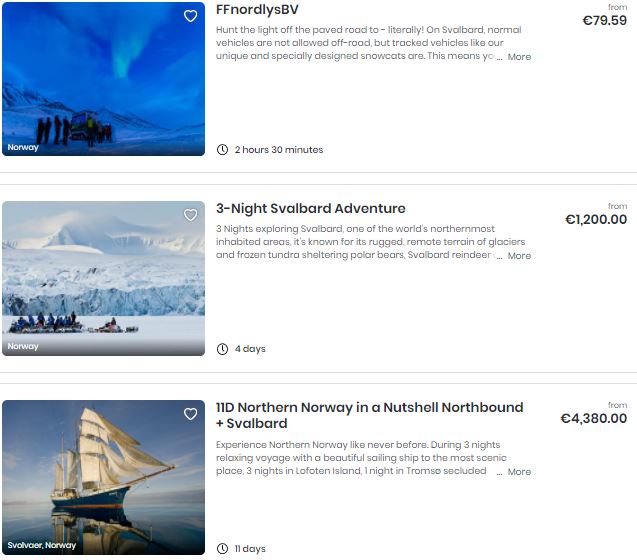
GetYourGuide

If you didn’t get enough of Svalbard in this looong article, here’s another for you: 18 Amazing Facts about Svalbard .
And that’s it!
Have you been to Svalbard before? Do you have any other tips you’d like to add? Or do you have any of your own questions? Let us know in the comments below!
—–
A quick disclaimer: we had the privilege of partnering with several of the companies and brands mentioned in this article. As part of our partnerships, we were hosted or may have received discounted rates in exchange for writing honestly about our experiences with them. But as always, all thoughts and opinions are 100% our own.
Planning your next trip?

Already reserved your hotel or hostel? If not, our article with The 6 Best and Cheapest Websites to Find & Reserve Accommodation can help you out. You’ll also find some promotions and discount codes .

Still haven’t booked your plane ticket and want to save big? Take a look at our page with 16 Tips to Save on Flights where you’ll also find the 4 best websites to buy your plane tickets.

And finally, will you need to rent a car during your trip? Then surely our page with The 5 Best and Cheapest Websites to Compare and Rent Cars Around the World will help you choose the best rental car and find a good deal.
4 Responses
Hi, very useful info, thanks. What about renting cold weather clothing? We’re going feb 2023.
Sylvia Scales
Hi Sylvia – glad to hear the article helped!
Hmm I’m afraid I don’t know too much about cold weather clothing rentals. Since we went during the summer, we could “get away with” our normal winter jackets.
Do you already know what activities you’re going to be doing while you’re there? I know if you book a snowmobile excursion or the like, they will probably supply heavy-duty winter gear. So it might be worth contacting some of these companies and seeing if you could rent out these clothes for your entire stay.
If you find somewhere you can rent, do you mind commenting back here so I can update the article for other travelers?
[…] say hard-to-get-to, I mean hard-to-get-to! There are excursions to Antarctica, 12-day trips in the Arctic, visits to the Jordanian desert, or cultural experiences deep in the Amazon jungle with indigenous […]
[…] like Southeast Asia or Eastern Europe. But we’re keen to explore more and would love to visit Svalbard on a budget and the faroe islands too in the […]
Leave a Reply Cancel reply
This site uses Akismet to reduce spam. Learn how your comment data is processed .
Next stop….The DMZ, South Korea

How to Visit Svalbard: Travel Guide, Essential Info for First Trip & Fun Facts
By Author Jurga
Posted on Last updated: January 20, 2023

Are you thinking of visiting Svalbard but are not sure what to expect and how to plan your trip? In this article, you can find all the essential tips and information that you may want to know when traveling to Svalbard for the first time .
Why visit, interesting facts, how to get to Svalbard, what to see and do, where to stay, how expensive is it, packing tips, and more. Find out!
Svalbard Travel Guide – OVERVIEW:
- How to get to Svalbard
- Introduction to towns and settlements
- Interesting facts
- Getting around
- Best time to visit
- What to wear & what to pack
- Things to do (per season)
- How much time do you need in Svalbard
- Where to stay
- Where to eat
- Shopping & supermarket
- Budget & money
- WiFi & roaming
Why Visit Svalbard
Svalbard, also known as Spitsbergen, is a Norwegian archipelago located just over 1050 km (652 miles) from the North Pole. It’s the world’s northernmost place that you can easily visit.
If you like unique places, majestic endless landscapes, untouched nature, and once-in-a-lifetime experiences, but prefer places that are not overrun with tourists, are simple to plan a trip to, and easy to visit on your own, then Svalbard might just be the destination for you.
Incredible scenery, amazing wildlife, majestic mountains, impressive glaciers, beautiful fjords, and unique towns – these are just a few reasons to visit Svalbard.
If you come here in summer, you can experience the midnight sun and endless days. If you travel here in winter, you’ll experience polar night , northern lights, and frozen landscapes that will take your breath away. There is one thing common throughout all the seasons, however, and that’s the unparalleled offer of amazing outdoor adventures .
While there is plenty on offer for the most adventurous, Svalbard is an ideal destination for those of us who prefer soft adventures. Here, lots of bucket-list-worthy experiences await, in combination with all the modern facilities, comfortable hotels, and great restaurants. A trip to Svalbard is exciting, it’s different, but it’s also really simple and easy to plan.
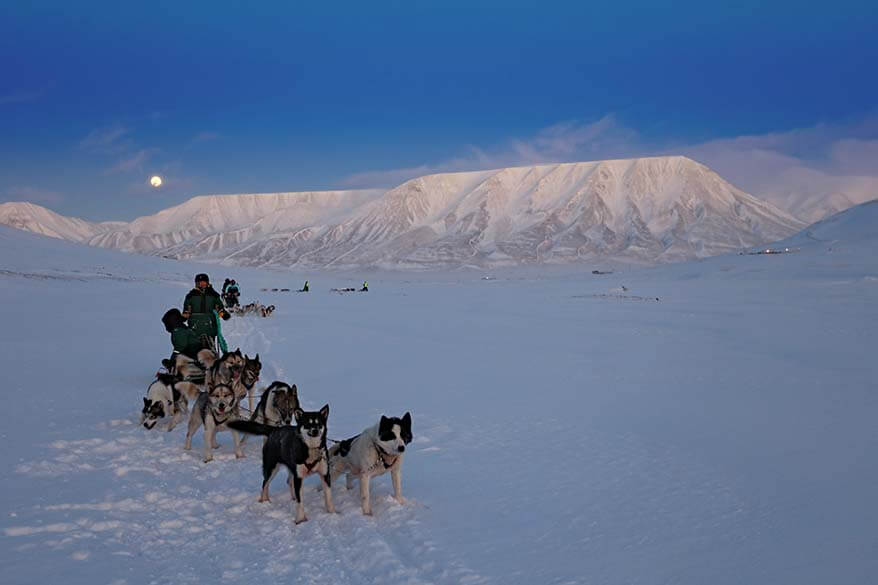
How to Get to Svalbard
Svalbard is not as far or inaccessible as it might look at first sight. It’s actually really easy to get to with direct flights from Norway.
The only difficulty might be flight schedules, meaning that you’ll need to plan a layover in Oslo or Tromso. It was the case for me and I had to spend a night at a hotel in Oslo airport twice – on my way there and on the way back.
The easiest way to get to Svalbard is by plane . There are regular direct flights to Oslo and also to Tromso, with FlySAS or Norwegian . It takes just 3 hours to get to Svalbard from Oslo and less than 2 hours from Tromso.
In summer, you can also visit Svalbard by cruise ship . There are actually quite some amazing trips to be found, but they are usually really expensive (and you have to be willing to live on an Arctic ship for a few days).
Good to know: Even though you don’t need a visa to visit Svalbard, you might need one for a stopover in Norway. So – depending on your nationality – make sure to check what the requirements are. As already mentioned, you always need a passport for Svalbard (even EU citizens) and they check it several times before you even board your flight.

Towns & Places
To avoid confusion, I want to clarify some of the names that you’ll hear most often when visiting Svalbard.
Svalbard is an island archipelago that consists of many islands. Svalbard is located between mainland Norway and the North Pole and used to be a no man’s land. The Svalbard Treaty, signed in 1920, recognizes the sovereignty of Norway over Svalbard.
Norwegian law applies in Svalbard, but there are some special rules and stipulations. Basically, any country that has signed the treaty, might come and do business in Svalbard. It’s also a visa-free zone and people from all over the world can live and work here without any special visa.
Spitsbergen
The largest island of Svalbard is Spitsbergen , where most tourists visit. Other bigger islands are Nordaustlandet, Edgeøya, and Barentsøya.
In the past, Svalbard used to be known as Spitsbergen. Even today, many people, tours, and even travel guides refer to Svalbard as Spitsbergen.
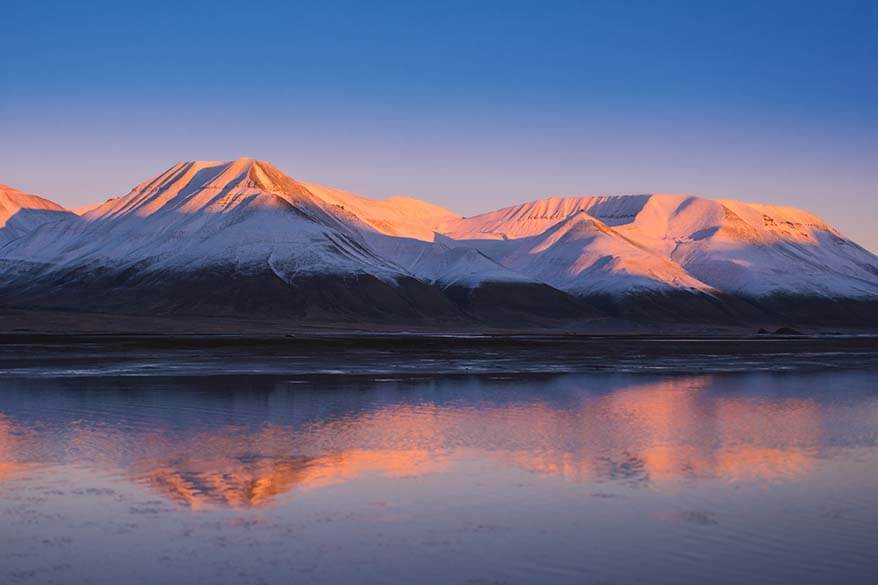
Longyearbyen
Longyearbyen is the largest settlement in Svalbard. About 2,400 people of over 50 different nationalities live here. That’s the town where you’ll find an international airport, most hotels, restaurants, and shops. This is where most tourists stay when they visit Svalbard.
Barentsburg
Barentsburg is the second-largest settlement of Svalbard. It’s has a Russian-Ukranian community of over 400 people. There is a hotel and a restaurant in town, but most people just visit it as a day trip from Longyearbyen.
Pyramiden is a real ghost town. It’s an old Russian coal mining community that used to be home to over 1,000 people. The town has been abandoned at the end of the 20th century and a trip there is like going back in time, back to the USSR… Nowadays, most people visit Pyramiden as a day trip from Longyearbyen, but there is also a hotel there. If you go here, you’ll need cash as no credit cards are accepted.
Ny-Ålesund
Ny-Ålesund is the world’s northernmost settlement. It’s not really a town, but a scientific research center with scientists from several different countries living and working there.
There are about 40 people living there year-round. In summer, the population often grows to about 120. Ny-Ålesund has its own airport (Hamnerabben), harbor, a small café, the world’s northernmost post office, and a souvenir shop. It can be visited as a day trip from Longyearbyen – usually in summer, by boat.
There are also several other smaller settlements in Svalbard. Most of them are old abandoned mining communities or serve as scientific research stations and aren’t often visited by tourists.
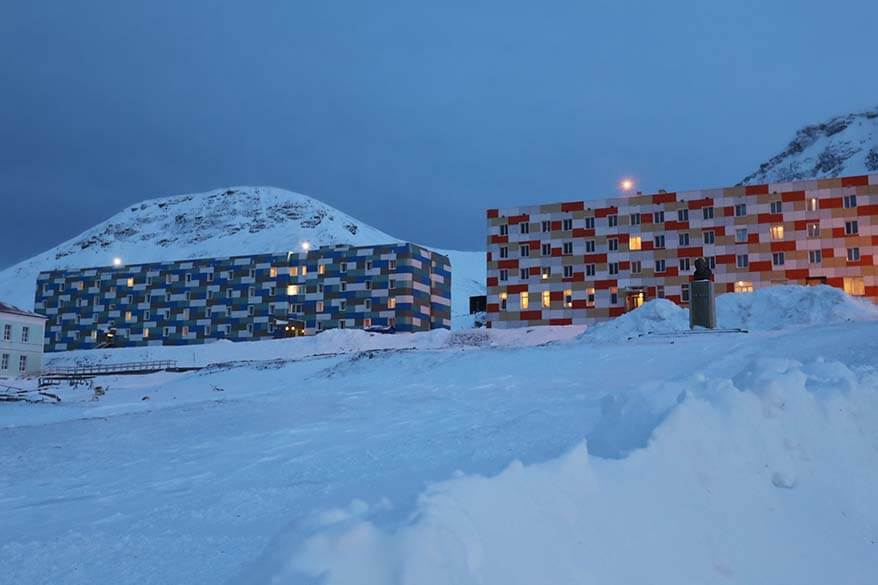
Interesting Facts about Svalbard
With a surface of over 61,000 km 2 (23,550 sq mi), Svalbard is about twice the size of Belgium. Glaciers cover about 60% of Svalbard’s landmasses, barren stone – 27%, and just 13% is vegetation.
Based on the earlier mentioned Svalbard Treaty , you don’t need a visa to live and work in Svalbard. Norwegian law is applied here, but people cannot be discriminated against based on their nationality in any way.
Svalbard is not part of Schengen and you always need a passport when traveling to Svalbard . Even the EU citizens who can normally travel to Norway using just their European ID card, need a travel passport for Svalbard.
Longyearbyen is the world’s northernmost town . It is closer to the North Pole (1,338 km – 831 miles) than it is to Olso (2,313 km – 1,437 miles).
In Longyearbyen, the midnight sun lasts from 20 April until 23 August, and the polar night lasts from 26 October to 15 February. Still, not the entire period of the polar night is completely dark. I visited at the beginning of February and there was some light from about 9 AM to 3.30 PM.
They say that you can’t be born or die in Svalbard , but it’s not entirely true. Pregnant women have to travel to the mainland (usually Tromso) about 3 weeks before their due date and give birth there. However, in case of emergency, Svalbard hospital will, of course, help deliver the baby.
It’s now forbidden to be buried on Svalbard (due to permafrost). However, it’s allowed to have your remains cremated and buried in Svalbard if you lived here for a long time and made important contributions to the community. All other people have to be buried elsewhere.
Svalbard is one of the few easily accessible places in the world where you can see daytime auroras (during the polar night when it’s pitch dark during the day).
Because Svalbard is so high in the North, it’s located above the Aurora Oval (or Aurora Belt). So if auroras aren’t very strong, you usually have to look for them in the southern direction.
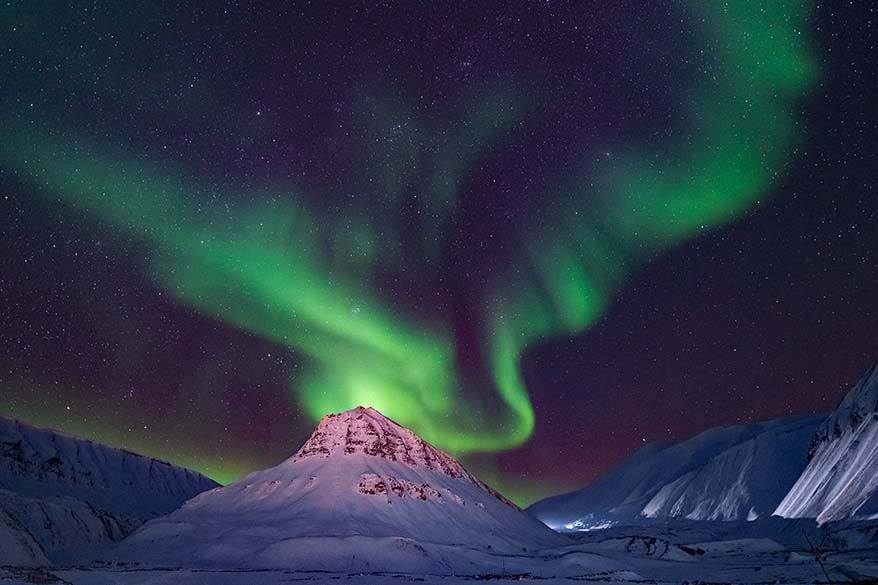
There are more polar bears in Svalbard than people and it’s illegal to leave town without carrying a gun and knowing how to use it. It is also illegal to kill bears, unless absolutely unavoidable. The chances of running into a polar bear in town or on one of the tours aren’t big, but it does happen.
It’s an old custom not to lock your house in Svalbard . That way, if a bear shows up in town, people can always find a place to hide.
There are no street names in Svalbard. There are also just about 40 km (25 miles) of paved roads .
They say that there are more snowmobiles in Svalbard than people. In winter, it’s the main means of transportation for the locals.
It’s obligatory to take off your shoes in most places in Svalbard – hotels, offices, museums, the church… The shops don’t have this rule and most restaurants either. Places that oblige you to take off the shoes, always offer slippers. This tradition is said to date back to the times of the coal mines in order to prevent coal dust inside. But since it’s also a common custom in Iceland, I think it has more to do with the mud and the snow on your shoes than with anything else.
Cats are forbidden in Svalbard in order to protect birds. From what I understood, there are still some cats that live here, but – in principle – no new ones are allowed.
There is a dog hotel just outside of Longeayrbyen, where people who live in apartments, can keep their dogs. Most huskies and sled dogs aren’t used to living inside and they would also be too warm.

Is Svalbard Safe?
With almost non-existing crime, Svalbard is a very safe place to travel . I visited Svalbard in the darkest winter months as a solo female traveler and never felt unsafe for a minute.
The biggest danger is wandering out of Longyearbyen on your own and getting lost or running into a polar bear .
Svalbard is a place you have to visit with local guides . Summer or winter – there are plenty of tours available and you have to take them. Going out on your own is very dangerous and it’s not allowed. Not only because of the polar bears but also because of the rapidly-changing weather with incredibly strong winds and the mist that can come up out of nowhere… So while you can rent a rifle in Svalbard, it’s really not a good idea to explore outdoors on your own.
Another potential danger is slipping on ice in winter. I wore spikes on my shoes and it was a big help. You don’t absolutely need them, but it sure helps if you are planning to walk around a lot. Walking to the church and back was particularly slippery because it’s quite steep there.
Good to know: Longyearbyen has a hospital.
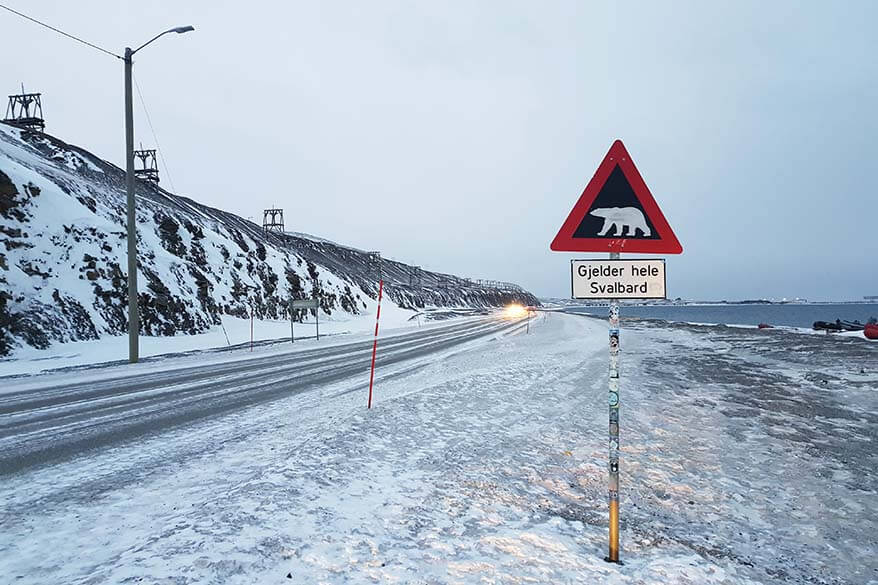
Getting Around Svalbard
You can rent a car in Longyearbyen, but there is really not much you can do with it (see above). In town, you can walk everywhere. And there are also taxis available.
From the airport, you can take a bus to Longyearbyen. This airport bus runs before and after every flight and stops at all the bigger hotels in town. Here you can find more information about Svalbard Flybus .
There are also private airport transfers available , but they are quite expensive compared to the bus.
When you take tours , they’ll usually pick you up at your hotel or at one of the hotels nearby.

Best Time to Visit Svalbard
I always thought that the best time to visit Svalbard was in summer, but after my recent trip in February, I’m convinced that every season and each month has its charms. The best time to visit Svalbard depends on what you want to experience. If you can, it’s a place that you should visit at least several times – during the dark polar night and also in the light warmer season…
Here’s a short overview of what you can expect:
- October, November, December, and January are the darkest winter months. Visit for polar night, northern lights, outdoor activities in the moonlight, ice caves, and lots of local events and celebrations.
- February is the blue season and one of the most beautiful times to be in Svalbard for the gorgeous blue light. There is no sun at the beginning of the month yet, but it’s light for about 6-7 hours and that light is dazzling. It’s a great time to experience the best that Svalbard has to offer in winter.
LEARN MORE: Svalbard in February
- March and April are the sunny winter months. There is more light and so you can embark on longer day trips and excursions with dog sleds or snowmobiles. The nights in March are still dark enough to see auroras.
- May is a bit of a shoulder month. It can still be very cold, but the days are endless and you can see and do a lot. Some winter activities are still available (for example, you can go snowmobiling on a glacier), but boat trips are also starting to run and so you can experience summer activities as well. You can also see the walrus already.
- June, July, and the first half of August are the busiest months to travel to Svalbard. The days are long and everything is much easier accessible. It’s the best time to come for wildlife, boat tours, kayaking, and hiking. It’s also the most expensive time to travel and it’s essential to book everything in advance.
- End August, September, beginning of October is a bit of a shoulder season and a very good time to visit Svalbard too. You can experience pretty much everything as in summer, but with fewer people and somewhat lower prices. From about half September, you might also see the Northern Lights.

Svalbard Weather
In summer, you can expect temperatures around 0-10°C (32-50°F), whereas in winter it can get as cold as -30°C (-22°F). Keep in mind that it might feel much colder because of the windchill factor.
The warmest month in Svalbard is July, with temperatures around 5°C (40°F), and the coldest month is February with an average temperature of -15°C (5°F).
In summer temperatures don’t fluctuate that much, but the weather is much more unpredictable in winter. To give you an idea, just before I arrived in Svalbard in February, they had temperatures of -25°C to -32°C (-13 to -26°F), but just a few days later when I was there, it was just -6°C to -10°C (14 to 21°F).
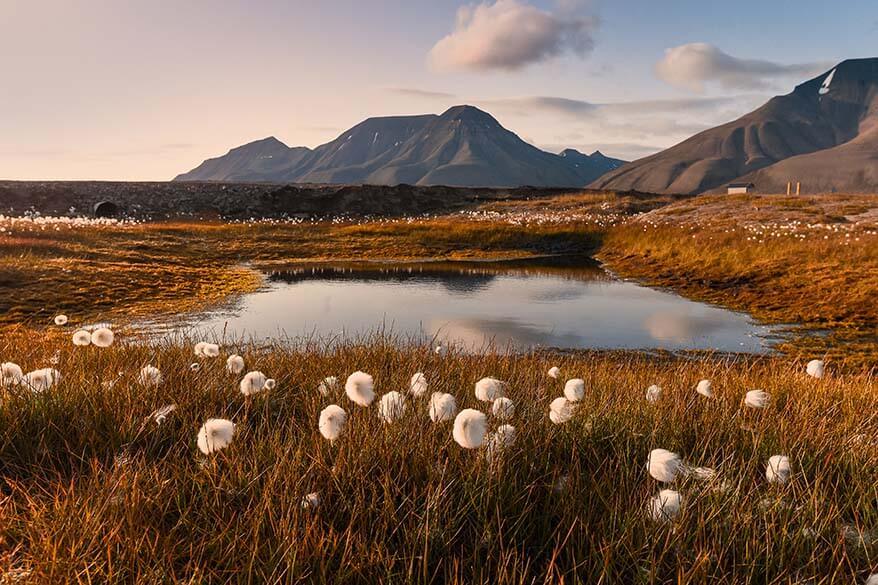
What to Wear & Packing Tips
Locals say that Svalbard only has two seasons – winter (October to May) and summer (June to September). However, if you read information about Svalbard weather above, you already know that ‘summer’ is a relative term. Our Belgian winters are warmer than summers in Svalbard…
So no matter when you travel to Svalbard, make sure to pack really warm, waterproof, and windproof clothing. Layers and quality materials are the two keywords to remember.
LEARN MORE: What to pack for Svalbard in winter (October to May)

Things to Do in Svalbard
No matter when you visit, there is a lot to see and do in Svalbard. While some things can be done year-round, some other activities are season-related.
Below is a short overview per season, but keep in mind that some tours run in the shoulder season as well. So for example, most boat tours run in summer, but some start already in March, etc.
Because there is so much to see and do in Svalbard and because some tours only run in certain periods, it’s important to do some research for your travel dates. I recommend that you check the Visit Svalbard website , where all available tours are listed. You can filter the search for your travel dates, interest, as well as difficulty level and choose tours that interest you the most.
Year-round Activities
- Longyearbyen: museums, art gallery, brewery, shopping, and dining
- Coal mine tour
- Boat trips (except in the darkest winter months)
- Fat tire biking
- Wildlife photography (not in the darkest months)
- Visit Barentsburg or Pyramiden (not in the darkest months)
Summer Activities
- Wildlife viewing – walrus, polar bear
- Dog ‘sledding’ on wheels
Winter Activities
- Northern Lights tours
- Snowmobiling
- Dog Sledding
LEARN MORE: Best Things to Do in Svalbard in Winter
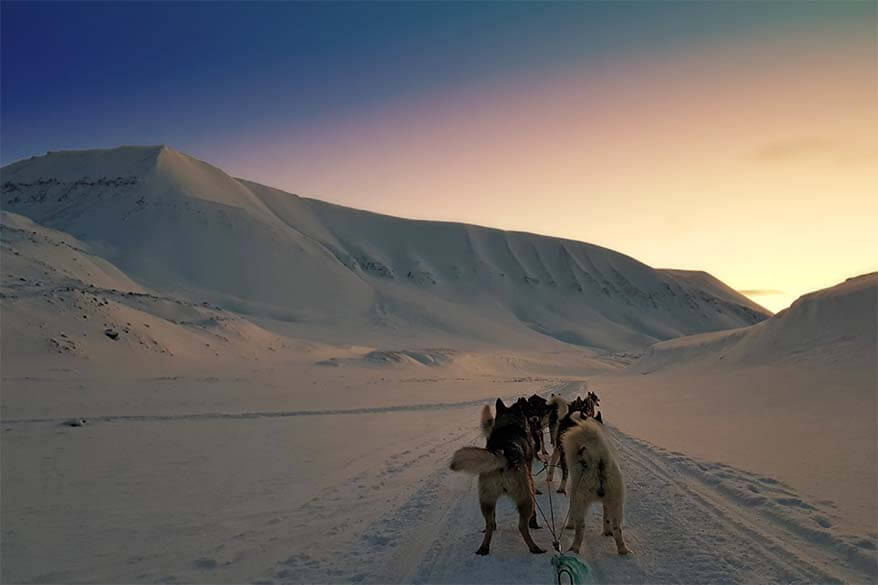
How to See Wildlife
Svalbard is a great place to see some incredible wildlife that you can only find close to the North Pole: polar bears, walrus, Arctic Fox, Svalbard reindeer, but also whales and some bird species.
The best time to see wildlife in Svalbard is in the summer months and the best way to do it is by joining wildlife viewing boat trips. That’s the least intrusive way to enjoy wildlife without bringing people or animals in danger.
Svalbard Reindeer
Svalbard reindeer is a unique reindeer species that can only be found here. They are much smaller, thicker, and have shorter legs than other reindeer – qualities they need in order to survive the harsh Arctic winters.
Since they have no natural predators in Svalbard, they are not afraid of anything or anyone and roam freely all over Svalbard. The reindeer are easy to spot in any season. That’s also one of the few animals that you can expect to see when visiting Svalbard in winter.
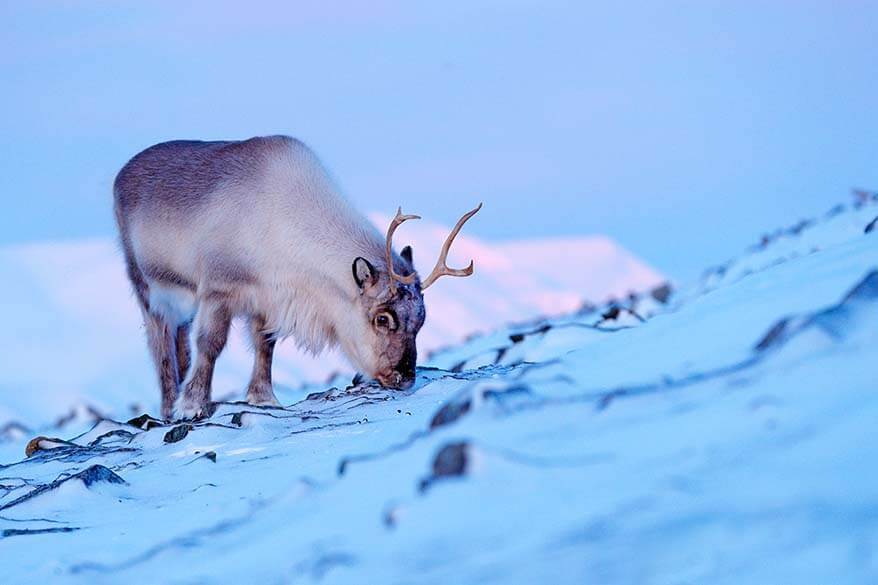
Polar Bears
Polar bears are an endangered species, protected by Norwegian law. This means that there are no polar bear safaris in Svalbard. That being said, bears are free to roam anywhere and so you never know when and if you’ll see one.
The chances of seeing polar bears in Svalbard without going on a boat tour aren’t as high, but it does happen. Polar bears don’t hibernate in winter and so, in principle, they can also be seen in all seasons.
In winter, polar bears can be found throughout the entire Svalbard. In summer, the bears usually follow the sea ice and migrate northeastwards. If you really want to see a polar bear in Svalbard, it’s probably best to visit Svalbard in the warm season and book a multi-day boat expedition. They go to the more remote areas that aren’t easily reachable by taking day trips and allow you to watch polar bears from the safety of the boat and without bothering them.
Polar bears are huge and they attack without warning. Therefore, safety should always be your number one priority. No tour guide will ever put people in danger just so that you can attempt to take a picture of a bear. If there’s a bear spotted anywhere near town or people, every effort is made to avoid encounters and the bear is usually chased away by a helicopter.
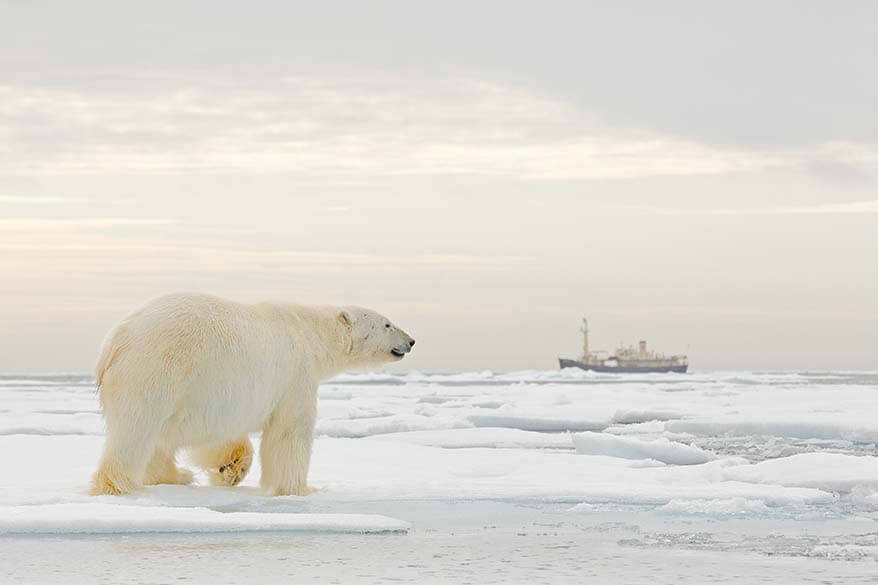
Walrus is another species of wildlife that can be found in Svalbard. They usually live in big groups. In summer, they come closer to shore and the best time to see walruses in Svalbard is from May to mid-August.
There are boat trips available from Longyearbyen that focus on walrus viewing. Since they have to travel to the more remote areas where walrus is known to be found, these boat trips usually take an entire day.
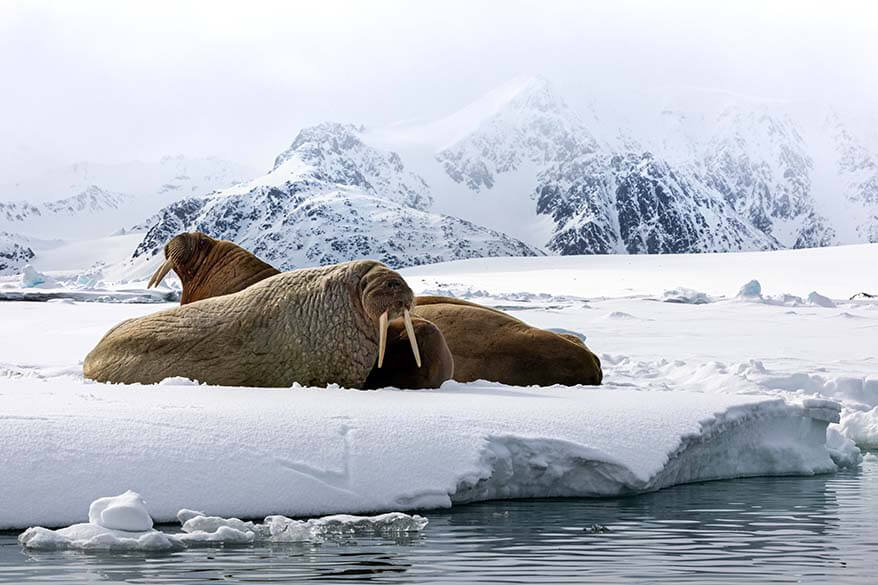
How Much Time Do You Need in Svalbard
If your budget allows it, I suggest planning at least 4 days for Svalbard . This will give you enough time to see Longyearbyen, visit the museums, do the coal mine tour, and also join a few day tours, outdoor activities, or longer excursions to Barentsburg or Pyramiden.
If you can stay for 5-7 days, you’ll be able to do a big variety of tours and get a much better idea of what Svalbard is about.
If you visit for just 2-3 days, you’ll probably leave feeling that you missed too much. I really think that Svalbard deserves a longer trip, no matter in which season you travel.
TIP: If you have the time and the money, you may want to consider the multi-day boat cruises in Svalbard. That’s a great way to experience the archipelago and see lots of wildlife. Note that this is only possible in summer.
My experience: I visited Svalbard in February and stayed for 4 nights. Because I arrived at around noon and left in the afternoon, I had 3 full days and 2 half days in Svalbard. This was sufficient for a winter trip, but it was really intense. I was so tired after full-day snowmobiling and dog sledding trips that I couldn’t force myself to stay awake and go looking for auroras at night… So if you want to take it easier, I really recommend staying a bit longer.

Where to Stay
The main town where most people stay during their entire visit to Svalbard is Longyearbyen . There are several accommodation options in town:
- Budget: Coal Miner’s Cabins or Gjestehuset 102 – both a bit further away from the town center (about 2km, 30 min walk). Haugen Pensjonat Svalbard is another popular budget accommodation, somewhat closer to town.
- Lower mid-range: Mary-Ann’s Polarrigg – a quirky place within a short walking distance to the town center.
- Mid-range: Radisson Blu Polar Hotel , Svalbard Hotell Polfareren , and Svalbard Hotell The Vault . All excellent options right in the town center.
- Higher budget: Funken Lodge – a beautiful hotel, some 15 min walk to the town center. Svalbard Hotell Lodge – a centrally located hotel with 1- and 2-bedroom apartments.
There is also a hotel in Barentsburg , a hostel in Barentsburg , and also a hotel in Pyramiden, but staying there would require a bit more planning.
LEARN MORE: Complete Guide to Svalbard Hotels
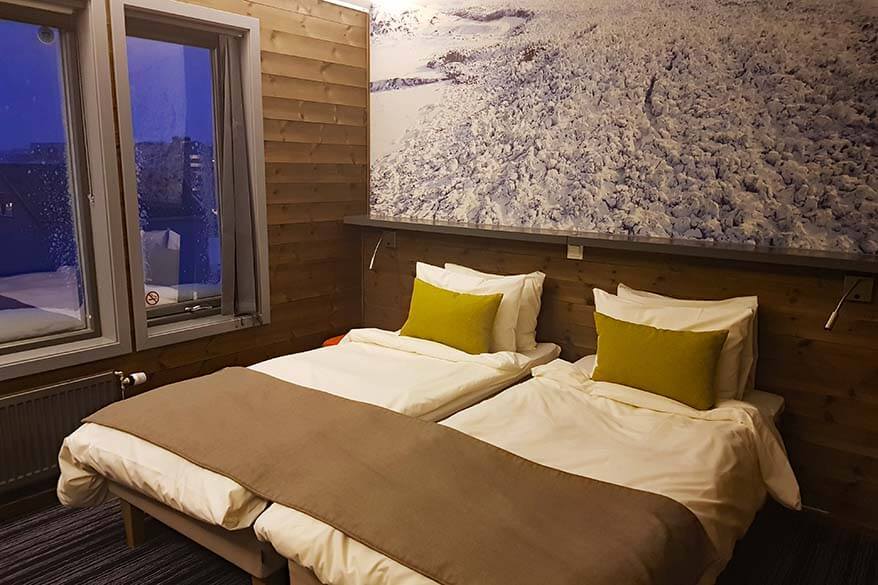
Where to Eat
There are so many restaurants and cafés in Longyearbyen that you really have nothing to worry about when it comes to where or what to eat.
My favorite places for dinner were Kroa restaurant in Longyearbyen town center and the Coal Miner’s Bar and Grill (about 2 km from the town center). Excellent food, cozy atmosphere, and reasonable prices.
Other good restaurants in Longyearbyen are hotel restaurants . You can dine at most hotel restaurants even if you are not staying there. Check out Restaurant Polfareren at the Svalbard Hotell, Funken Restaurant at the Funken Lodge, Barentz Gastropub inside the Radisson Hotel, and Vinterhagen Restaurant & Peisen Bar (Winter Garden) at Mary-Ann’s Polarrigg.
Gruvelageret and Huset Svalbard are considered some of the best restaurants in town – places for fine dining with a higher price tag.
For lunch , check out Fruene Café that’s located inside the shopping center ( Lompen Senteret ) or Rabalder Cafe & Bakery at the library and cultural center ( Kulturhuset Longyearbyen ). Both are excellent choices and very popular among the locals.

Shopping & Supermarket
There are lots of different shops in Svalbard. Most of them sell clothing, such as wool sweaters, but also all kinds of outdoor clothing and gear, and also souvenirs.
There is one big supermarket in town, Svalbardbutikken. It’s the place to be for food and drinks and you can find everything here – from fresh fruit to fresh-baked bread to dairy products, and also alcoholic beverages.
Since this supermarket serves as the main shop for local residents as well, you can find pretty much everything here, not just food. From household appliances to souvenirs, but also photography gear, linen, etc. So if you forgot to pack something, this is the place to be.
The supermarket is open daily, but on the weekends, opening hours are shorter than on weekdays.
Longyearbyen town also has a pharmacy .
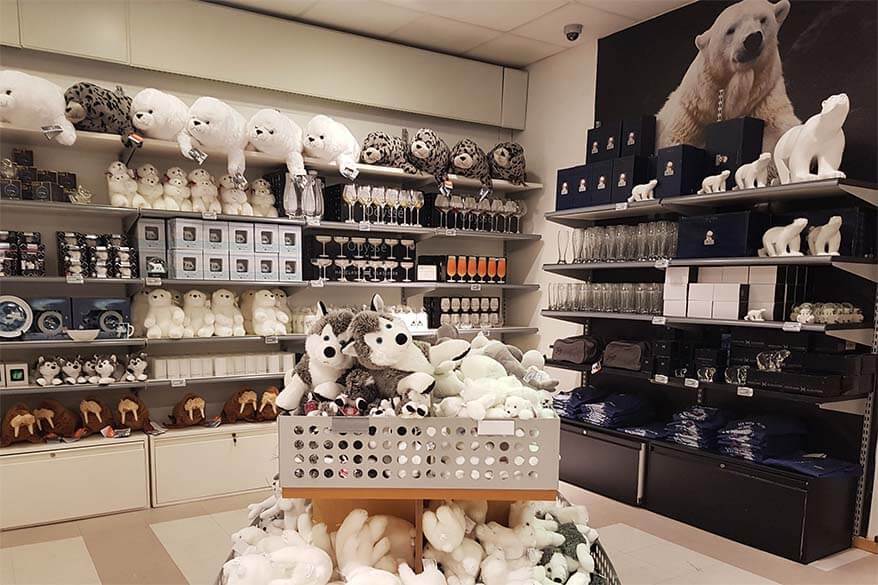
Money Matters & Travel Cost
Svalbard is part of Norway, so the currency used is the Norwegian Krone (NOK). That being said, you don’t really need cash in Svalbard and can simply use credit cards everywhere. Except in Pyramiden, where you will have to pay cash. From what I saw, most places in Barentsburg accept credit cards, but it might be useful to have some cash there too.
TIP: If you are traveling from outside of Europe, make sure that you have a credit card with a chip and a 4-digit pin. You’ll need that type of card everywhere in Europe. Ideally, you take Visa or Master Card as these cards are accepted everywhere.
One of the first questions I got from our readers about my trip to Svalbard was how expensive is it . However, this is also the most difficult question to answer. So much depends on the season when you’re traveling, how long in advance you book, and obviously on your choices (accommodation, restaurants, tours). Nevertheless, below is a short overview that should give you at least an idea of what to expect.
As you can imagine, Svalbard is not a cheap destination. The biggest costs are your flights, hotels, and tours.
- Flights . That depends so much on when you’re flying and from where. My return flights from Belgium to Svalbard in February were about 400 EUR.
- Hotels . Expect to pay about 200-300 EUR for a night at a good hotel in Longyearbyen (2 people, breakfast included). The cheapest hostel accommodation will cost at least 100 EUR for 2 people per night.
- Tours. This is what will make your trip to Svalbard really expensive because you can’t explore much on your own and always have to take tours. Count around 100-300 EUR per person per day.
- Food. Food prices are somewhat lower in Svalbard than in mainland Norway. Expect to pay about 20-30 EUR for the main course at dinner.
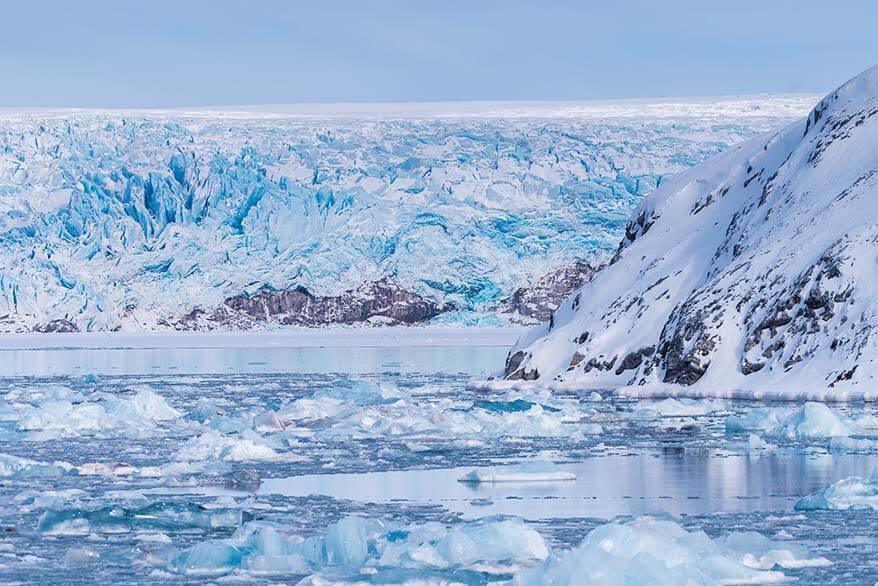
WiFi and Roaming Charges
You’ll be glad to know that Longyearbyen hotels provide free WiFi .
Furthermore, Svalbard uses the Norwegian cell phone network , which means that European roaming tariff regulations apply here as well. For me, it meant that I could use my Belgian SIM card just as I would at home or anywhere else in the EU, without any extra charges.
So, this is our travel guide with tips for visiting Svalbard. I hope that this article helped you form a better idea of what it’s like to visit Svalbard and what to expect. If you have any questions, leave a reply below.
If Svalbard is part of a longer trip to Norway, please check our Norway travel guide for more destination guides and practical information. We also have guides to Northern Norway , mostly Tromso and Lofoten .
Visit Svalbard: FAQ
The easiest way to get to Svalbard is by plane. There are frequent direct flights from Oslo and Tromso in Norway. In summer, you can also visit Svalbard on an Arctic cruise.
As an absolute minimum, we recommend at least 3 full days (4 nights) in Svalbard. This will give you enough time to explore Longyearbyen and do a few day tours to explore the stunning nature and wildlife. If your time and budget allow it, definitely stay a few days longer.
Svalbard is one of the most unique destinations in the world, so yes, it’s absolutely worth visiting. With vast landscapes, pristine glaciers, and a big variety of Arctic wildlife, Svalbard has a lot to offer. Plus, in winter you can experience the polar night and Northern Lights, and in summer – the midnight sun. It’s truly a bucket-list destination.
The best time to visit Svalbard depends on what kind of activities you are looking for. For the warmest weather, wildlife, hiking, and boat trips, visit between May and September. This is when the biggest majority of tourists visit Svalbard. However, winter months have a lot to offer too. If you want to see the Northern Lights – come between late September and mid-March. March-April are the best months for winter activities with enough hours of daylight to enjoy Svalbard to the fullest.
The best time to see the Northern Lights in Svalbard is from late September to mid-March. If there are no clouds and aurora activity is high, you can see the Northern Lights anywhere, also in Longyearbyen town. The biggest chance to see auroras is in the evenings, from 6 pm to midnight, but it remains a natural phenomenon so you never really know in advance.
With almost non-existing crime, Svalbard is a very safe place to travel. The biggest danger is wandering out of Longyearbyen on your own and getting lost or running into a polar bear. Svalbard is a place you have to visit with local guides.
Yes, you can walk around the main towns in Svalbard on your own, definitely in Longyearbyen. It’s normally safe and there is no need for special equipment for polar bear protection within town limits. However, always stay alert, and remember that most locals keep their houses unlocked so that you can always hide inside in case a polar bear would wander into town.
More tips for your trip to Svalbard:
- Activities: Things to Do in Svalbard in Winter
- Packing: What to Pack for Svalbard in Winter (October to May)
- Hotels: Where to Stay in Svalbard – Longyearbyen Hotels & Accommodation
- Snowmobile Tour in Svalbard: Review & Tips
- Svalbard Boat Trip
- Svalbard Dog Sledding & Ice Caves
If you found this post helpful, don’t forget to bookmark it and share it with your friends. Are you on Pinterest? Pin this image!

Image credits: personal collection and Depositphotos.com
This site uses Akismet to reduce spam. Learn how your comment data is processed .
Wednesday 26th of July 2023
Loved reading this as I am about to take off from Australia to embark on a voyage from Longyearbyen to the East Coast of Greenland , then on to Iceland. Your travel information is the best I have found so far. Thank You
Friday 28th of July 2023
Glad to help and thanks for your kind feedback, Christine. Have a wonderful trip!
Sunday 4th of June 2023
Were you able to spot Whales & walk in the ice caves too? :) Would love to hear from you.
Wednesday 7th of June 2023
Hi Aditi, I visited Svalbard in February. We went inside ice caves as part of a dog sledding tour - you can read all about it here. As for whales, the best time to see whales in Svalbard is in the summer - May to September. But you won't be able to visit any ice caves at that time of the year. Hope this helps.
Thank you for your detailed write-up, Jurga! :)
Glad to help.
Friday 9th of July 2021
Very informative and good details. Your travel blogs are fantastic and always pleasure to read through. Keep up the good work. Hoping to read many more. Thank you
Wednesday 21st of July 2021
Thank you, Mayur. Hope we can inspire you to visit some new places - Svalbard is truly one of a kind! Happy travels!
Tuesday 2nd of March 2021
Can I come to Svalbard without visa with a somali passport?
Thursday 4th of March 2021
Hi Cabdi, this is a travel blog so we cannot give you any advice in regards to visas or travel documents. Even if you don't need a visa for Svalbard, you'll probably need one for the countries that you pass in order to get there. Since most flights arrive via mainland Norway, you'll probably need valid visa for Norway. But I really don't know how it works for your country. For that, you should reach out to the official government sources. Good luck!

Svalbard Travel Guide: Tips & Itinerary for First-Time Visitors
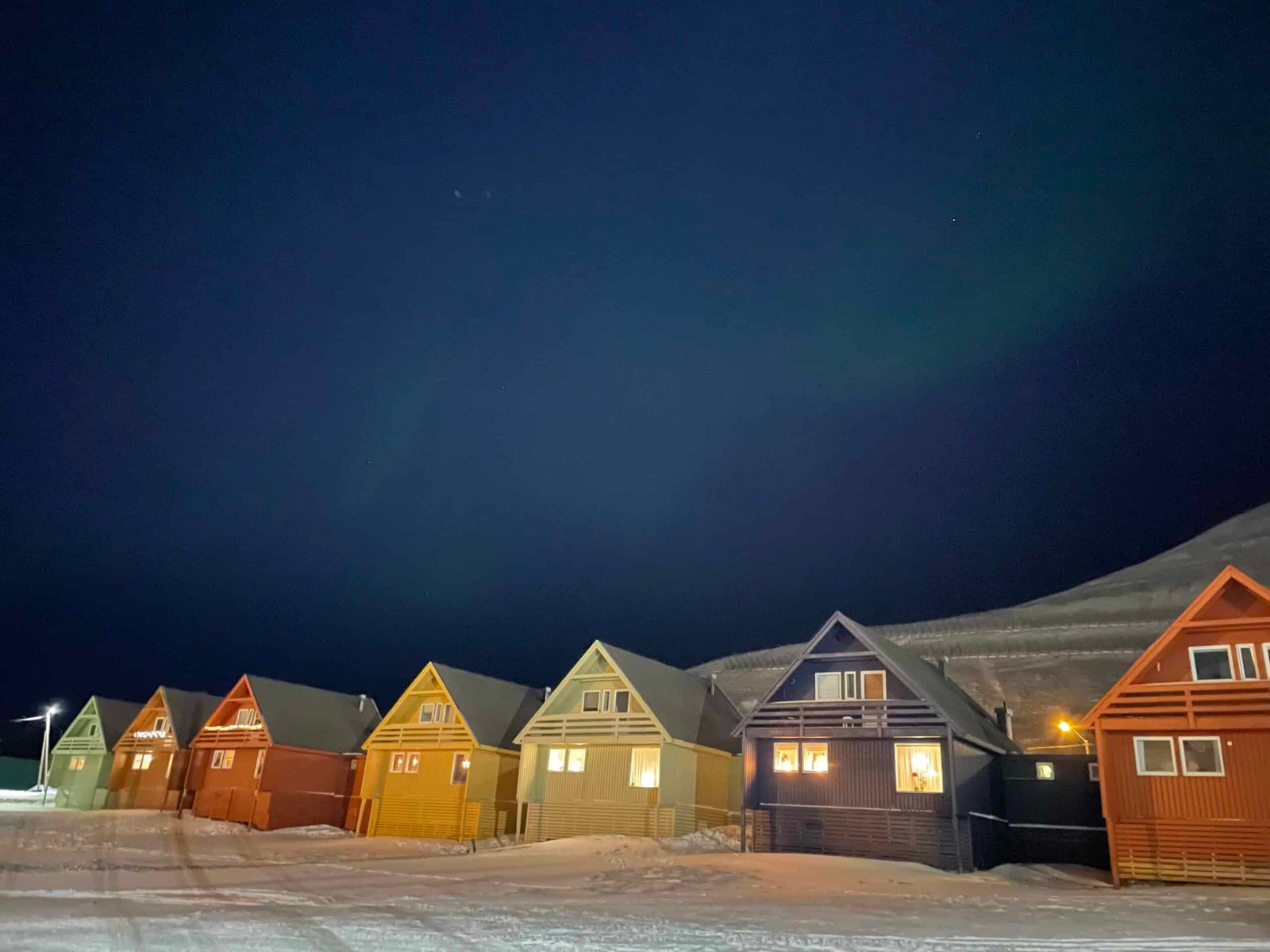
Hi there, welcome to Longyearbyen Svalbard , a place I have called home for the past 4 years. Through living in this Arctic wonderland, I’ve developed a profound understanding of outdoor adventures that I’m eager to share with you. I’ll provide you with the information and practical insights you need as you set off on this adventure to make sure you will have an incredibly immersive experience in Svalbard’s vast outdoors. I wrote a sample 5-day itinerary if you want to jump right off to it.
Key Tips For First-Time Visitors
When planning your first trip to Svalbard, there are several key tips to ensure you have a fulfilling and safe experience.
- Polar Bear Safety : Always travel with a guide or carry a firearm when venturing outside of Longyearbyen, as polar bear encounters are possible. Remember that polar bears are protected and should only be shot in direct life-threatening situations .
- Seasonal Considerations : Choose your visiting season based on what you want to experience. Summer (May-September) offers the midnight sun and relatively warmer weather, making it ideal for wildlife spotting and hiking. The polar night (October-February) is the time to see the Northern Lights, though they’re not guaranteed. Spring (March-April) is a transition period with the sun above the horizon, leading to noticeable changes in the environment .
- Clothing and Gear : Even in summer, Svalbard is cold, so pack warm clothes, including a jacket, hat, gloves, and winter shoes. Winter requires even more layers, and specific gear like a quality parka, thermal tights, legwarmers, sturdy boots, and mittens is essential. A headlamp is also recommended due to possible electricity blackouts .
- Transportation : Taxis are the best way to get around Longyearbyen, and there’s a bus service that operates around flight schedules. To explore other settlements like Barentsburg, you can travel by boat or snowmobile .
- Environmental Care : Svalbard has taken steps to reduce plastic waste, so you will see the efforts at many establishments. Visitors are encouraged to minimize their environmental footprint to help preserve the fragile Arctic ecosystem .
- Cultural and Historical Insights : To learn about Svalbard’s diverse history, from its dinosaur past to its mining era, a visit to the Svalbard Museum is highly recommended .
- Planning and Reservations : Book activities and dining in advance to avoid missing out, as spaces can be limited. This ensures you get to participate in the activities you desire and dine at the restaurants of your choice .
These tips are designed to help first-time visitors navigate the unique aspects of Svalbard and enjoy its many offerings responsibly and safely.
Introduction to Svalbard
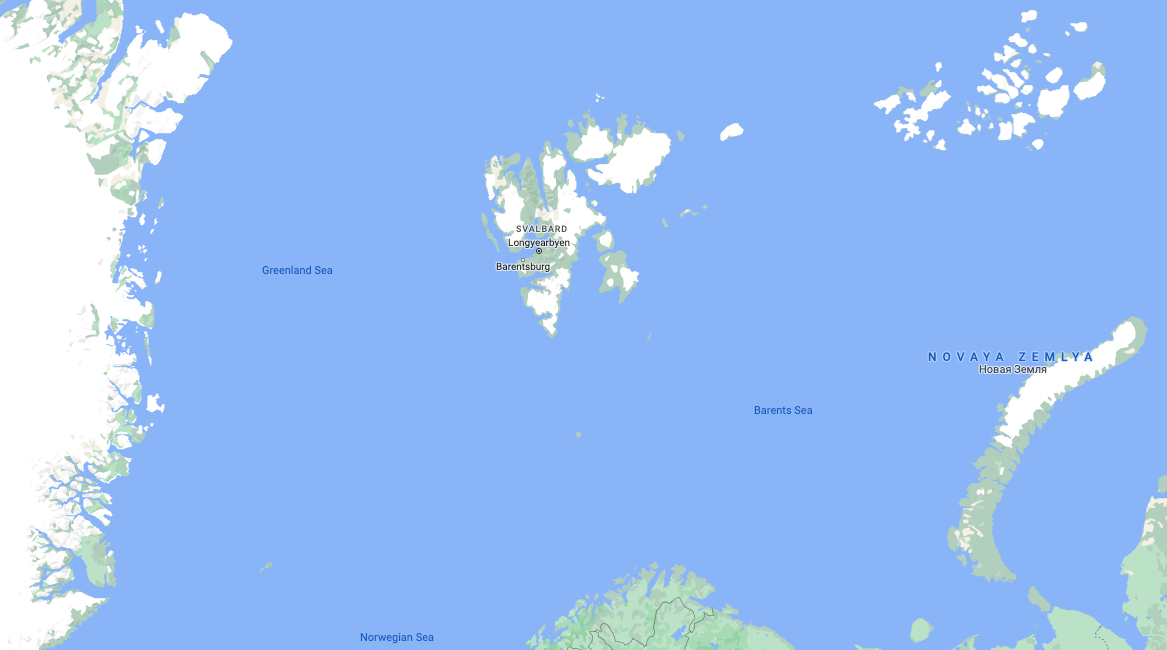
Svalbard is a Norwegian archipelago in the Arctic Ocean. It is in between mainland Norway and the North Pole. We are at 78degrees North. Around 1300km from the North Pole and is the world’s northernmost community with a population of 2596 as of Sep 2023 (both Ny Alesund and Longyearbyen).
Most of the residents are Norwegian but we have a very diverse community. Around 50 different nationalities live here and call this place home.
Svalbard is not just a place on a map; it’s an experience that defies expectations, where adventure isn’t just an option—it’s a way of life.
Why You Should Visit Svalbard
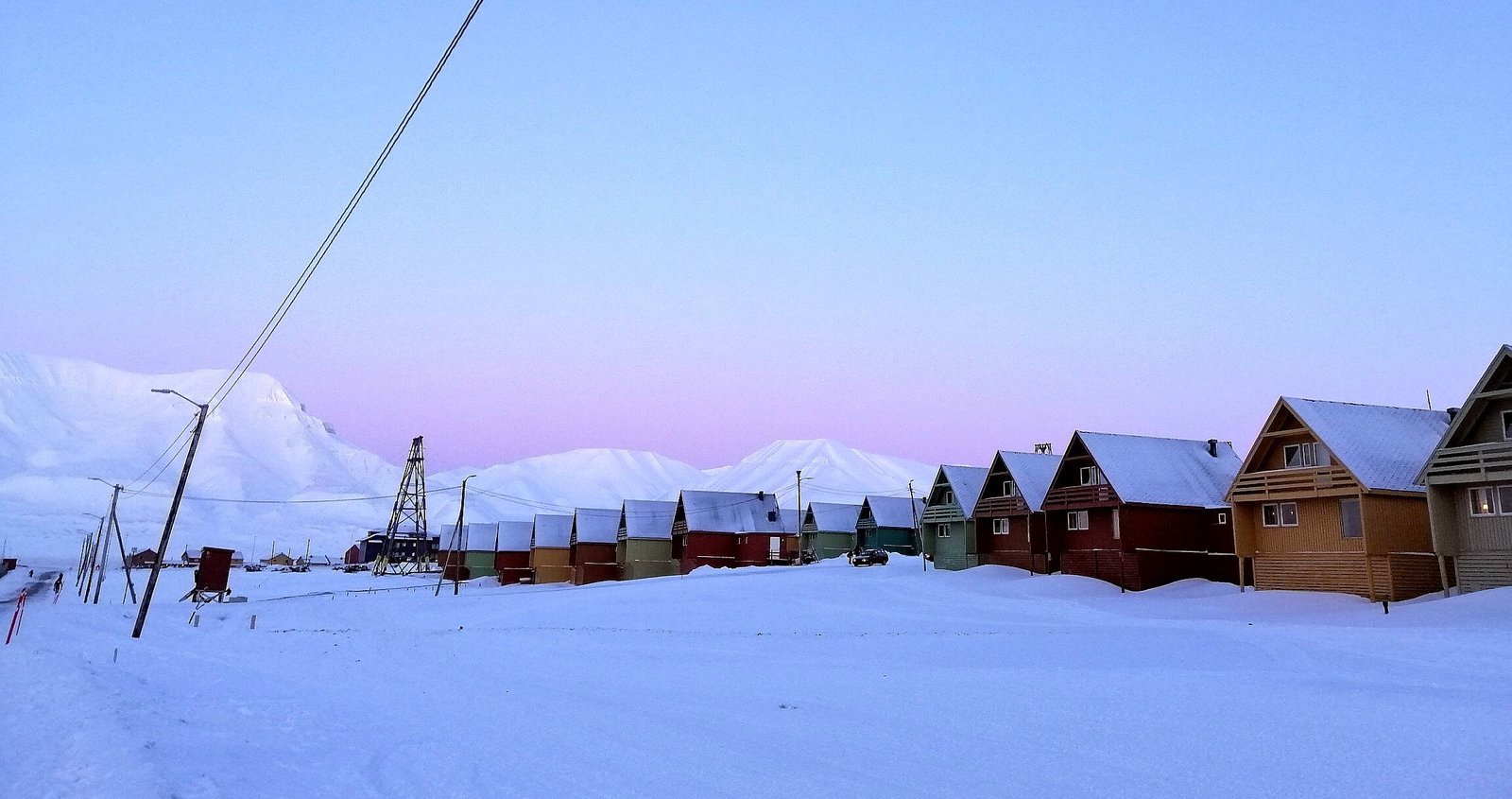
So, if you’re an adventurous soul who loves being outside, experiencing natural beauty, and really connecting with nature without any distractions, then Svalbard might just be the perfect destination for you. There are lots of options in winter or summer and I’ll talk about it more a little bit further down the article.
Svalbard may seem barren, but it has a lot of arctic wildlife like reindeer, walrus, seals, whales, arctic foxes, birds, and polar bears. It is also one of the last pristine wilderness that we have. Svalbard is 1.6x the size of Denmark or an area twice the size of Belgium and less than 2600 people, so just imagine the vastness of the outdoors here. It contains massive areas of raw Arctic wilderness.
And I guess the reason why the locals stay here, at least for me is, the Arctic silence creates an atmosphere that’s totally unique. You’ll experience a peace and quiet that’s almost unmatched anywhere else on Earth. Life feels simple here.
Interesting Facts About Svalbard
- Svalbard is home to the Global Seed Vault , sometimes referred to as the “Doomsday Vault,” which preserves a wide variety of plant seeds in an underground cavern. The Vault acts as a secure seed bank in case global disasters destroy key crops.
- Longyearbyen, the largest settlement in Svalbard, experiences the Midnight Sun from approximately April 20 to August 23 each year, when the sun doesn’t set at all. Conversely, during the Polar Night , from around October 26 to February 15, the sun doesn’t rise above the horizon.
- Despite its remote location, Svalbard has a remarkably international community. With a population of over 50 nations, it’s one of the most globally diverse places relative to its size.
- You can’t give birth here simply because the hospital is not equipped for that. So expecting mothers have to go to Tromso 2 weeks before their due date.
- Cats are banned from the island. Svalbard has a lot of areas where seabirds nest and even just a few cats could cause potential harm to the colonies. Cats can also spread diseases since they carry different parasites in their guts and intestines.
Preparing for Your Trip
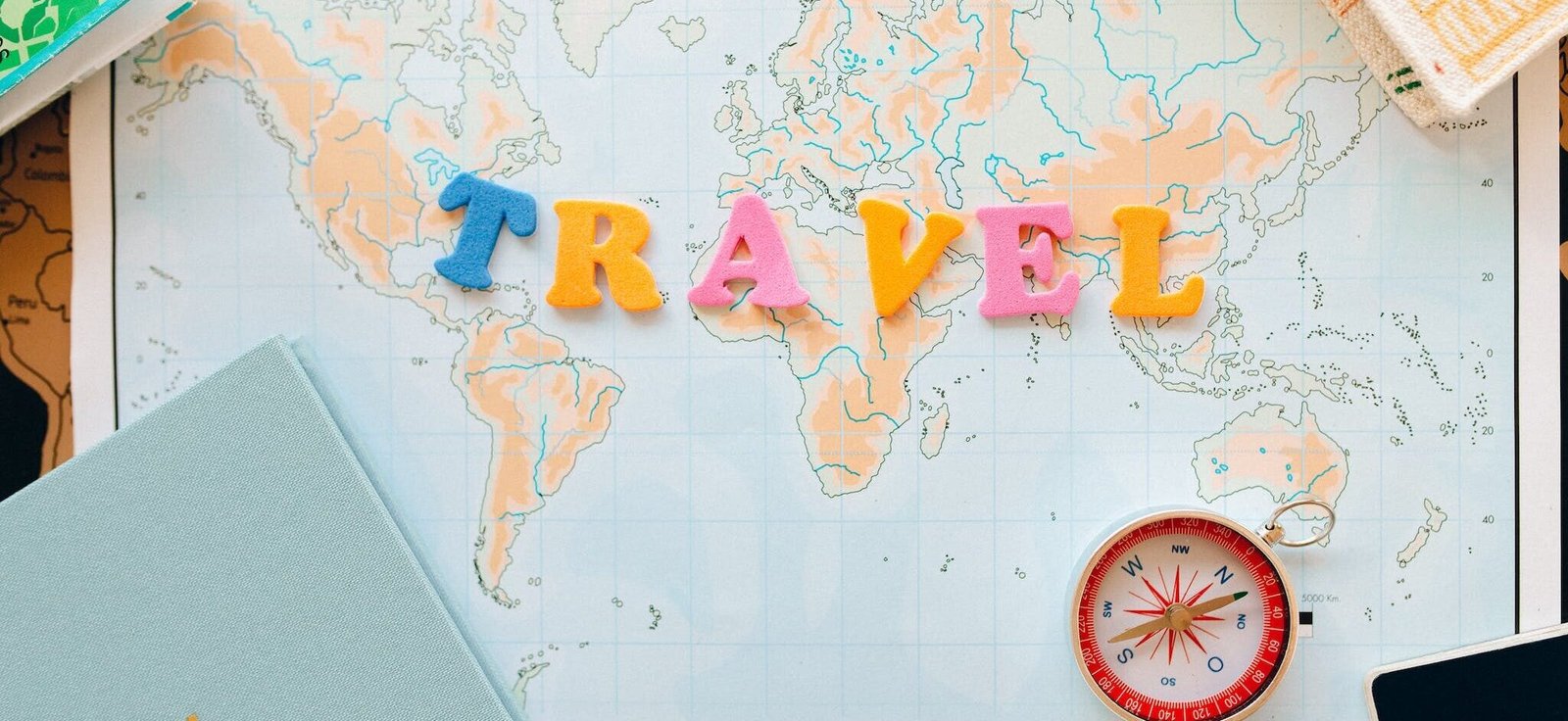
Visa and Entry Requirements
Before you pack your bags, let’s talk logistics. Svalbard is unique—there’s no visa requirement for entering , but there are some nuances. If you’re passing through mainland Norway, you’ll need to adhere to Norway’s visa regulations. It’s always a good idea to check the latest travel advisories before your trip.
How to Get to Svalbard
Reaching the edge of the world is simpler than you might think. Regular flights from Oslo and Tromsø bring you straight to Longyearbyen. But remember, the weather can be unpredictable, so plan for potential delays.

Best Time to Visit Svalbard
Timing is everything. Do you want to experience the 24-hour daylight ( midnight sun ) or the mystical northern lights? The Midnight Sun reigns from late April to late August, while the Polar Night (24-hour dark) lasts from late October to mid-February.
For wildlife and warmer temps, aim for the summer months. If the aurora borealis is on your bucket list, winter is your best bet. If you want to experience dog sledding, skiing, or go on a trip with a snowmobile, then spring season is the best time. Keep in mind, that each season offers a unique Svalbard experience, so choose what calls to you the most.
Costs and Budgeting for Your Trip
Svalbard isn’t a budget destination—expect high costs for accommodation, food, and activities. Plan your budget well in advance, considering tours, dining out, and any unique experiences like dog sledding or snowmobiling, which can add up quickly.
What to Pack: Clothing and Essentials for Svalbard Weather
Layers are your best friends in the Arctic. Pack thermal underwear, insulated outerwear, waterproof boots, and accessories like beanies and gloves. Don’t forget UV-protective sunglasses and sunscreen for the summer’s constant daylight.
Health and Wellness
Stay hydrated and well-nourished; the cold can deceptively dampen your thirst and hunger cues. Prepare for the physicality of Arctic adventures with pre-trip fitness, and always have emergency contacts at hand.
Environmental Responsibility
Svalbard’s beauty comes with fragility. Stick to designated paths, minimize waste, respect wildlife from a distance, and follow all guidelines for environmental conservation. Remember, leave no trace and take only memories.
Navigating Svalbard
Navigating Svalbard is an adventure in itself. Getting from one place to another is as much a part of the experience as the destinations themselves.
Getting Around: Transportation Within Svalbard
Longyearbyen is walkable, but for longer distances like to the airport or visiting the mines, taxis and buses are available. For exploring the wilderness and remote areas, snowmobiles reign supreme in winter, while boats are the go-to in summer. But always remember: when venturing beyond town limits, Svalbard’s safety rules kick in, so prepare accordingly and consider hiring local guides for the true Arctic exploration experience.
If you booked a guided tour, pick up and drop off is part of the package most of the time so you don’t have to worry about that.
Towns and Settlements
There are a total of 5 settlements here in Svalbard-Longyearbyen, Barentsburg, Pyramiden, Ny-Ålesund, and Hornsund in Southwestern Spitsbergen which houses a small Polish research station.
Longyearbyen

Longyearbyen is the largest settlement in Svalbard. It’s known for being the world’s northernmost town of its size, offering a surprisingly rich array of cultural and modern amenities. Despite its remote location, it has a university center, quality dining, and even its own brewery and chocolate.
Historically, Longyearbyen was established as a coal mining town by the American businessman John Longyear in 1906, which is how it got its name. Mining was the backbone of the town for a long time, but now it’s transitioning towards research, tourism, and education. The town has adapted to the Arctic life with unique quirks like removing shoes indoors to avoid dragging in coal dust, a tradition from its mining days. Despite the harsh climate and potential encounters with polar bears, our community is known for its resilience and hospitality.
Barentsburg
The second-largest settlement on Svalbard. It’s still a working mining town, though tourism is growing in importance. Unlike Longyearbyen, Barentsburg has a more Soviet feel, with its stark architecture and monuments from the Soviet era. It’s a place that feels like a step back in time, with its own cultural quirks, such as the Russian signposts and the Pomor Museum, which tells the story of Russian hunters from the past. Despite its remote location, Barentsburg has its own hotel, a few shops, and even a brewery that caters to both residents and visitors.
Pyramiden is an abandoned Soviet-era mining town on Svalbard, named after the pyramid-shaped mountain nearby. It was established by Sweden in the 1910s and sold to the Soviet Union in 1927. Pyramiden was once home to a thriving community, but it was abruptly abandoned in 1998, leaving behind buildings that are like time capsules of the Soviet era. Today, it’s a ghost town that attracts tourists for its eerie, well-preserved buildings, including the world’s northernmost statue of Lenin and a once bustling cultural center with a gym, library, and music hall. Visiting Pyramiden is like walking through recent history, seeing a slice of life preserved in the Arctic cold.

It’s renowned primarily for its research facilities; various countries have stations here to study arctic sciences, from biology to glaciology. This place has a rich history in polar exploration and was a starting point for several North Pole expeditions. Today, it’s a small international community of scientists and support staff, with usually fewer than 200 people living there at any given time. There are no permanent residents; people come here mainly for research purposes. Despite its focus on science, Ny-Ålesund retains elements of its past, including historical buildings and a post office that’s a favorite for sending postcards with a unique Arctic postmark.

The Polish research station in Hornsund, Svalbard, has a small but significant presence, with a total population of 12 people as of 2023. Established in 1957 by the Polish Academy of Sciences during the International Geophysical Year, the station was built on the flat marine terrace of Isbjørnhamna. Initially set up for summer research, it was modernized in 1978 to support year-round scientific activities .
Today, the station’s research encompasses a wide array of Arctic sciences. Full-year research includes meteorology, seismology, geomagnetism, ionospheric sounding, glaciology, atmospheric electricity, and environmental monitoring. These studies are crucial in understanding climate change, seismic activities, the structure of the ionosphere, and the dynamics of glaciers. Additionally, the station serves as a base for seasonal research in fields such as geology, geodesics, geomorphology, oceanology, and biology . Wikipedia
This outpost is a testament to the global scientific community’s commitment to studying and understanding the Arctic’s environment and its broader implications for the world.
Where to Stay in Svalbard?

Finding a cozy place to stay is an essential part of any travel experience, especially in the remote Arctic. In Svalbard, you’ll be pleasantly surprised by the range of accommodation options that provide comfort and warmth in contrast to the chilly wilderness outside.
We do have quite a few choices. Prices vary depending on the season so make sure to check out their website to get a more accurate quote. The prices I have indicated here were from this year’s summer season.
Radisson Blu Polar Hotel (2709 NOK) : Centrally located with big rooms and a fjord view. Perfect for unwinding after outdoor activities with its in-house pub and restaurant. It can get busy with tour groups.
Svalbard Hotel (2709 NOK) : Offers beautifully decorated rooms, complimentary breakfast, and a gourmet in-house restaurant, Polfareren.
Basecamp Hotel (3300 NOK) : A cozy, rustic hotel that mimics a High Arctic trapper’s hut. It includes a great breakfast and offers various excursions. Located centrally.
Mary-Ann’s Polarigg (1425 NOK/single room) : Converts old miners’ barracks into charming hotel rooms with a homey feel.
Funken Lodge (3847 NOK/night) : A short walk from downtown, this upscale hotel offers large, modern rooms and a French restaurant, blending luxury with adventure.
Coal Miner’s Cabins (1300 NOK) : Budget-friendly with a mix of shared and private bathrooms. It’s a 20-minute walk from the town center.
Gjestehuset 102 (1400 NOK) : A budget hostel close to Coal Miner’s Cabins with shared bathrooms. Situated in Longyear Valley, ideal for exploring the town from top to bottom.
Haugen Pensjonat (1600 NOK/night) : Just a 10-minute walk to the town center. Bright rooms with king-size beds and sofas, offering views of mountains or Longyearbyen and Adventfjorden.
Where to Eat and Drink

As nothing grows in this region, we don’t have a distinct local cuisine. Instead, our cuisine is a blend of different flavors and a variety of experiences, influenced by some elements from the Arctic.
Mary Ann’s Vinterhagen
Serves up local specialties, offering dishes made with reindeer, seal, and whale meat, Svalbard cod, etc. The hearty flavors of these meats and fish are a reflection of the traditional Arctic diet and are worth trying for an authentic Svalbard experience.
Is known for its relaxed atmosphere and historic touch. Here you can start with smoked minke whale before moving on to a hearty moose burger, blending traditional tastes with a touch of the familiar.
Offers a mix of traditional Norwegian food and international dishes. Here you can enjoy everything from succulent spare ribs to whale steak and fresh cod, providing a broad taste of Norway’s culinary offerings.
Restaurant Polfareren
Svalbard Hotel is where you can enjoy a gourmet meal without breaking the bank. The menu features Svalbard reindeer, whale, cod, and salmon, catering to those who seek a fine dining experience with a touch of the Arctic.
Restaurant Nansen
Provides a high-end dining experience with a menu inspired by the Nordic regions, including local Svalbard cod and reindeer .
Gruvelageret
Offers fine dining in a historic setting that reflects 100 years of coal mining history in Svalbard. The focus here is on genuine and honest food with elements from the Arctic, including reindeer dishes that start the meal off on an authentic note .
Huset Restaurant
Considered one of Norway’s premier dining experiences, focusing on Nordic techniques and local produce. It’s also known for one of Northern Europe’s most extensive wine cellars, boasting over 15,000 bottles. They serve ingredients primarily from the Arctic region, including bearded seal and ptarmigan, providing a true taste of Svalbard .
For those looking for more familiar options, Barentz Pub and Svalbar offer comfort foods like burgers and pizzas, perfect for those craving a taste of home amidst the Arctic surroundings. We also have cafes like Fruene and Cafe Huskies if you just want a light meal or a cozy spot for coffee.
In all these dining experiences, the emphasis on locally sourced ingredients is clear, and the Arctic influence is ever-present, ensuring that every meal contributes to a truly Svalbard experience.
Shopping and Supermarkets

Shopping in Longyearbyen offers a unique experience where you can find everything from practical outdoor gear to distinctive local handicrafts. Given its remote location, the variety of goods available is quite impressive.
Supermarket : We only have one supermarket up here-Svalbardbutikken, which resembles a typical European grocery store but with a broader selection of frozen goods to cater to the longer shelf life needed for remote living. Here, you can find a wide range of food items, from fresh fruits and vegetables to dairy, meats, and dry goods. The prices can be higher than on the mainland due to transportation costs. However, since we are in the Arctic, it’s not always a given that certain products will always be available.
Souvenirs and Specialties : For souvenirs, there are several stores where you can buy unique Svalbard-themed items such as postcards, stamps, books, and local art. These shops also sell outdoor clothing and equipment, catering to both the rugged needs of adventurers and the desire for comfort against the Arctic chill.
Local Handicrafts : The local crafts include items made from Svalbard reindeer and seals. It’s important to note that while these items are locally sourced and crafted, there may be restrictions on bringing them into certain countries, so always check customs regulations.
Alcohol and Tobacco : These items are sold at Nordpolet, located within Svalbardbutikken. Due to Svalbard’s duty-free status, prices for alcohol and tobacco are considerably lower than in mainland Norway, but there are strict regulations on how much you can purchase without a permit.
Activities in Svalbard
I’m just making a list of the things you can do in Svalbard. I’ll be writing a different piece with more in-depth information about it.

Spring Season (March- Mid May; Sunny Winter)
This is my favorite time of year. This time of day has the most beautiful sky. After living in the dark for three months, seeing the light again is like being reborn. And after that long darkness, locals are now eager to go outside and explore.
Dog Sledding : Whether it’s the dark season or the midnight sun, dog sledding is an authentic way to experience the Arctic. Mushing across the tundra offers a quiet and respectful way to witness the untouched landscapes.
Snowmobile Tours : Speed across the frozen landscapes and reach remote areas not accessible by foot. It’s a thrilling way to explore the vast wilderness and hunt for the Northern Lights during the polar night.
Glacier Hiking : Strap on some crampons and explore the blue ice of Svalbard’s glaciers. It’s a breathtaking experience that showcases the island’s dramatic frozen scenery.
Ice Cave Visits : Glaciers in Svalbard are a network of ice caves carved by meltwater, and the good news is that some are open for exploration. With the right gear like a headlamp, crampons, and a helmet, you can immerse yourself in the serenity of these ice formations, surrounded by stunning shades of blue, delicate icicles, and intricate snow crystals.
To reach the ice cave, you’ve got choices. You can go dog sledding and just let a husky team lead you there. Snowmobiles and snowcats offer a faster ride to the cave’s entrance or if you prefer not to join a group, you can also go skiing or snowshoeing. Pick your adventure based on the experience you’re after but always remember to have a local guide with you!
Nordic Skiing : If you visit during the colder months, cross-country skiing is a fantastic way to travel the snowy landscape and enjoy the pristine Arctic environment.
Summer Season (Mid May – September; Midnight Sun)
The 24/7 daylight. Others find that this is an excellent time for travel because they feel like they have lots of free time and vitality. However, for some people, falling asleep presents a challenge, so make sure to bring a sleeping mask with you when you visit up here during this season.
Hiking : Longyearbyen offers a range of guided hikes for all levels, each promising breathtaking views and expert guidance. You can do a guided hike with photography, or fossil hunting to find ancient plant fossils. Guides will share insights into the local history and geology as you enjoy a break.
Amazing hikes include the panoramic Plateau Mountain, Blomsterdalshøgda with views of the Global Seed Vault, or the glacier-crossing trek to Trollsteinen.
Boat Trips : During the summer, boat trips offer a unique perspective of the fjords, glaciers, and wildlife. Keep an eye out for whales, seals, and seabirds as you navigate the Arctic waters. There are choices of half-day trips, full-day trips, and multi-day excursions with expedition cruises around Svalbard.
Kayaking : Paddle in the silence of the Arctic, with the water as your path through fjords and beside glaciers. It’s a peaceful activity that connects you with the profound tranquility of the North.
Taxi Tours: The best way to get an overview of Longyearbyen. The driver can tell you about the history of Longyearbyen and some major local attractions.
Biking Tours: You can join biking tours in Svalbard that offer a glimpse of the Arctic’s natural beauty, complete with fjords, mountains, and potential wildlife sightings. You’ll pass by remnants of Svalbard’s mining past. With a guided tour you can benefit from expert knowledge and safety guidance, allowing you to make the most of the experience.
ATV Safari: You will drive a Can-Am Outlander ATV from Longyearbyen town out to the Advent Valley. If you’re lucky you might see some reindeer and arctic foxes among the rich bird life.
Fishing Trips: Svalbard’s fishing trips let you enjoy the dual pleasures of observing wildlife while fishing. You can catch cod and learn about the area’s fishing practices. Not always but you may also get a chance to see walruses and whales, during your fishing adventure.
Winter Season (October – February; Polar Night)
And of course, the polar night or dark season as most of us call it. For 3 months the sun doesn’t go above the horizon. Total pitch black outside. It is my least favorite season so I normally take my vacation during this time of the year. But it comes with an advantage. Because that means you can see Northern Lights no matter what time of the day it is.
Northern Lights Expeditions : Northern Lights tours in Svalbard during winter are a prime attraction, offering a chance to witness the aurora borealis in one of the few places on Earth where it’s visible. Options range from snowmobile and dog sled excursions to stationary observatories, for both active and relaxed observation. The tours are guided by experts who can not only help locate the best views but also explain the science and folklore behind the northern lights.
Snowmobile trips (shorter ones) : Snowmobile trips in Svalbard during winter are a thrilling way to explore the Arctic landscape, including destinations like the Iron Beds, Brattadalen, and Colesdalen. The iron beds give a glimpse into Svalbard’s mining history, Brattadalen offers wide valleys with a chance of spotting wildlife, and Colesdalen features stunning ice formations. All tours are led by experienced guides who prioritize safety and provide all necessary equipment.
Dog Sledding : This guided excursion provides all necessary equipment and typically includes warm clothing to ensure comfort against the Arctic chill. Dogsledding during this time not only offers an authentic Arctic experience but also a chance to connect with the quiet and majestic nature of Svalbard’s wilderness.
All Year Round
Visit the Global Seed Vault : While you can’t go inside the vault itself , you can see the entrance to this crucial global initiative, which preserves a wide variety of plant seeds from around the world.
Cultural Experiences : Visit the Svalbard Museum to learn about the history and nature of the archipelago, or catch a performance at the world’s northernmost cultural center. Or drop by the North Pole Expedition Museum which houses an extensive collection of artifacts, photographs, and stories documenting the heroic efforts of North Pole expeditions throughout history. It’s an inspiring visit that offers a deeper understanding of polar exploration and the immense challenges faced by adventurers in the Arctic.
Photography Tours : With its unique landscapes and lighting, Svalbard is a photographer’s dream. Guided tours can help you capture the perfect shot, whether it’s wildlife, auroras, or midnight sun vistas.
Local Brewery Tour : The tour explains the history of alcohol law in Svalbard, and the process of making beer in such an extreme Arctic environment, and includes a tasting session of the various beers produced on-site. This tour requires booking in advance and provides an opportunity to purchase brewery merchandise and bottled beers to take home.
Practical Information

Flights to Longyearbyen
Norwegian Air and SAS are the two airlines that fly up here a couple of times a week. Sometimes the flight frequency increases up to twice per day during high season, from March to August, so plan accordingly.
WiFi and Cellular Data
Most hotels, restaurants, and public spaces in Longyearbyen offer free WiFi to customers. Svalbard is special in so many ways. Some rules from mainland Norway apply and some don’t. But luckily the EU mobile phone roaming regulation also applies up here. So travelers from the EU don’t need to worry about roaming charges. But for others, roaming charges can be high so always check with your service provider.
Currency and Payments
The Norwegian Krone (NOK) is the currency used in Svalbard. Card payment is the primary method of payment since we do not have a bank here anymore. Not all establishments accept cash payment .
Shopping Hours
Shops in Longyearbyen have limited hours, especially outside of the tourist season, so plan accordingly. The supermarket has broader hours, but don’t expect the 24/7 services found in larger cities.
Safety Precautions in Svalbard
Safety here goes beyond packing a first-aid kit. Due to polar bear risks outside settlements, always have a means of protection and an experienced guide. Avalanches and glaciers also pose dangers, so heed local advice and stick to marked trails.
Average Daily Costs in Svalbard :
Living and traveling in Svalbard can be expensive. On average, a budget traveler might spend around 1500-2000 NOK per day, staying in hostels and self-catering. Mid-range travelers can expect to spend about 2000-3000 NOK per day for a hotel room, meals at restaurants, and some activities. For a more comfortable experience with tours and dining, expect to spend upwards of 3000 NOK per day.
This, of course, is just an estimation. The total cost will depend on how and when you want to spend your time up here. I have included a list of tour companies below so you can plan ahead of time.
- Henningsen Transport and Guiding – for boat tours along the fjord during the spring and summer seasons.
- Hurtigruten Sv a lbard – all-year-round tour provider
- Svalbard Adventures – all-year-round tour provider
- Basecamp Explorer – offers day trips, overnight trips, and expeditions
- Svalbard Wildlife and Expeditions – most of the tours they offer are during summer and on small groups
- Better Moments – offers snowmobile trips in the winter and boat, kayak, and hiking trips in the summer
- Backyard Svalbard – specializes in ski touring with certified guides
- Svalbard Husky – specializes in short and long expedition trips through dog sledding
- Green Dog Svalbard – short and multi-day dog sled expedition
How much time do you need in Svalbard?

Depends on your interests, budget, and the activities you plan to do. In my opinion, If you plan on doing 3 activities, you need 5 days because most of the activities start early morning . You can squeeze in the sightseeing tour or short hikes on the day you arrive or before you leave.
A short stay of about 3-4 days can be sufficient for exploring Longyearbyen, participating in a few activities like dog sledding or a snowmobile tour, and perhaps a quick day trip around the area.
If you’re interested in more extensive experiences, such as boat trips to remote areas, overnight snowmobile trips, longer dogsled excursions, or hikes during the summer, a week to ten days could be more appropriate.
For those looking to immerse themselves in the Arctic environment, engage in specific wildlife watching, or undertake scientific or photographic work, you might want to plan for even longer, up to a couple of weeks or more. Always keep in mind the seasonal variations, as they can greatly affect the types of activities available and the experience during your visit.
Sample 5 days Itinerary in Svalbard
Day 1: arrival and longyearbyen exploration.
- Arrive in Longyearbyen and check into your accommodation.
- Spend the afternoon exploring the town, visiting the Svalbard Museum to learn about the region’s history and natural environment.
- Enjoy dinner at a local restaurant and get your first taste of Arctic cuisine.
Day 2: Dog Sledding Adventure
- Embark on a half-day dog sledding trip to experience the Arctic wilderness. Learn to mush your own team of huskies.
- In the afternoon, visit the Svalbard Art Gallery and the North Pole Expedition Museum.
- Relax in the evening with a craft beer at Svalbard Brewery.
Day 3: Snowmobile Tour to the Wilderness
- Gear up for a snowmobile tour, which is a quintessential Svalbard activity. After a safety briefing, you’ll ride through the stunning Arctic landscape, exploring frozen fjords and valleys.
- Stop for a warm lunch at a remote cabin and enjoy the silence of the wilderness.
- Return to Longyearbyen in the afternoon. Rest or explore more of the town at your own pace.
- For dinner, relax at a local eatery with comfort food to wind down after an exhilarating day.
Day 4: Fjord Cruise, Wildlife Watching, and Ice Caving
- Begin your day with a boat tour to explore the majestic fjords. Keep your eyes peeled for wildlife such as seals and seabirds, with the melting ice providing opportunities for unique sightings.
- After returning from the cruise, refuel with a quick lunch in town.
- In the afternoon, join a guided tour of an ice cave. Discover the intricate beauty of ice formations and learn about the glaciers that shape Svalbard’s landscape.
- Spend the evening reflecting on your day’s adventures over a leisurely dinner featuring local ingredients.
Day 5: Leisure Day and Departure
- Spend your last morning in Svalbard at leisure. Consider a casual walk around town or a visit to the local greenhouse.
- Check out of your accommodation and catch your flight home, or continue on to your next destination.
Remember to book all activities in advance and stay flexible, as weather conditions can change plans in Svalbard. Always follow your guide’s advice for safety considerations, especially regarding wildlife and terrain.
I will be writing more about Svalbard and will update this page from time to time. You could also go to visitsval bard.com for any information you did not find here. That’s all for now and hope to see you around!
Cherie Gonzales
Cherie is an outdoor enthusiast who moved from a tropical area all the way to the Arctic to experience raw nature. She works for an expedition tour company in Longyearbyen, Svalbard. She understands the challenge of finding the ideal outdoor gears that fits your budget and needs. With so many choices available, her goal is to simplify the selection process.
Similar Posts
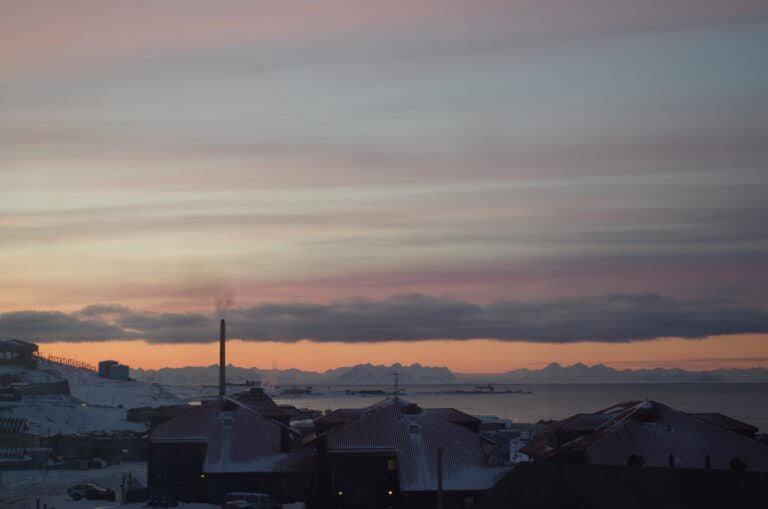
Insider’s Guide: Top 10 Tips for Traveling to Longyearbyen
Greetings, Arctic adventurers! If you’re gearing up for a journey to Longyearbyen, the heart of Svalbard, you’re in…
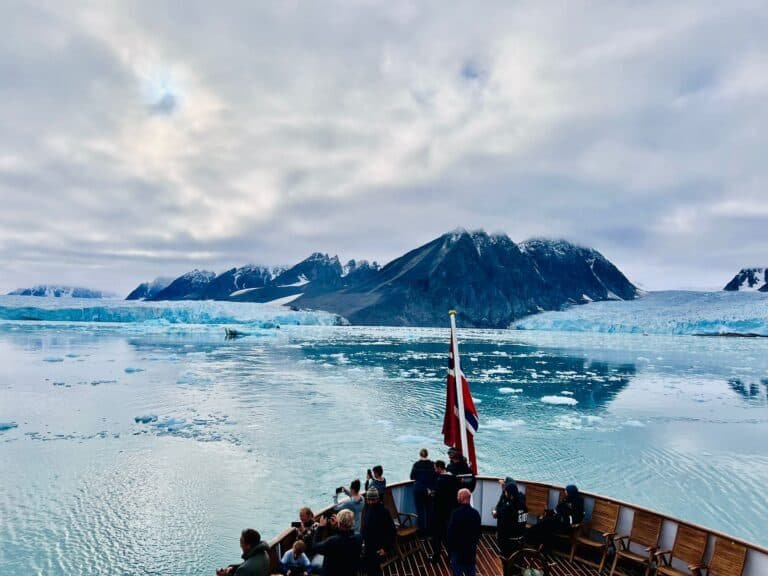
6 Best Arctic Cruises: Adventure and Wildlife in 2023
If you’re someone who enjoys outdoor activities and the excitement of exploring new places, then Arctic cruises may…

Exploring the Arctic Beauty of Svalbard
Discover the breathtaking beauty of Svalbard, an Arctic paradise. Explore its stunning landscapes, majestic glaciers, and unique wildlife.

Arctic Adventure Essentials: What To Prepare
Explore Arctic Adventure Essentials for outdoor enthusiasts, featuring layering tips, footwear advice, and gear to tackle extreme weather.

Living in Longyearbyen: A Simple Guide to Life Above the Arctic Circle
Looking to move to a unique and remote location? Longyearbyen, a small town situated above the Arctic Circle,…

Longyearbyen: Arctic Adventures and Sustainability Goals
Explore Longyearbyen’s Arctic adventures, sustainability goals, and unique challenges as this northernmost settlement combats climate change.
Thanks for visiting nordicvisitor.com! For the very best browsing experience on our website, we urge you to upgrade to the most recent version of your browser . Some of our site features may not function properly on older versions.
- Search Suggested Results View All Results
- EUR (€)
- GBP (£)
- Self-Drive i
- Privately Guided i
- Guided Small Groups i
- Northern Lights i
- Honeymoon & Romance i
- Ice & Snow Hotels i
- Multi-Country Tours i
- All Travel Styles
- Show all tours
- Best Sellers
- Special Offers
- Scandinavia
- Switzerland
- United Kingdom
- Book With Confidence i
- Why book with us i
- Travel Update
- Booking Terms i
- Sustainability Policy i
- Manage Booking
- Privacy policy
Iceland Bíldshöfði 20 110 Reykjavík +354 578 20 80 View Map
Sweden Scotland View Details
So you want to go to Svalbard?
This is not your typical winter destination, that's for sure. While others may jet off to winter-sunny Thailand or Tenerife in mid-February, one brave Nordic Visitor explorer set off to the equally exotic (though slightly colder and darker) archipelago of Svalbard , the northernmost territory of Norway.
If you're looking for a real adventure, this is the place. And I mean REAL adventure.
Today we're chatting with Sindre , one of our travel consultants who specialises in Norway. After a few days of scouting new experiences for Nordic Visitor travellers , he returned to our Iceland office with some excellent stories, Svalbard travel tips and — we must admit — some envious bragging rights. Read on in the interview below...
- Think you can handle Arctic Norway? Check out our Svalbard travel packages
NV: Besides bragging rights, why should someone go to Svalbard?
Sindre: "If you're looking for a real adventure, this is the place. And I mean REAL adventure. There is no town further north anywhere in the world than Longyearbyen, and you share the area with wild polar bears.
"The tranquillity of this archipelago cannot be found in many places on earth, besides at the poles of course. Svalbard is like the doorstep to the North Pole, so imagine how close you are. Also, at this time of the year the aurora borealis can be seen in daytime due to the polar day phenomenon.
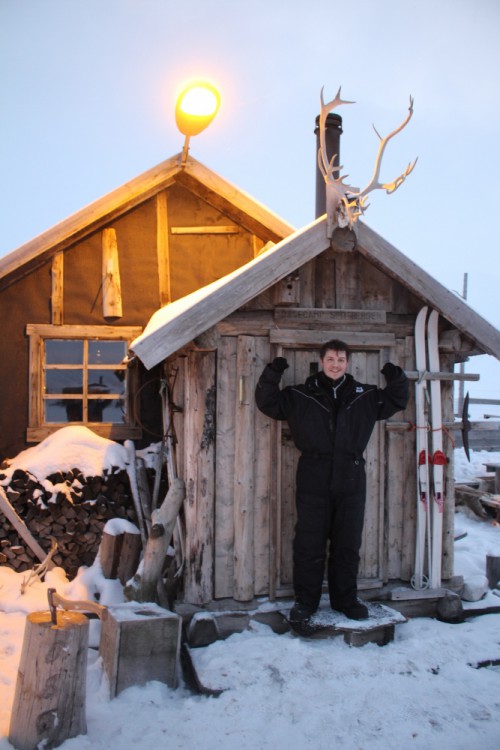
"And being in the Arctic means there are plenty of incredible activities to take part in, with people who are true professionals and wilderness experts. The guides here have great local knowledge and they always carry flare guns and rifles to protect against polar bears and make you feel safe at all times.
"For each excursion we had a briefing first to go over the safety rules and route plan, and for the snowmobile tours they checked if we all had valid driving licences. Otherwise you will not be allowed to drive one."
NV: Tell us more about the polar bears. Any advice?
Sindre : "Before your trip it's good to brush up on what to do if a polar bear gets a little too close for comfort , like not panicking and running for example. But of course your guides in Svalbard know what to do and will give you more information in the briefings.
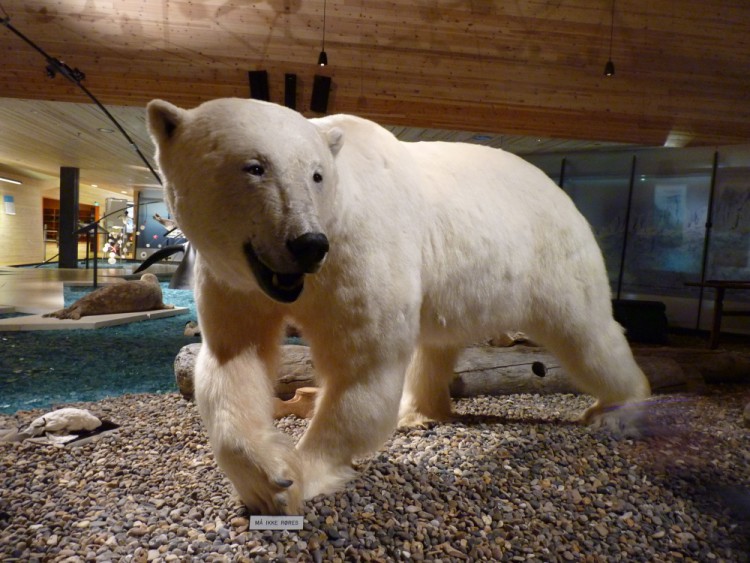
"But you should't be too scared — the locals are actually more afraid of having to shoot a polar bear than the polar bear itself. They have been protected by law since 1973 and it's strictly forbidden to hunt and kill them. I'm surprised how long ago they started to protect them."
In my opinion this is the best place to go see the aurora borealis .
NV: What else should visitors do in preparation for a trip to Svalbard?
Sindre: "Get wool clothing and then some more wool clothing! You really need warm clothing from top to bottom, and no layers can be skipped.
- Read more about packing plenty of layers for Svalbard
"Besides polar bear protection, the tour guides also provide you with necessary safety gear and outerwear for your activities. But underneath the snowmobile suit and helmet, you need to come prepared.
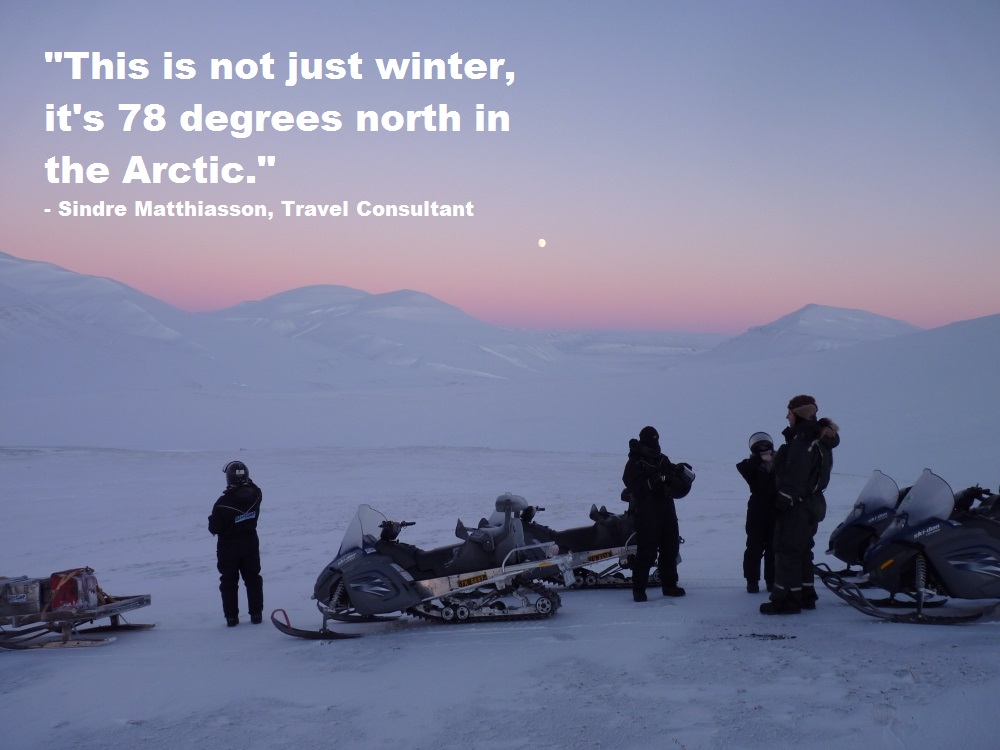
"Watching BBC's Frozen Planet is also a fun way to get an understanding of where you are going. This is not just winter, it's 78 degrees north in the Arctic."
NV: How many people were in your group for excursions?
Sindre: "There were six of us in my group, and for the snowmobile trip we had one guide, Ola. For the 2-day dogsledding trip , there were the six of us and then three guides: Kristin, Jukka and Stian. Plus the 56 huskies that also worked as the polar bear guards during the night.
"Kristin knew every dog like they were hers. Besides working with well over 100 dogs, she has 12 of her own!"
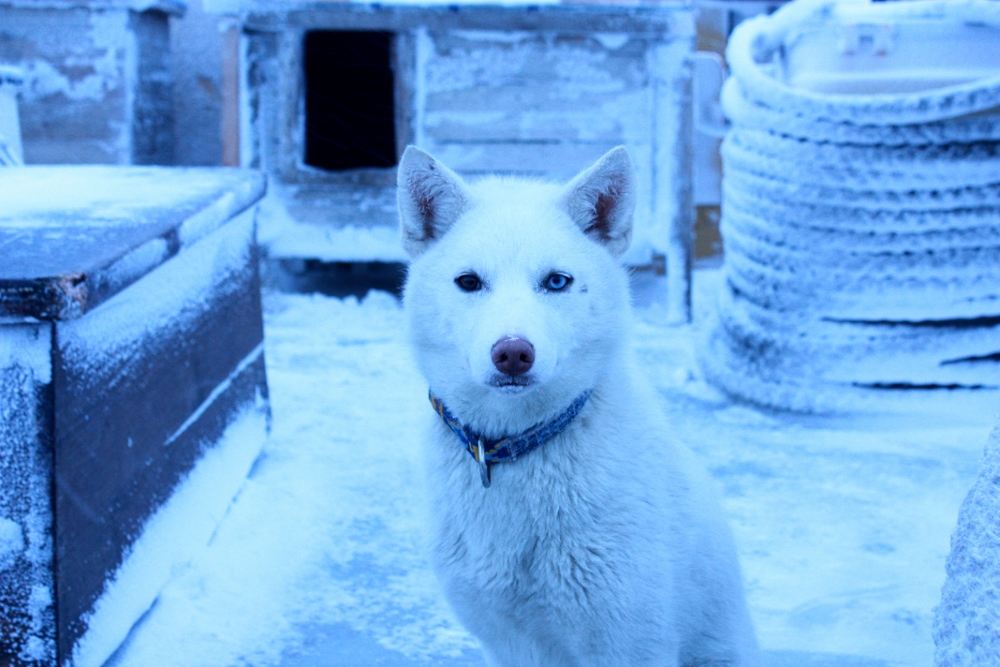
- Don't go barking up the wrong tree! View our dog-sledding tours in Arctic Norway & Svalbard
NV: Can you tell us what being in "polar day" is like?
Sindre: "In mid-February the sun still doesn't come up completely over the horizon during the day in Svalbard, so there is a soft, low light from 08:00 to about 16:00. You can see the moon throughout the whole day and with snow covering all land, it makes the days brighter.
"This dark period, which lasts for about three months over winter, is tough on the locals, but the midnight sun in summer equals it out somehow.
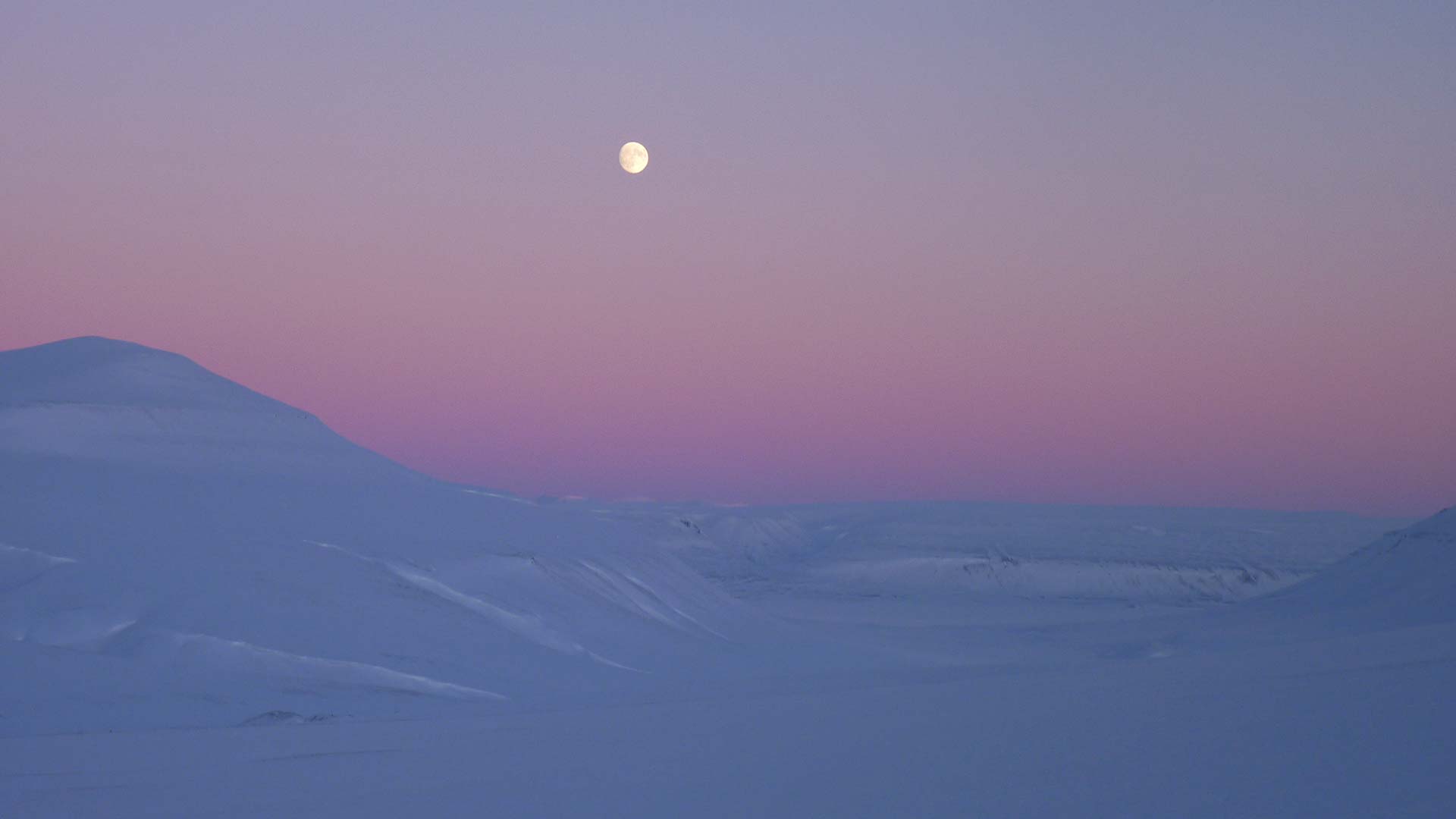
"They also see the northern lights a lot through this period. There is little-to-no light pollution here, so it gives you a great chance to see the best light show on the planet.
- View our aurora borealis travel packages in Svalbard and Arctic Norway
"Since it's pitch black and the moon is out 24/7, you can even see northern lights in day time! This is quite unique and you can stay in Longyearbyen to see it. Sometimes you don't even have to leave your hotel room to enjoy this phenomenon. In my opinion this is the best place to go see the aurora borealis ."
NV: How about the accommodations at 78 degrees north?
Sindre: "It's got everything from comfort-level hotels to tent camping, and on this trip I got to try both! Svalbard overall has some interesting lodging options.
"Notable accommodations are the Noorderlicht hotel-ship frozen in sea ice [winter only] and Isfjord Radio , a place with a long story. It had been important for ships and air traffic and also for telecommunication since it was built in 1933.
"When fiber optic cable was connected between Svalbard and the mainland [Norway] in 2004 it was no longer needed as a communications base. So today it's used for accommodation, and it's quite comfortable and of high quality. Some locals even go there for a nice dinner or just to have a relaxing getaway.
"But, as wilderness and nature rule up here, our planned trip to Isfjord Radio was unfortunately cancelled. There was no sea ice at the time, so it was not possible to get there by snowmobile and there wasn't enough snow on the route to get there with dog sleds."
NV: Sounds like nature rules in Svalbard. Any advice on preparation?
Sindre: "You always have to stay flexible with your plans in the Arctic. Instead of spending the night at Isfjord Radio as planned, we went on a 2-day dog sledding trip to Reindalen, where we had enough ice and snow.
"It was so amazing to let the dogs lead the way into the wilderness, and so authentic. It was a lot of fun having huskies as 'the machinery' and for companionship.
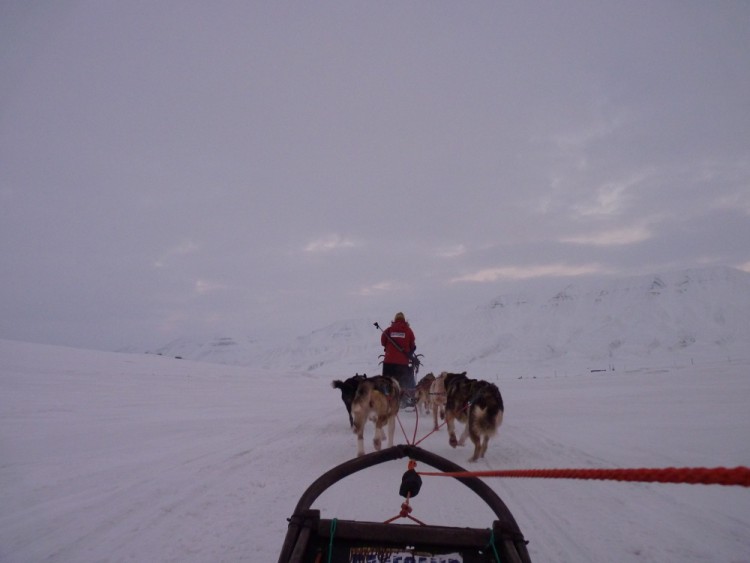
"We went over a mountain pass climbing to an altitude of about 400 metres above sea level. And at the top we had a light lunch and let the dogs rest for a while. After this we went full speed downhill and as we entered Raindalen all of us where speechless.
"The scenery was breathtaking, even for me, who as seen a lot of snow, ice and mountains in my life. We made it to the camp before full darkness and made dinner for the huskies, and then for ourselves once the dogs settled down.
"We spent the night in tents, surrounded by polar bear protection, our 56 dogs and raw nature. The only connection to the outside world was a satellite phone. The next morning we had to pack down our tents and get going early as there was some bad weather coming, but everybody chipped in and we got a nice and early start of sledding back to Longyearbyen."
NV: Thanks, Sindre. We think you've earned your bragging rights!
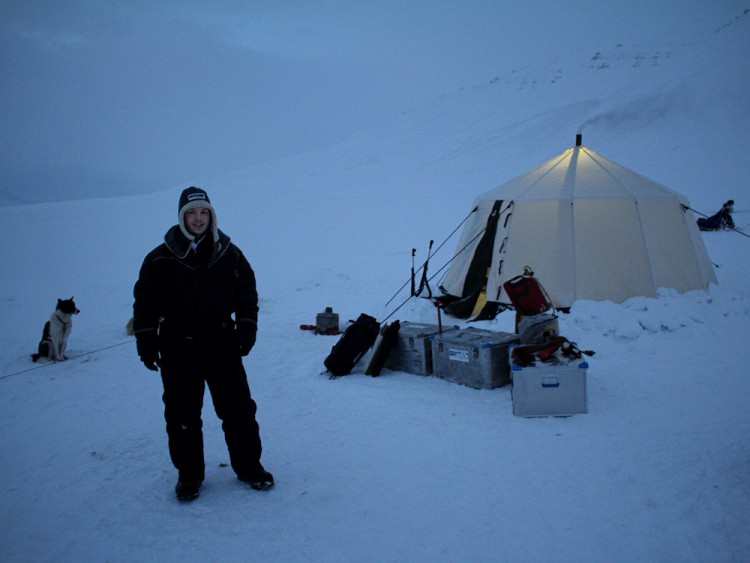
Why not bring your own impressive stories back from Svalbard?
You don't even have to sleep in a tent to do it. If you like the looks of Sindre's trip but want to stick to sleeping in hotels, then check out Nordic Visitor's 4-day Svalbard Winter Tour package for all the details.
If you have something else in mind, contact us for an exciting and customisable selection of travel packages to take you to Svalbard .

When not writing about Northern European tourist attractions, Jessica Bowe is busy daydreaming about her next trip or scouring Instagram for travel inspiration. Originally from Wisconsin (USA), she's lived in Iceland since 2008 and has since become fully immersed in Eurovision mania and Scandinavian coffee culture.
Find Jessica on LinkedIn .
Thanks for visiting nordicvisitor.com! For the very best browsing experience on our website, we urge you to upgrade to the most recent version of your browser . Some of our site features may not function properly on older versions.
Norway travel update
- Search Suggested Results View All Results
- EUR (€)
- GBP (£)
- Fjord Cruise & Train i
- Self-Drive i
- Guided Small Groups i
- Northern Lights i
- Coastal Cruises i
- Norway in a Nutshell® i
- Lofoten Islands i
- All Types & Themes
- All Norway Tours
- Best Sellers
- Book With Confidence i
- Why book with us i
- Travel Update
- Booking Terms i
- Sustainability Policy i
- Norway at a Glance i
- Useful Information i
- Norway Attractions i
- Norway Blog i
- Scandinavia
- Switzerland
- United Kingdom
- Manage Booking
- Privacy policy
Iceland Bíldshöfði 20 110 Reykjavík +354 578 20 80 View Map
Sweden Scotland View Details
Svalbard Tour Packages
An escape to Svalbard promises to be an adventure you’ll never forget! Journey to this Arctic archipelago in winter to chase the northern lights, or travel in summer for the midnight sun. These Svalbard tours include your accommodation, guided excursions and airport transfers, all arranged by your own dedicated travel consultant.

2 tours available
Prices per adult based on bookings for two
- Northern Norway tours
- Lofoten Islands tours
- Lapland holidays
- Greenland summer tours
OTHER WAYS TO EXPLORE NORWAY
- Small group tours of Norway
- Norway self-drive tours
- Cruise trips in Norway
- Norway train & cruise tours
Sorry, we found no tours matching your criteria.
Try adjusting or clearing your filters
Best of Svalbard Winter - Express
Best of svalbard winter - complete, need any help so far get in touch with us.
Live chat with travel consultants
Send your queries using our contact form
Call us toll-free to ask your questions
About Your Svalbard Tour
Whether you’re whizzing across snow-dusted landscapes or learning to drive a dog sled, you can expect the extraordinary in Svalbard. What’s more, exciting activities like this are already included in your tour package. With insider knowledge from your local guides, you’ll get the most out of your trip to Arctic Norway.
When you book a partially guided tour of Svalbard with Nordic Visitor, you’ll get: • An authentic travel experience operated by a trusted company • A dedicated travel consultant who will arrange your entire trip • Excursions led by experienced professional guides • Handpicked accommodation for a relaxing stay • 24/7 phone support during your trip for peace of mind
Nordic Visitor has made it easy to plan your Svalbard holiday. Begin your adventure by following these simple steps: 1. Pick your favourite Nordic Visitor tour 2. Confirm your package 3. Check your confirmation email 4. Book your flights 5. Get ready for your trip
Why Choose Nordic Visitor

Trusted local travel experts
Established in 2002, Nordic Visitor has been designing tours in Northern Europe ever since. Using their insider knowledge of Svalbard, your regional travel consultant will arrange your trip for you. What’s more, you can rest easy knowing that each part of your package is quality-tested by us.

Great reviews
Nordic Visitor is dedicated to the best service quality, and this is reflected year after year when TripAdvisor awards us with their Certificate of Excellence . We also take great pride in our customer feedback: 97% of our travellers say they would recommend us to friends and family.

You are in good hands
You can reach us 24/7 throughout your trip. If anything unforeseen crops up, get in touch and a travel expert will be available to assist you. This includes minimising any disruption to your itinerary. So you can explore with confidence, safe in the knowledge that support is just a call away.

Hassle-free experience
Pick any of these Nordic Visitor Svalbard trips and we’ll take care of the details for you. Your dedicated travel consultant will book your accommodation, guided excursions and airport transfers before you get there. This means that from the moment you touch down, your experience will be seamless.

Full financial protection
With Nordic Visitor, you have peace of mind knowing your tour arrangements with us are 100% financially protected. Your payments are safeguarded as we comply with European Union laws on Package Travel regulations. This guarantees you a refund in the unlikely event of insolvency.
Customisable tour options
These Svalbard tours already include handpicked activities, but we know that your travel wish list is unique to you. So why not personalise your itinerary with optional extras, such as guided hikes or snowmobile rides? Plus, you’ll have the option to extend your stay with additional nights.
Customer Reviews
Nordic Visitor may be a new name in Svalbard tourism, but we’ve been around for a while in the Nordic countries. In Norway and beyond, we’ve established a great reputation with our local suppliers and guests from all over the world. It won't be long until you can read new reviews here! Maybe yours will be next?
Your Svalbard Vacation Highlights
Dazzling ice caps and rugged fjords are waiting for you in this remote archipelago where the polar bear is king. Visit Svalbard and you could…
- Spend time in Longyearbyen , the most northerly town in the world
- Chase enchanting and colourful displays of the northern lights in winter
- Go wildlife-watching on Spitsbergen , home to Arctic foxes, polar bears and reindeer
- Learn about the history and culture of these islands when you tour the Svalbard Museum
- Soak up jaw-dropping scenery with endless daylight, thanks to summer’s midnight sun
- Try your hand at mushing on a dog sledding excursion to the Adventdalen Valley
- Join a guided snowmobile tour , where you’ll glide through untouched landscapes
- Immerse yourself in nature when you stay at the remote Isfjord Radio Adventure Hotel
- Find out why Svalbard is a perfect place for one of the world’s Global Seed Vaults
Frequently Asked Questions About Svalbard Tour Packages
If you want to know more before planning your trip to Arctic Norway, don’t miss the answers to these frequently asked questions about visiting Svalbard. For even more information, check out this handy Svalbard Travel Guide .
To learn about our booking process, payments and more, please read these FAQs and booking terms .
1. Where is Svalbard?
You’ll find the island chain of Svalbard located around halfway between Northern Norway and the North Pole. This Norwegian archipelago lies well within the Arctic Circle.
The region’s 9 main islands are scattered between latitudes of 74° and 81° N. Spitsbergen is the largest of these islands. And its capital, Longyearbyen, sits at a latitude of 78° N, making it one of the world’s northernmost settlements.
2. Is Svalbard a country?
Svalbard isn’t a country, but it’s been part of the Kingdom of Norway since the Spitsbergen Treaty came into effect in 1925. This connection is why all flights to Svalbard are via Norway.
3. Is Svalbard worth visiting?
If you love off-the-beaten-path adventures, Svalbard’s rugged landscapes should definitely make it onto your travel wishlist. Skip one of those expedition cruises, and instead choose to have an authentic travel experience organised by local experts. On our carefully curated trips, you’ll really get to know the region.
With around just 2,600 people making their home in Svalbard, much of the island chain is pristine wilderness. Think vast glaciers, Arctic tundra and wild fjords.
The archipelago’s fauna doesn’t disappoint either. Not only is this a land where polar bears roam, but you might also glimpse Arctic foxes, seals and reindeer. Come summer, migratory birds arrive and get ready to start nesting. Plus, take to the water and you could spy some of the whale species that swim in the seas around Svalbard.
Why not combine your Arctic escape with other regions of Norway? Get inspired by these top Norwegian vacation spots .
4. Are there polar bears in Svalbard?
Yes, polar bears live in Svalbard year-round. In fact, the islands, and surrounding Barents Sea, are home to about 3,000 of these majestic creatures. This is higher than the number of people that live in the area!
It’s worth remembering that these are wild animals, so you aren’t guaranteed to spot a polar bear. Of course, their presence here also means that outdoor excursions must be with a guide who knows what to do if you come across one. Read more about the measures to protect both polar bears and visitors in this Svalbard travel guide .
Choose a Svalbard tour with Nordic Visitor, and rest easy knowing that we only use handpicked local suppliers with experienced professional guides.
5. Can you see the northern lights in Svalbard?
Absolutely! Svalbard is one of the best places to see the northern lights in Norway . Why, you ask? Well, to see the aurora borealis you need darkness, clear skies, high solar activity, and low light pollution. With its remote position in the Arctic Circle, where there’s lots of solar activity, Svalbard ticks all of these boxes.
If you want to chase the aurora, then the winter months of February and March are an ideal time to visit. This is because the long polar nights mean you’ll have a greater chance of seeing the northern lights.
Find out more about hunting for the aurora in this guide to the northern lights in Norway .
6. Can you visit the Svalbard Global Seed Vault?
Svalbard’s Global Seed Vault is not open to visitors. But it is possible to join a sightseeing tour from Longyearbyen, which stops outside the entrance. From here, you can see how the structure is built into the permafrost. You’ll also be able to admire the art installation above the door into the vault.
7. What is there to do in Svalbard?
No matter when you visit, there’s plenty to see and do in Svalbard . But it’s worth bearing in mind that travelling in summer or winter will change the type of activities you can do during your trip.
For instance, from mid-Novermber to late-January the sun doesn’t rise, this is known as the polar night. And while this is great for spotting the northern lights, you’ll miss out on the epic views. Visit from February into spring though, and you can combine hunting for the aurora with other activities.
Come to Svalbard in winter and you could:
- • Go on a snowmobiling expedition to a remote Arctic hotel
- • Try husky sledding through snow-blanketed valleys
- • Chase breathtaking displays of the northern lights
On the other hand, travel to Svalbard between mid-April and mid-August and you’ll experience the midnight sun. This natural phenomenon is when the sun doesn’t set near the poles.
The longer days and less snowy conditions of summer are best for:
- • Taking boat trips along the rugged coastline
- • Exploring the untouched wilderness on guided hikes
- • Learning how to drive a dog sled with wheels
There are also a few things you can do year-round near Longyearbyen, Svalbard’s capital. Delve into the local culture when you visit Svalbard Museum or the North Pole Expedition Museum. Or take a guided day tour into the surrounding countryside to see key sights, such as the Svalbard Global Seed Vault.
You could also grab a pint at Svalbard Bryggeri AS, the most northerly brewery in the world. And there’s Camp Barentz, a restaurant designed to look like the cabin of William Barentz, one of the first people to discover Svalbard.
Check out these other top things to do in Svalbard. And find out more about the best time to visit Norway , with tips on what to do and where to go.
8. How do I get to Svalbard?
The easiest way to get to Svalbard is by getting to Oslo or Tromsø on mainland Norway and taking a connecting flight to Svalbard.
Your travel to and from Svalbard isn’t included in these packages, but we’d be happy to assist you with organising your flights from Oslo (3 hours) or Tromsø (1.5 hours). If you’d like to split your journey with nights in either of these cities, just speak to your travel consultant.
Oslo is the nation’s capital, so you’ll find there are direct flights here from several worldwide locations. Based on the flight schedule and time of year, you could fly direct to Oslo’s airport (OSL) from the likes of:
- Amsterdam (AMS)
- Dubai (DXB)
- Dublin (DUB)
- Edinburgh (EDI)
- Fort Lauderdale (FLL)
- London Heathrow (LHR)
- Los Angeles (LAX)
- New York City (JFK)
- Paris Charles De Gaulle (CDG)
- Keflavík, near Reykjavík (KEF)
- Zürich (ZRH)
Tromsø is a smaller airport, which serves fewer destinations. But it’s handy for reaching Svalbard if you’re already in Norway, or are coming from elsewhere in Northern Europe. Depending on the time of year, there are nonstop flights to Tromsø from airports such as London Gatwick (LGW), Paris Charles De Gaulle (CDG) and Zürich (ZRH).
9. When should I organise my flights?
We recommend checking what flights are available before booking your Svalbard tour. But it’s best to wait until after your travel consultant has finalised the arrangements for your trip to purchase your flights.
Once they’ve been in touch with your tour confirmation, you can go ahead and make plans for getting to Svalbard.
10. How many days do you need in Svalbard?
To get the most out of your time in Svalbard, you’ll want to allow at least a few days here. Around 4 to 7 days is a good length of time for exploring the area.
With 4 days, you’ll have 2 full days for venturing out into nature. Plus, you might also have time for sightseeing in Longyearbyen on your travel days.
Meanwhile, a week will allow you to head even further off the beaten path. For instance, you could go on guided multi-day excursions by boat or snowmobile, depending on the season. And when you return to Longyearbyen, you’ll have time to see the local attractions and enjoy even more activities.
11. Do I need a visa to visit Svalbard?
Depending on where you’re travelling from, you might need a visa for your trip to Svalbard. This is because, although Svalbard isn’t in the Schengen Area, it’s part of the Kingdom of Norway, which is.
This means if you’re a resident of a country with a visa requirement for the Schengen Area, and you’re travelling to Svalbard via Norway, you will need a visa. Whether or not you require a visa, a valid passport, or other accepted form of ID, are needed to enter the region.
Before you travel make sure to check the rules for entry and residence on the Governor of Svalbard’s website.
12. Can I choose the arrival date?
Yes, you can pick the start date that works for you on these partially guided Svalbard packages.
You can begin summer tours, from May through September, on any day of the week. The tours from February to April or May aren’t available to start on any day, but there are still plenty of dates to choose from.
Each package has an online calendar where you can see up-to-date availability and take your pick from possible departure dates.
13. Can I customise my tour?
Of course, these Svalbard itineraries have been designed so you can tailor your getaway to suit you. When booking online, you can customise your own trip with optional activities and extra nights.
To find out what additional excursions are available, check out the tour page for the trip you’re interested in. Or ask your travel consultant about the activities that would work best for you.
Your options include snowmobiling and dog sledding. Plus, there’s a sightseeing tour from Longyearbyen where you'll see glaciers and some of Spitsbergen’s more historical sights. And why not extend your stay by adding extra nights to your trip?
If there’s something specific you’d like to arrange in Svalbard, just ask your dedicated travel consultant.
14. How should I dress in Svalbard?
When it comes to dressing for Svalbard, it’s worth knowing that the region's name means “cold coast” in Old Norse. Svalbard’s location within the Arctic Circle means that no matter when you visit, you're likely to experience unpredictable weather. And while it can be surprisingly mild on a calm summer's day, temperatures can also drop well below freezing at any time of year.
This means you’ll want to be prepared for all seasons, whether you’re travelling in summer or winter. Layering is the best way to dress for these varied conditions. And this way you can add and remove items as you need them.
Here’s an example of a packing list for Svalbard to get you started:
- Warm and waterproof hiking boots with good grip
- Waterproof and windproof jacket and trousers
- Warm synthetic or down insulated jacket
- Woollen or fleece jumpers
- Thermal baselayers
- Cosy hat, scarf/neck warmer and gloves
- Thick hiking socks
- Indoor shoes
- Reusable water bottle
- Travel adapter (type C or F)
For extra warmth, disposable hand warmers to put into your gloves are also a good idea. And if you need any special equipment for an excursion included in your tour package, it will be provided as part of the activity.
Get in touch with us and a regional travel expert will be able to answer any questions you might have about travelling to Svalbard. Now’s the time to start planning your dream Arctic getaway.
Our Scandinavian phone number is +46 8 666 23 30
How about a live chat with one of our local travel experts?
Blog Articles
7 top things to do in svalbard, 7 incredible things to see and do in norway, best time & place to see northern lights in norway, how to visit svalbard: layers, layers, layers.
Whether you have a single question or a special request, we're here for you.

Skip To Main Content

- Food and drinks experiences
- Dog Sledding
- Sightseeing and lectures
- Brewery Visits
- Ice Cave visits
- Northern Lights adventures
- Photo safari
- Expeditions
- Fishing trips
- Svalbard Church
- Museums and Galleries
- Gullgruva Arctic Design
- Spitsbergen Sport AS
- Sportssenteret
- Svalbardbutikken
- Longyear 78
- Ingeniør G. Paulsen (IGP)
- Svalbard Snøscooterutleie AS
- Arctic Autorent
- Svalbard Camera Rentals
- Svalbard Tourist Information Office: Bike rental
- Spitzbergen Reisen Rubber boot rental
- Activity Planner
- Activity Providers
- Polarjazz Festival 3. - 6. February
- Arctic Chamber Music Festival 23. - 26. February
- Sun Festival Week 8. - 16. March
- Svalbard Ski Marathon 13. April
Spitsbergen Marathon 1. June
- Longyearbyen Pride 7. september
Isfjord Radio Music Festival 6. - 8. September
Longyearbyen literature festival 1. - 6. september.
- Taste Svalbard 2. - 6. October
- Dark Season Blues Festival 26. - 29. October
- Christmas in Longyearbyen
- New Year's in Longyearbyen
- More events
- Meetings and events (MICE) in Svalbard
- Radisson Blu Polar Hotel Spitsbergen
- Funken Lodge
- Svalbard Hotel - Polfareren
- Svalbard Hotel - The Vault
Basecamp Hotel
- Mary Ann's Polarrigg
- Isfjord Radio Adventure Hotel
- Svalbard Hotell - Lodge
- Coal Miners' Cabins
- Gjestehuset 102
Haugen pensjonat
- Longyearbyen Camping
- Nordenskiöld Lodge
- Tommy's Lodge
- Krekling Lodge
- Huset Restaurant
- Gruvelageret
- Funktionærmessen
- Restaurant Nansen
- Kroa - Steakers Restaurant
- Vinterhagen Restaurant
- Isfjord Radio Restaurant
- Huset Bistro
- Café Huskies
- Karlsberger Pub
- Barentz Gastropub
- Svalbar Pub
- Det gamle Nordpolet
- Coal Miner's Bar & Grill
- Polar Summer
- Northern Lights Winter
- Sunny Winter
- Longyearbyen
- Barentsburg
- Isfjord Radio
- Polar Bear, The King of the Arctic
- Svalbard Guidelines
- Travel Concepts
- About Svalbard
- Safety in Svalbard
Sustainable Destination
- Svalbard Cruise Forum
- Visit Svalbard Insights
- Activity providers
- How to dress in Svalbard
- Airport Shuttle in Longyearbyen
How to travel to Svalbard
- Get around in Longyearbyen
- How to get to Barentsburg and Pyramiden
- Opening Hours
- Tourist Information Centre
- The use of drones
- The Northern Lights forecast for Svalbard
- For tour operators
- Articles for inspiration
Longyearbyen Community Guidelines

Are you ready to take off?
Direct flights to Svalbard from Oslo and Tromsø
You are here: Information > Travel Information > How to travel to Svalbard
Both Norwegian and SAS offers flights to Svalbard. The flights from Oslo takes about 3 hours, from Tromsø about 1 ½ hours.
Passport or ID-card
Due to Svalbard being outside the Schengen area, identity control is performed for all guests travelling to and from Svalbard. This also includes Norwegians. All guests, both Norwegian and foreign citizens, must bring their passport or national ID-card.
Read more about the rules and regulations for passport and visa here .
Norwegian normally has weekly flights to Longyearbyen throughout the year, directly from Oslo. In peak season, March – August, the number of flights increases. Book your tickets with Norwegian here . SAS normally has several flights a week to Longyearbyen throughout the year, both directly and via Tromsø. In peak season, March – August, the number of flights increases to several flights per day, some of them directly from Oslo. Book your tickets with SAS here .
Accommodation
Information about the various accommodation offerings in Svalbard can be found here .
Follow Us...
- Destinations ,
- Svalbard Guidelines ,
- Travel Concepts ,
- About Svalbard ,
- Svalbard Cruise Forum ,
- Sustainable Destination ,
- Polar Bear, The King of the Arctic ,
- Visit Svalbard Insights ,
- Travel Information ,
- Activity providers ,
- For tour operators ,
- Articles for inspiration ,
- Polarjazz Festival 3. - 6. February ,
- Sun Festival Week 8. - 16. March ,
- Svalbard Ski Marathon 13. April ,
- Spitsbergen Marathon 1. June ,
- Longyearbyen Literature Festival 1. - 6. September ,
- Taste Svalbard 2. - 6. October ,
- Dark Season Blues Festival 26. - 29. October ,
- Christmas in Longyearbyen ,
- Arctic Chamber Music Festival 23. - 26. February ,
- More events ,
- Meetings and events (MICE) in Svalbard ,
- Apartments ,
- Guesthouses ,
- Wilderness cabins ,
- Activities ,
- Attractions ,
- Restaurants ,
- Pubs and bars ,
- About Visit Svalbard
- Member of Visit Svalbard

- Accessibility Statement
- Data Protection Policy
- Terms and Conditions

© 2024 Svalbard. All Rights Reserved
Don't Miss

What’s actually on in Svalbard?

Mary Ann's Polarrigg

Svalbard Hotell | Lodge

Café Huskies

Barentsburg and Pyramiden

Book your individual trip , stress-free with local travel experts
Select Month
- roughguides.com
- north-norway
- Travel guide
- Itineraries
- Travel Advice
- Accommodation
Plan your tailor-made trip with a local expert
Book securely with money-back guarantee
Travel stress-free with local assistance and 24/7 support
The 62,500-square-kilometre Svalbard archipelago is one of the most hostile places on earth. Some 836km north of the Norwegian mainland – and just 1308km from the North Pole – two-thirds of its surface is covered by glaciers, the soil frozen to a depth of up to 500m. Despite the hardships such topography engenders, there are convincing reasons to make a trip. For one, Svalbard’s hinterlands make it a devastatingly gorgeous place to visit – whether in summer, autumn or spring when a magical light engulfs a Bergmanesque landscape and the Arctic opens itself up to curious visitors (during winter Svalbard is unconscionably dark). Experiences up here can be otherworldly: hiking a permafrost landscape strewn with antlers and whalebones; donning a massive orange drysuit to float around in icy waters; and dining at a snowy beach on campfire-cooked ox gruel and fjord-chilled champagne. It’s not your average place to visit – this is a land where there are double as many polar bears as people – and is a once-in-a-lifetime destination if ever there was one.
Arctic posh: Isfjord Radio
To bear arms, global seed vault, svalbard tours, local tour operators, brief history.
Though the landscape of Svalbard is mentioned in a twelfth-century Icelandic saga, suggesting that the Vikings made it up here several centuries previously, the first recorded discovery of Svalbard’s ice shards was by Dutch explorer Willem Barents on June 17, 1596. It was the third year in a row that Barents had come in search of the Northeast Passage, and when his Dutch crew saw the icy peaks of Svalbard (whose modern name for which derives from the Old Norse for “land with the cold coast”, they actually believed they had arrived at part of Greenland. After a protracted maritime battle with a polar bear, Barents was forced to winter at Bjørnøya just south of the main island, and later died sailing towards the Russian Arctic island of Novaya Zemlya. A decade later, an English ship landed to hunt walrus, followed by French and Danish whalers, Russian polar bear and fox trappers and, at the beginning of the twentieth century, coal miners from all over the place.
Even today, the mythology of early European exploration informs everyday life here, with place names that read like an encyclopedia of imperial Arctic discoverers and explorers. Aside from the Barents Sea, there is Taylorfjellet, a mountain recalling the Victorian editor of The Scottish Geographical Magazine , W.A. Taylor; Murraypynten, a cape named after Scottish oceanographer Sir John Murray; and a group of islands named after sixteenth-century merchant and adventurer Thomas Smythe.
After rich coal deposits were discovered in 1899 – the geological residue of a prehistoric tropical forest – the first coal mine was opened by an American seven years later and passed into Norwegian hands in 1916. Meanwhile, other countries, particularly Russia and Sweden, were getting into the coal-mining act, and when, in 1920, Norway’s sovereignty over the archipelago was ratified by international treaty, it was on condition that those other countries who were operating mines could continue to do so. It was also agreed that the islands would be a demilitarized zone, which made them, incidentally, sitting ducks for a German squadron, which arrived here to bombard the Norwegian coal mines during World War II. Today though, only two of the collieries are still in operation – generating enough energy to run Longyearbyen’s power station – and Svalbard’s role is now primarily as an outpost for Arctic research and a place where tourists come to experience life at the end of the world.
At Cape Linne on the Isfjord’s southernmost tip is a tiny settlement that has been retrofitted over the past several years into one of Svalbard’s premier adventure destinations, Loomed over today by a massive radio tower and a dilapidated satellite dish, the cape’s Isfjord Radio Station was established in 1933 as the sole telecommunications link between Svalbard and the Norwegian mainland. When underwater fibre optics laid seventy years later outmoded the station overnight, Norwegian adventure company Basecamp Spitsbergen ( t 79 02 46 00, w basecampspitsbergen.com ; inclusive stays from 7300kr per person) stepped in and re-envisioned the settlement’s half-dozen buildings as a remote, rustic-chic base for explorations into the Arctic wilderness. The 23 swish, blue-grey rooms are done up with exposed wood, large comfy beds, goatskin blankets and driftwood sculptures, with high-powered binoculars that await you at the window sills (the station looks out onto a protected bird area).
As the world’s most northerly settled land, Svalbard easily lends itself to notching up your bedpost with geographic superlatives: most northerly kebab; most northerly naff souvenir shop; most northerly place in the world where you can walk around in a hoodie and carry a gun without ever getting a second look from your neighbour. Island law requires everyone of age to carry a firearm anywhere outside of Longyearbyen – most residents travel with a Ruger .30 rifle – as well as a “shocking device”, a signal pistol or suchlike, to ward off polar bears. Firearms can be rented from, among other places, Ingeniør G. Paulsen ( t 79 02 32 00) in town, though you’ll need to either show documentation that you have permission to possess a firearm in your home country or apply for a licence with the governor (see Svalbard tours).
These regulations are a constant reminder that somewhere out there lurks Ursus maritimus , the common, hungry polar bear . Polar bear attacks up here, while not commonplace, tend to get plenty of press in the international media, which often serves to tarnish Svalbard’s good name for a while and result in a few cancelled holiday plans. In 2011, a British teenager was tragically mauled to death and four others injured when a polar bear entered their tent during an expedition sponsored in part by the Royal Geographical Society. Though there have been just five fatal bear attacks on humans since 1971, thirteen bears were shot to death between 2001 and 2011. The root cause of all these deaths – both human and ursine – isn’t carelessness, though: it’s global warming . As the sea ice retreats, the bears, who more commonly hunt seals, are forced to unaccustomedly look inland for sustenance, even targeting such unlikely food sources as the eggs of barnacle geese. As food and proper hunting grounds dwindle, interactions between polar bears and humans are likely to increase, particularly as out of the estimated 3500 polar bears that comprise the Barents Sea population roughly half live on or around Spitsbergen.
Svalbard is home to the Global Seed Vault , a “doomsday” bank built in 2008 that stores seeds from thousands of crop varieties and their botanical wild relatives from all over the world. The current total number of seed samples numbers some 250 million (representing 500,000 different varieties), including members of one-third of the world’s most important varieties of food crops. The vault is most commonly used in the event that any of the world’s thousand-plus collections of diverse crops accidentally lose or destroy samples – not an infrequent occurrence. The structure is about as impervious to an end-of-the-world catastrophe as possible, constructed some 120m inside a sandstone mountain and 130m above sea level, which ensures the site will stay dry even in the event that all the icecaps melt. Seeds are kept in specially constructed four-ply packets and heat-sealed to exclude moisture. For obvious reasons, the vault is closed to visitors unable to prove some specific scientific purpose.
Guided tours are big business on Svalbard and you can choose anything from hiking and snowmobiling through to kayaking, ice-caving, dog-sledging, Zodiac boat trips and wildlife safaris, not to mention trips into a former coal mine and stays on a converted Dutch schooner moored in the polar ice. The winter season runs from December to late May, while June to November is the season for “summer” activities. Your first point of contact should be Longyearbyen’s official tourist office, Svalbard Tourism , which presents a fairly thorough overview of everything you can do on the island. Next, select a tour operator – some of the best ones are listed below; prices tend to not vary too much. Note that in addition to the tours below, most of the operators run day-trips to Barentsburg by snowmobile or Zodiac, and some do overnight trips as well, with a stay in the hotel.
You can, of course, book a whole holiday with an operator back home (see Tour and holiday operators) or even take pot luck when you get there, but be warned that wilderness excursions are often fully booked weeks in advance. And finally, note that if you are determined to strike out into the wilderness independently , you first have to seek permission from, and log your itinerary with, the governor’s office, Sysselmannen på Svalbard, Postboks 633, N-9171 Longyearbyen ( t 79 02 43 00, w sysselmannen.no ) – and they will certainly require you to carry some form of weapon (see To bear arms).
Basecamp Spitsbergen
t 79 02 46 00, w basecampspitsbergen.com . Svalbard’s most innovative adventure company, whose offerings include an evening snowshoe trip to see the northern lights (590kr), a three-day dog-sledding trip out to a century-old Dutch schooner (now an atmospheric floating hotel) moored in the ice (15,900kr) and five-day skiing expedition to the glacial peaks of Oscar II Land (12,900kr). Also operates the boutique Isfjord Radio guesthouse several hours southwest of Longyearbyen.
Poli Arctici
t 79 02 17 05, w poliarctici.com . Run by an affable Italian outdoorsman, this smallish specialist operator is one of the best in town, offering snowmobiling, boating and hiking tours from 690kr. They also rent out small apartments in Longyearbyen, and have a cottage out at Van Mijenfjorden, some 65km away, that’s available for stays during the winter.
Spitsbergen Travel
t 79 02 61 00, w spitsbergentravel.no . One of Svalbard’s largest outfitters, they run hotels, restaurants, safaris and can even rent out weapons and clothing. Their amazing four-day summer cross-country ski expedition (9700kr) heads out to the north of Spitsbergen, passing through Ny Ålesund.
Svalbard Husky
t 98 87 16 21, w svalbardhusky.no . A solid dog-sledding group with around 50 huskies based about 10min outside of Longyearbyen in Adventdalen. A 4hr winter husky tour costs from 1090kr. In the warmer months, the dogs pull sledges outfitted with wheels (790kr).
Svalbard Maxi Taxi
t 79 02 13 05, w taxiguiden.no . This local taxi company offers informative guided tours twice daily of Longyearbyen (275kr per person), which take in the Global Seed Vault, Adventdalen coal mine and Longyearbyen church, among other sights.
Svalbard Snøscooterutleie
t 79 02 46 61, w scooterutleie.net . Manned by a gang of consummate Norwegian adventurers and maintaining scores of vehicles, this is one of your best options for snowmobiling adventures. A 3hr journey through the polar night starts at 1350kr; an 8hr day-trip to Barentsburg costs from 2050kr.
Terra Polaris
t 79 02 10 68, w www.terrapolaris.com . One of the most hard-core of Svalbard’s adventure companies, this place specializes in extended journeys out to some of the archipelago’s more remote spots. Pick from a skiing expedition to Newtontoppen and Atomfjella (15 days; 22,500kr), a tour of Spitsbergen and eastern Greenland (13 days; €4500), or a visit to Franz Josef Land and Novaya Zemlya by Russian ice breaker (12 days; 45,000kr), among many other journeys. Owned by Svalbard expert and guidebook author Andreas Umbreit.
Ready to explore Norway? Start preparing by finding out how to get there .
The Rough Guides to Norway and related travel guides
In-depth, easy-to-use travel guides filled with expert advice.

Find even more inspiration here

Planning your own trip? Prepare for your trip
Use Rough Guides' trusted partners for great rates
written by Rough Guides Editors
updated 07.06.2024
Ready to travel and discover Norway?
Get support from our local experts for stress-free planning & worry-free travels.
- Where to stay
- Travel advice

IMAGES
COMMENTS
Welcome to the High Arctic of Svalbard! Those of us fortunate to live at 78˚ North feel like we're living in a dream - a genuine Arctic fairy tale. We have experiences in everyday life in this landscape dominated by tundra, bare mountains, glaciers, extreme light variations and an exciting animal life that would be hard to match anywhere ...
At the tourist information centre, you can book your activities, get information from our knowledgeable team and buy souvenirs to take back home. Our usual opening hours: January - May 10-16 (all days) June - August 10-17 (all days) September - December 10-16 (all days) You can find the city map of Longyearbyen here. ,
Your first visit to Svalbard may seem a bit daunting - located midway between Norway and the North Pole, this remote Norwegian island is a land of extreme climate, glaciers and polar bears. This, combined with Svalbard's unique laws, can make it feel far removed from the rest of the world. The Svalbard archipelago consists of three islands: Spitsbergen, Edgeøya and Nordaustlandet.
Visit Svalbard. The Svalbard Tourist Information office in downtown Longyearbyen is where you can go as a visitor to Svalbard to; get travel information, book your activities with one of our locally based activity providers, buy souvenirs, and rent a bike for free in the summertime. Remember to always go with a guide when leaving the urban areas.
In Longyearbyen, the average temperature ranges from -14°C during the winter to 6°C during the summer. It is not uncommon to have long periods during the winter with temperatures between -20 and -30°C. Periods of fog are common during the summer. In terms of precipitation, however, Svalbard may be described as an "Arctic desert" with ...
Halfway between the Norwegian mainland and the North Pole, Svalbard is like another world. And it's not just the wild landscapes that make this frozen archipelago so special; it's very remote and very expensive to visit. But despite the significant costs involved and the time it takes to get there, Svalbard is 100% worth a visit.
Magdalenefjord. Magdalenefjord is a scenic fjord that was first discovered by Willem Barents. In the 17th century, English whalers came here and established a whaling station. In modern times, it has become one of the most famous places to visit in Svalbard, known for its spectacular glaciers and iconic mountain peaks.
Svalbard, a remote Arctic wonderland, is a slice of northern Europe that few people get the chance to see. The region is home to endless unspoilt nature, thrilling activities like dog-sledding and snowmobiling, and elusive wildlife—including the 'King of the Arctic', the mighty polar bear. While the beauty and uniqueness of Svalbard is ...
Svalbard is a sustainable destination and before visiting you should familiarise yourself with Svalbard's weather conditions, safety regulations and our Svalbard Guidelines for ensuring visitors act responsibly in the fragile Arctic landscape. Remember: In the town of Longyearbyen there is a tourist information centre providing all the ...
Travel Information. Get important information on how to travel to Svalbard, and how to travel between the settlements once you're here. Remember, there is only 40 km of roads in Svalbard, and there are no roads between the different settlements in Svalbard. This means that one mus use either a boat or snowmobile in order to travel between these.
It might be worth confirming with the Svalbard tourist office what dates cruise ships are docking and then do your best to avoid them. There are pros and cons to visiting each part of the year. If you're really hardcore and can handle the cold and 24 hours of darkness, then going in the winter would give you a true Arctic experience. ...
The easiest way to get to Svalbard is by plane. There are regular direct flights to Oslo and also to Tromso, with FlySAS or Norwegian. It takes just 3 hours to get to Svalbard from Oslo and less than 2 hours from Tromso. In summer, you can also visit Svalbard by cruise ship.
Svalbard is a Norwegian archipelago in the Arctic Ocean. It is in between mainland Norway and the North Pole. We are at 78degrees North. Around 1300km from the North Pole and is the world's northernmost community with a population of 2596 as of Sep 2023 (both Ny Alesund and Longyearbyen).. Most of the residents are Norwegian but we have a very diverse community.
An adult polar bear can weigh 350-700 kg (772-1,543 lb) and grow to as tall as 2-3 metres (6 ft 6 in - 9 ft 10 in). Visit the Longyearbyen Museum in Svalbard's main town if you want to see a polar bear this close. "But you should't be too scared — the locals are actually more afraid of having to shoot a polar bear than the polar bear ...
Being the secretariat for the tourism industry in Svalbard, including being a spokesman for the industry in the media, as well as in local and governmental issues concerning tourism on Svalbard. Visit Svalbard AS Post: PO Box 323 Vei 221.1. N-9171 Longyearbyen Phone: +47 79 02 55 50 E-mail: [email protected]. The team at Visit Svalbard AS
It is well worth a visit. 2024. 2. Svalbard Museum. 1,377. History Museums. Multilingual museum with interactive exhibits on local history, culture, and wildlife. Displays range from taxidermy to artifacts, presenting a comprehensive insight into regional heritage. 3.
Head Office. Iceland Bíldshöfði 20 110 Reykjavík +354 578 20 80 View Map. Sales Office. Sweden Scotland View Details . ... On the other hand, travel to Svalbard between mid-April and mid-August and you'll experience the midnight sun. This natural phenomenon is when the sun doesn't set near the poles.
Attractions, cultural events and activites. Svalbard has much more to offer than wonderful nature. In Longyearbyen you will find a broad range of attractions, cultural events, festivals and activities all year round. There are also many bars and restaurants where people from around the globe (residents and visitors) gather to enjoy great food ...
Svalbard Tourism: Tripadvisor has 19,579 reviews of Svalbard Hotels, Attractions, and Restaurants making it your best Svalbard resource.
Passport or ID-card. Due to Svalbard being outside the Schengen area, identity control is performed for all guests travelling to and from Svalbard. This also includes Norwegians. All guests, both Norwegian and foreign citizens, must bring their passport or national ID-card. Read more about the rules and regulations for passport and visa here.
The 62,500-square-kilometre Svalbard archipelagois one of the most hostile places on earth. Some 836km north of the Norwegian mainland - and just 1308km from the North Pole - two-thirds of its surface is covered by glaciers, the soil frozen to a depth of up to 500m. Despite the hardships such topography engenders, there are convincing ...